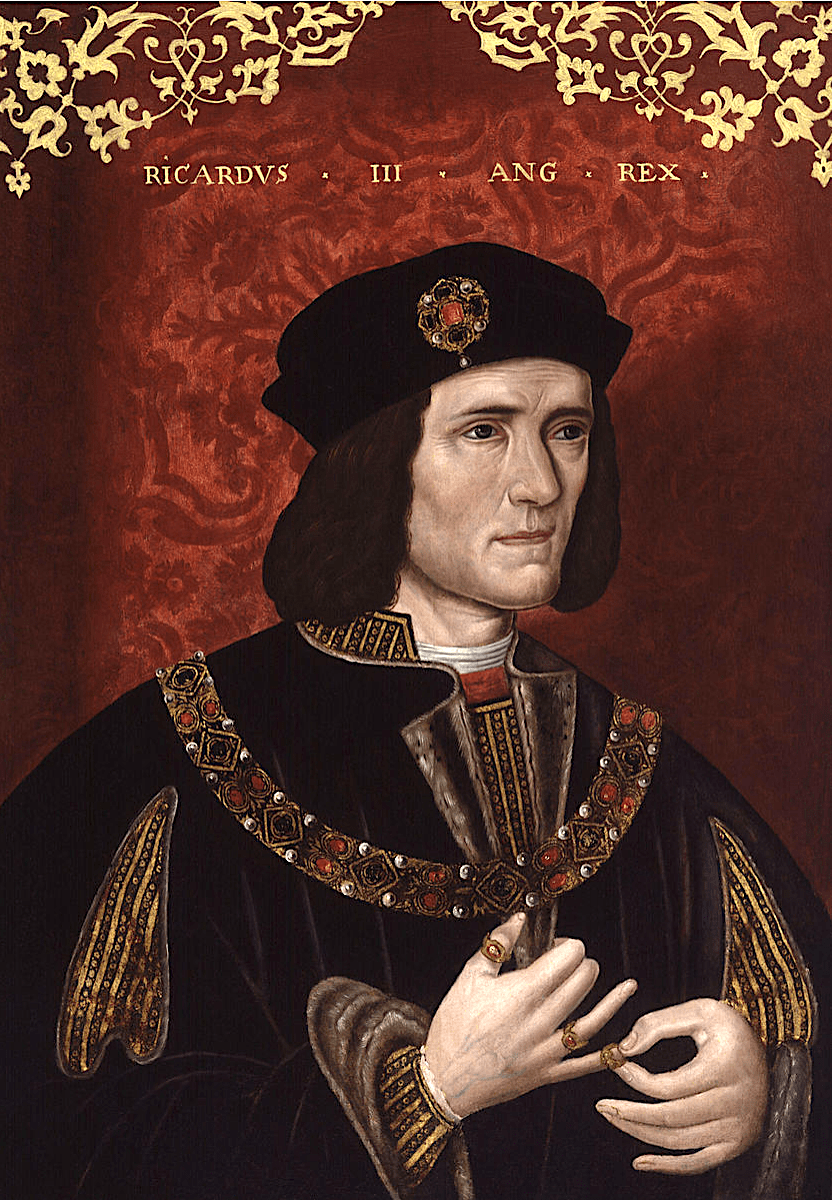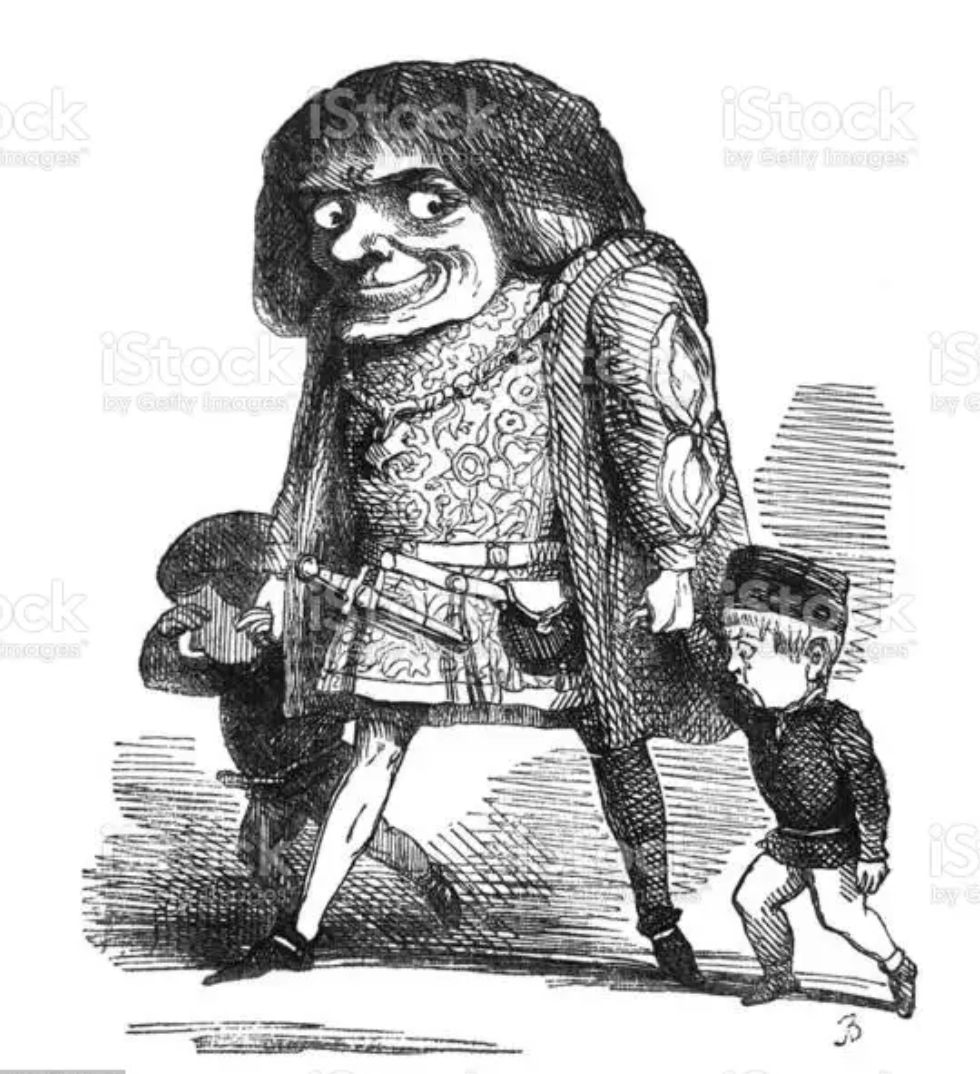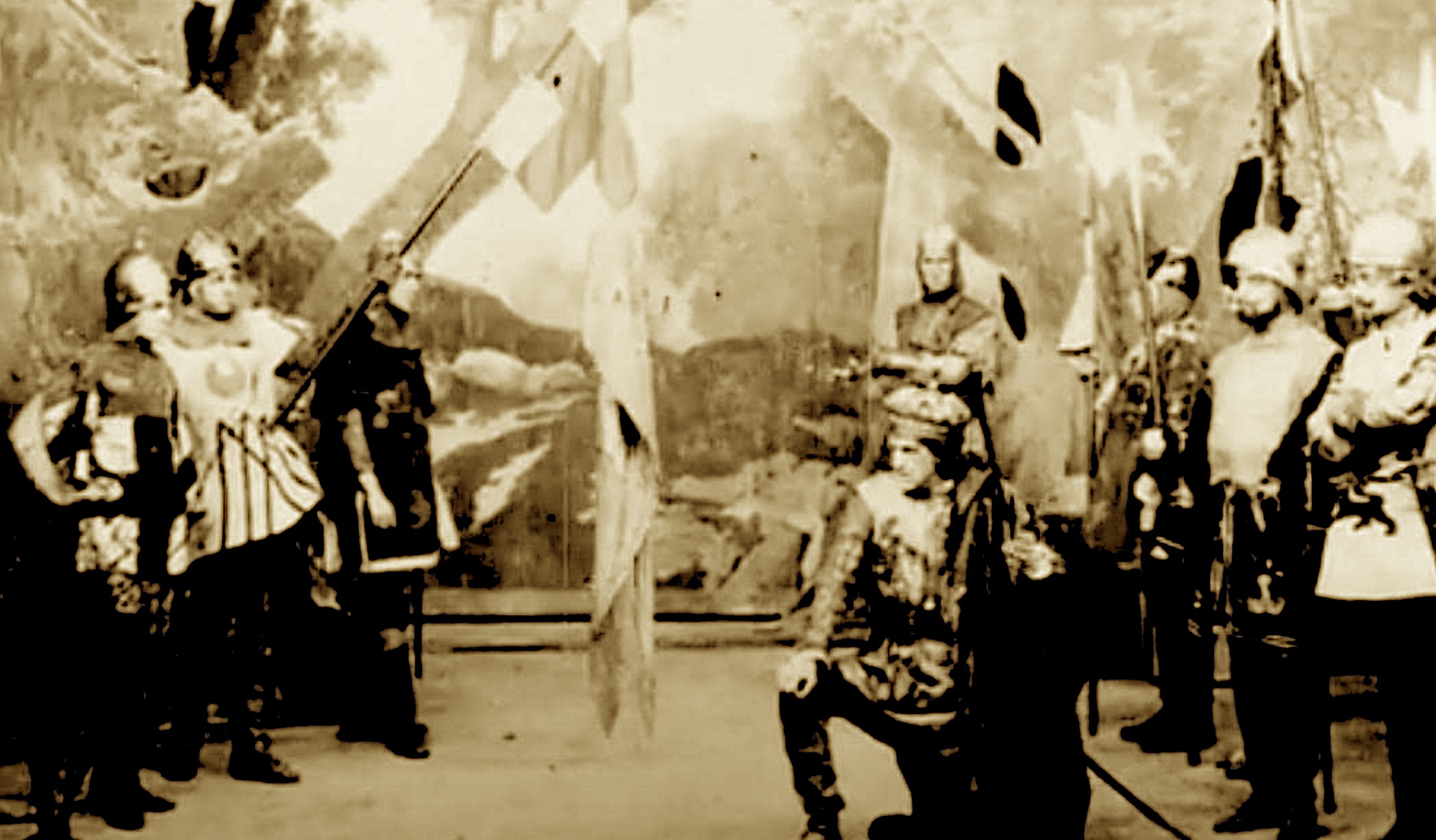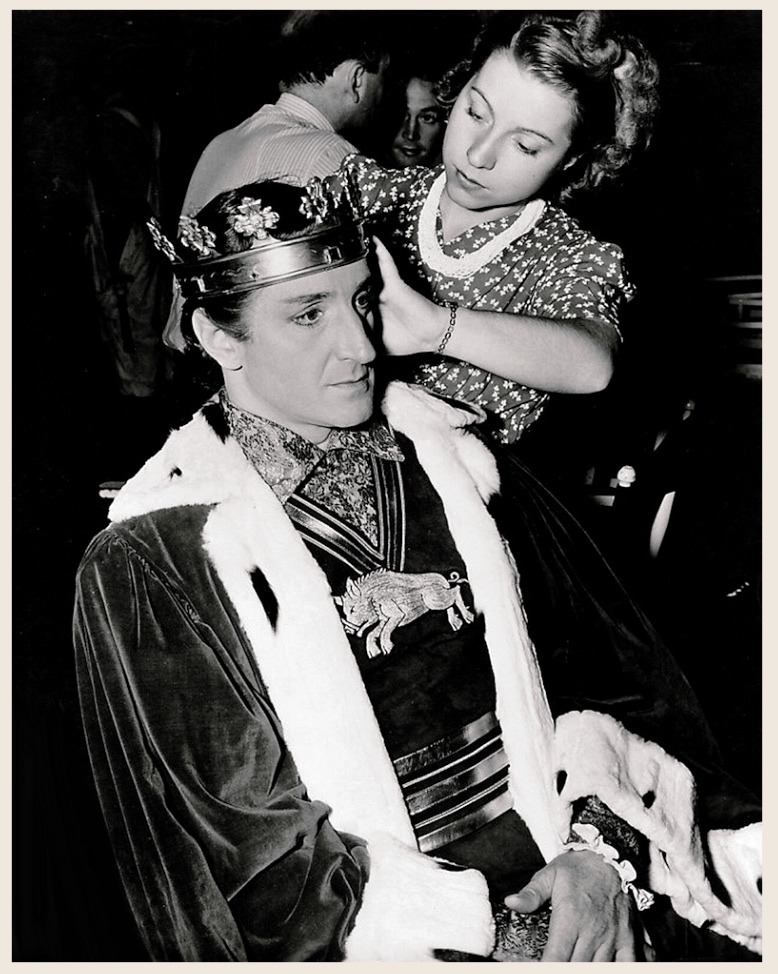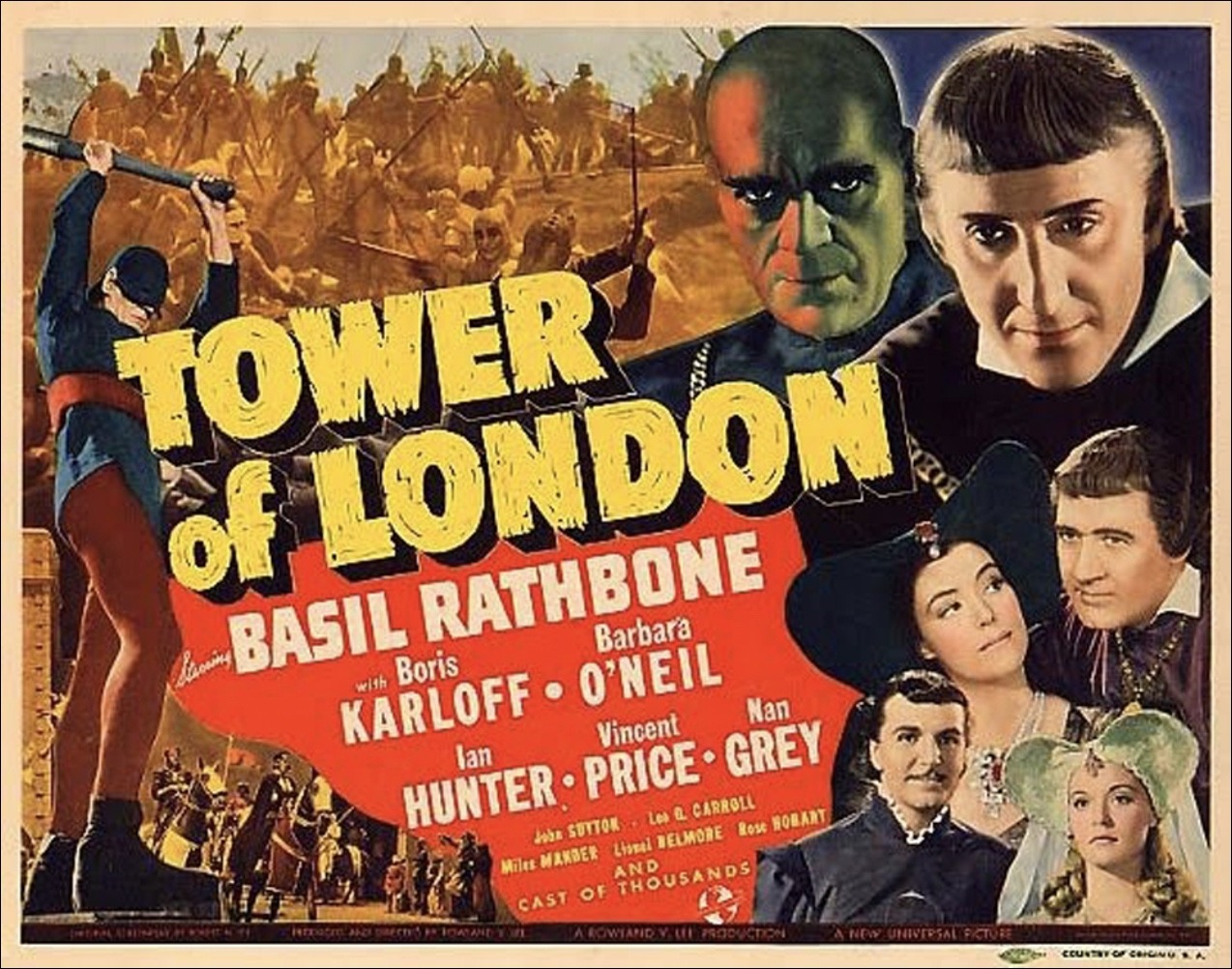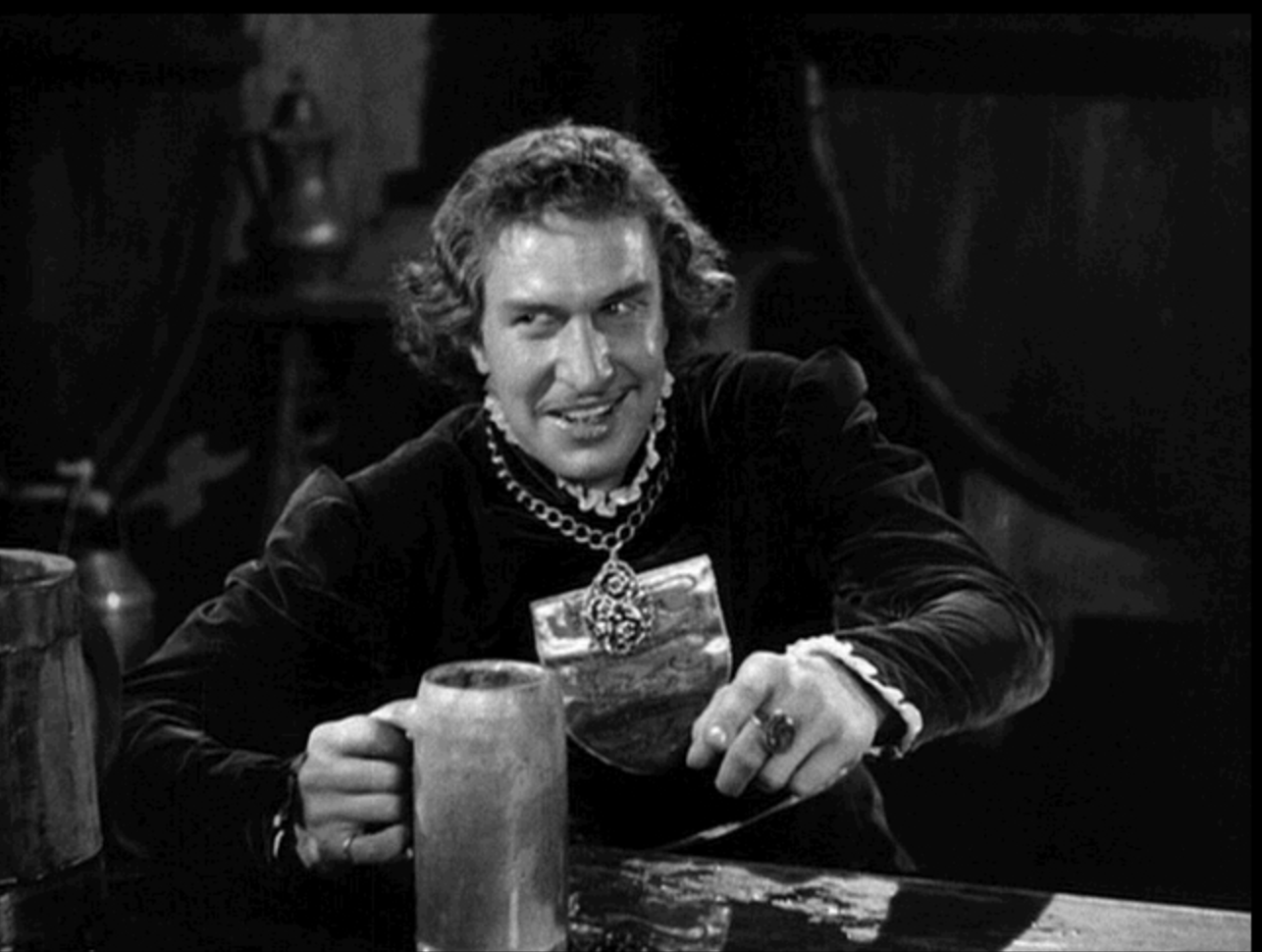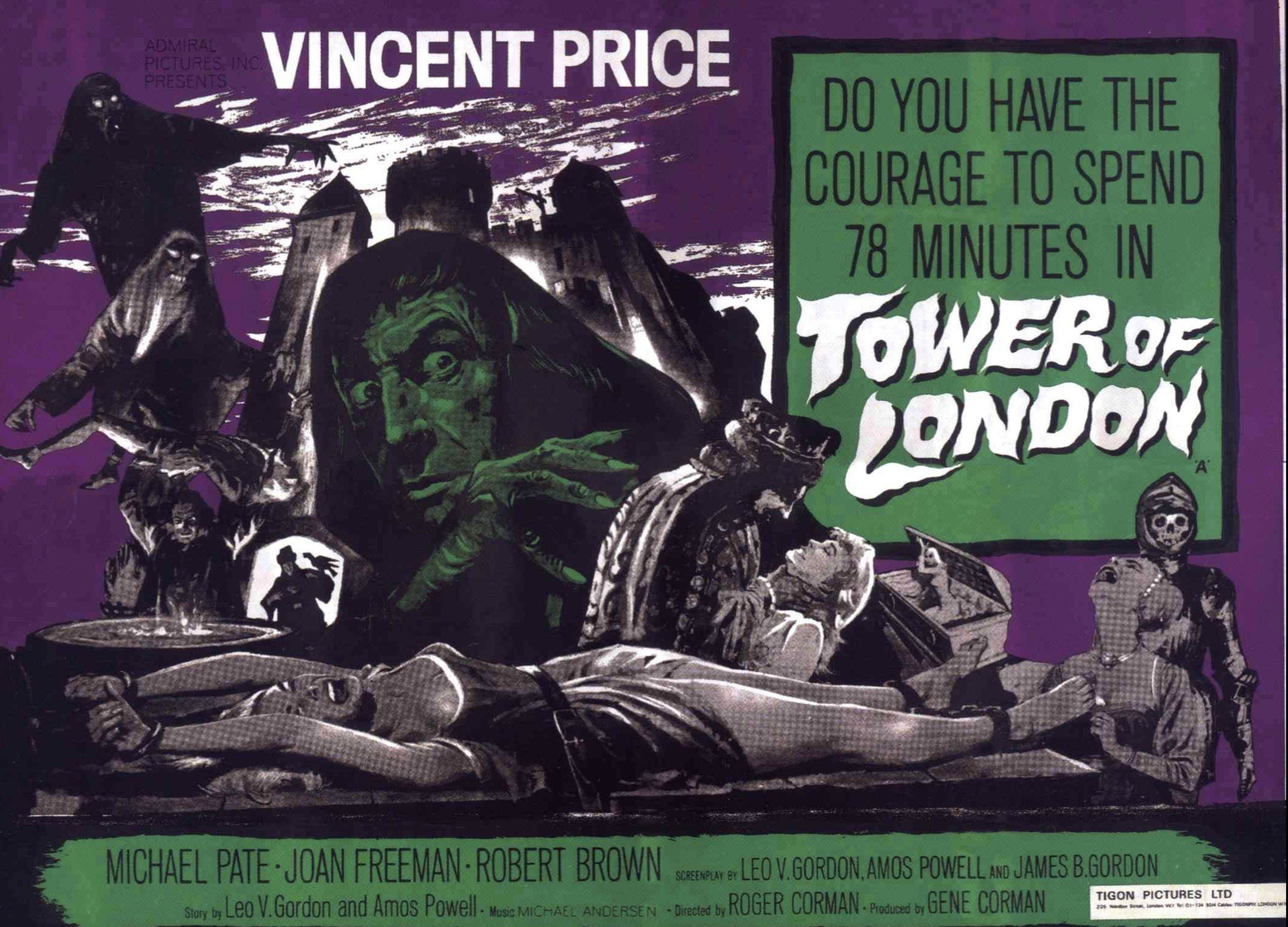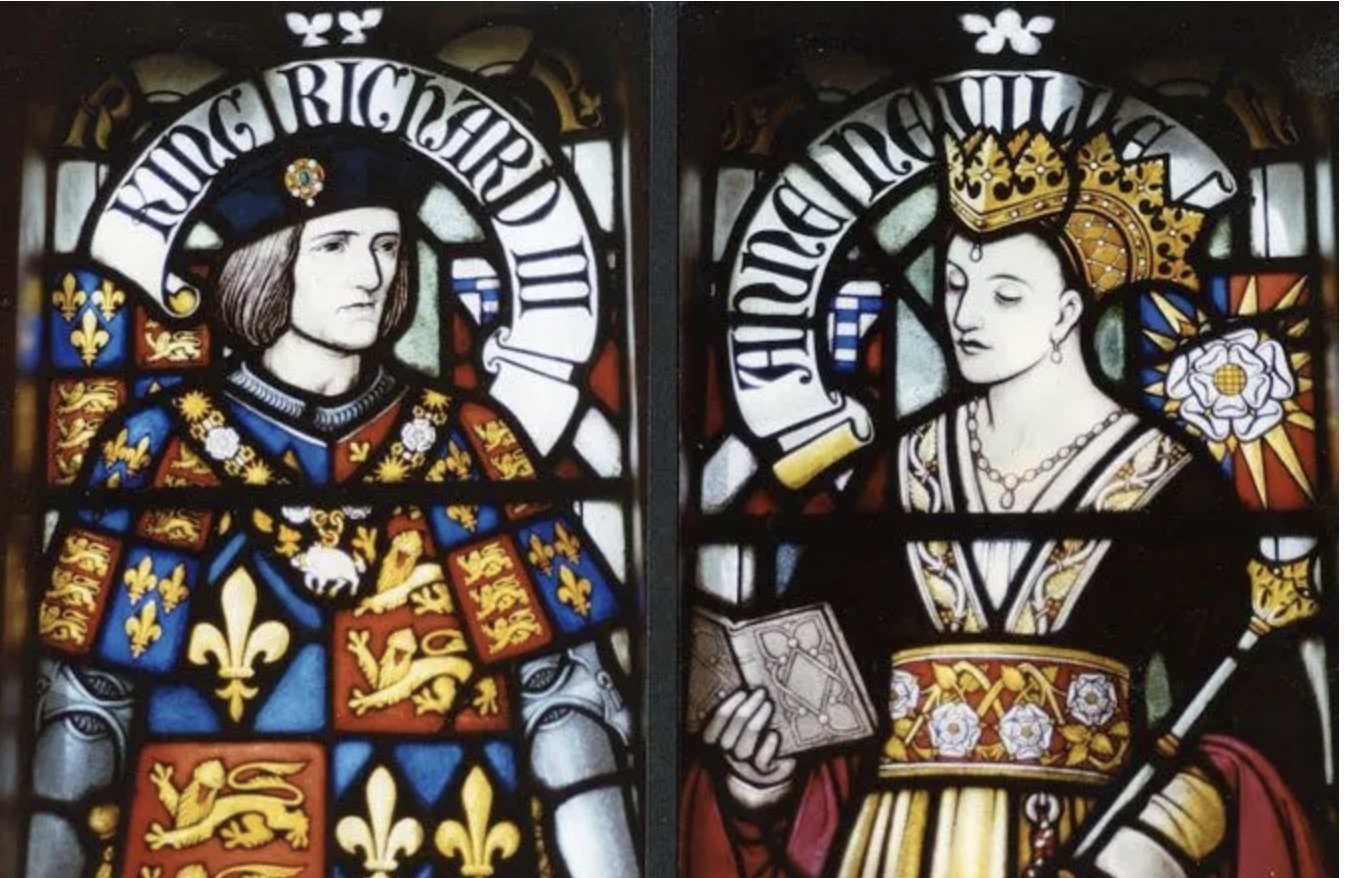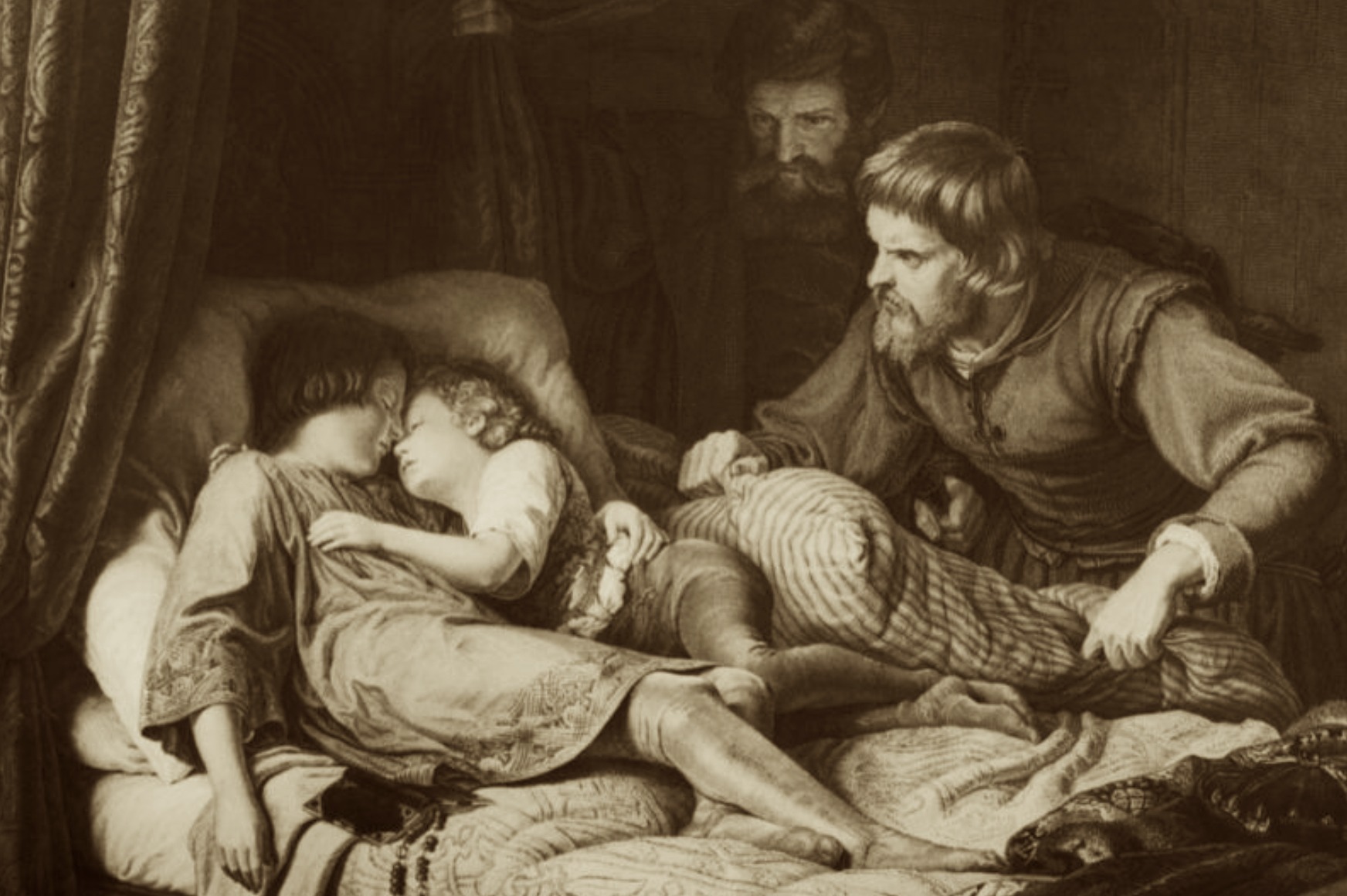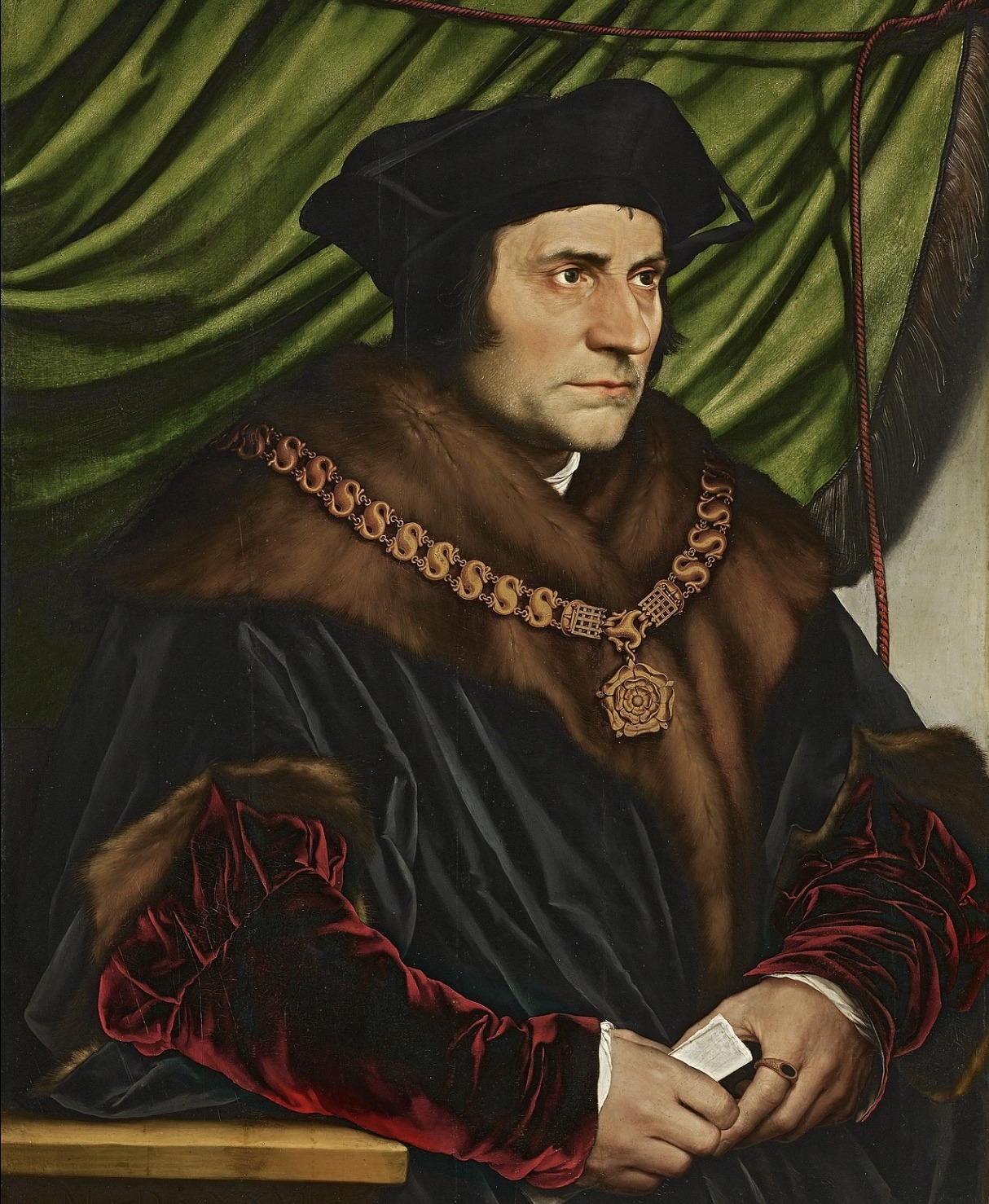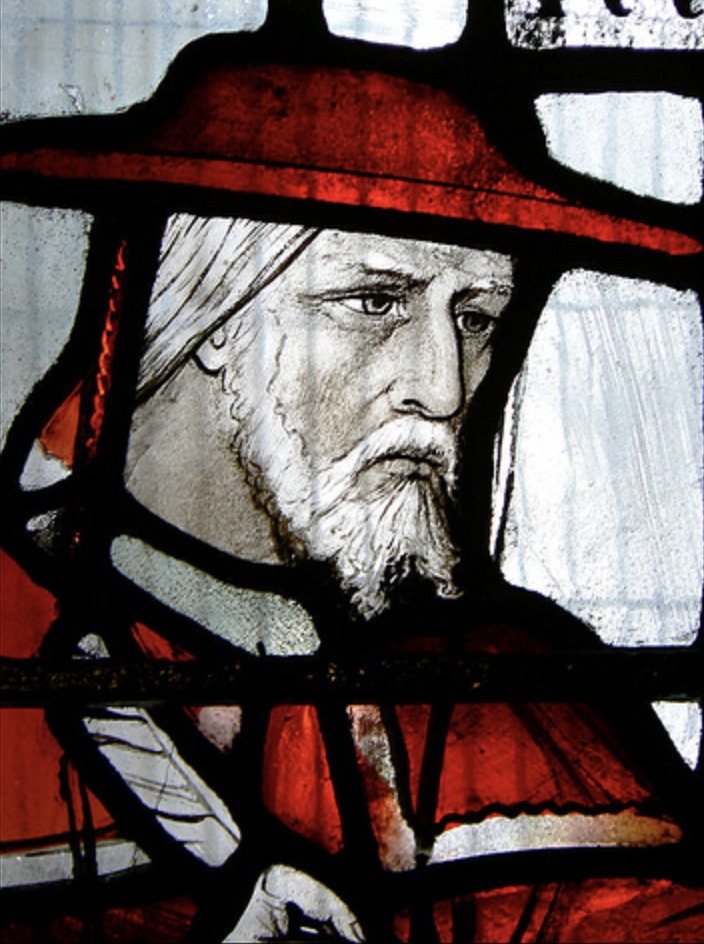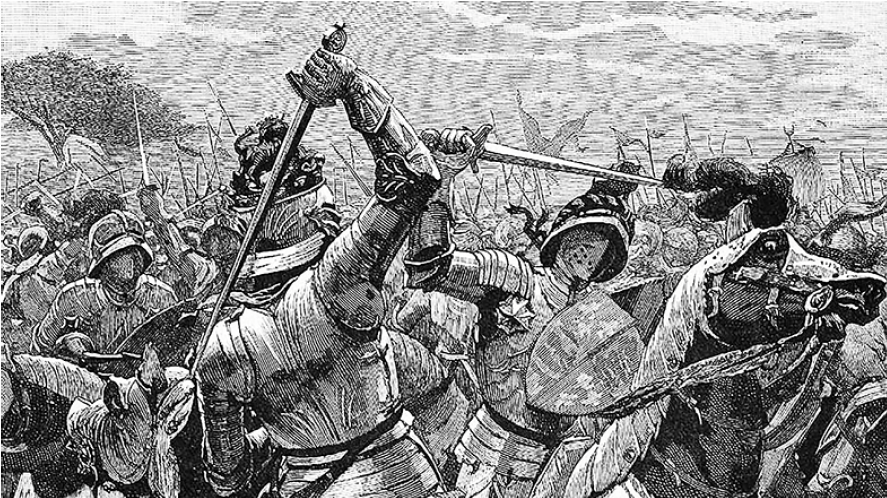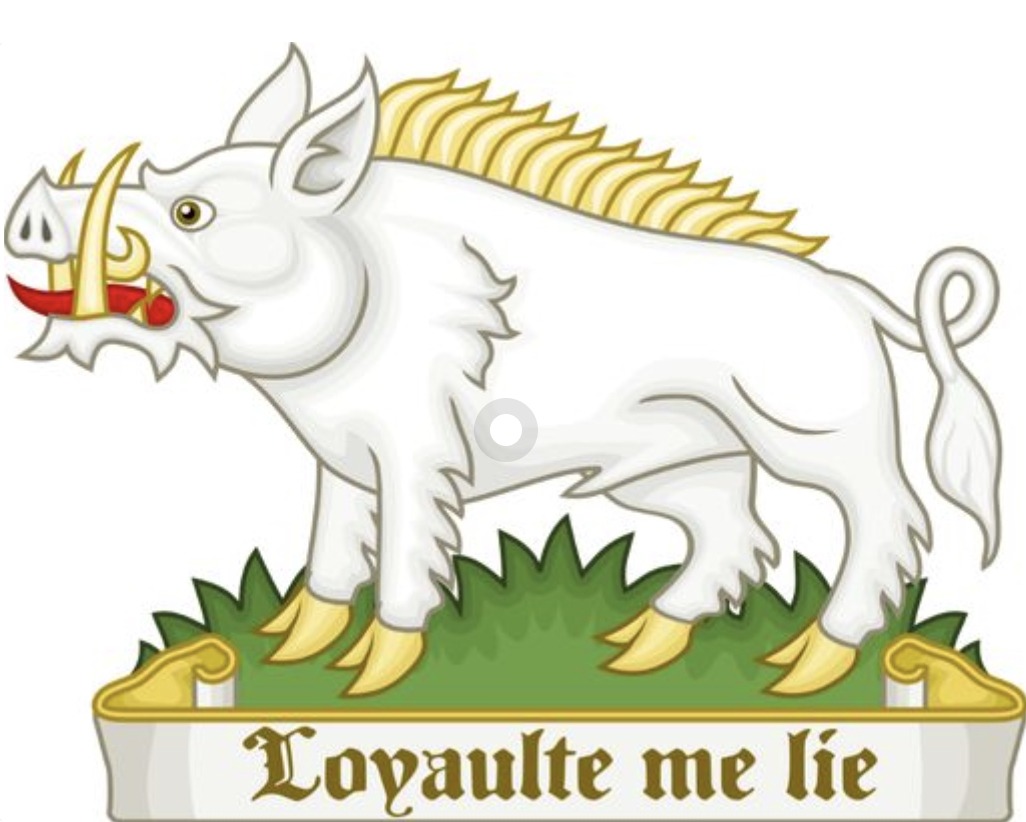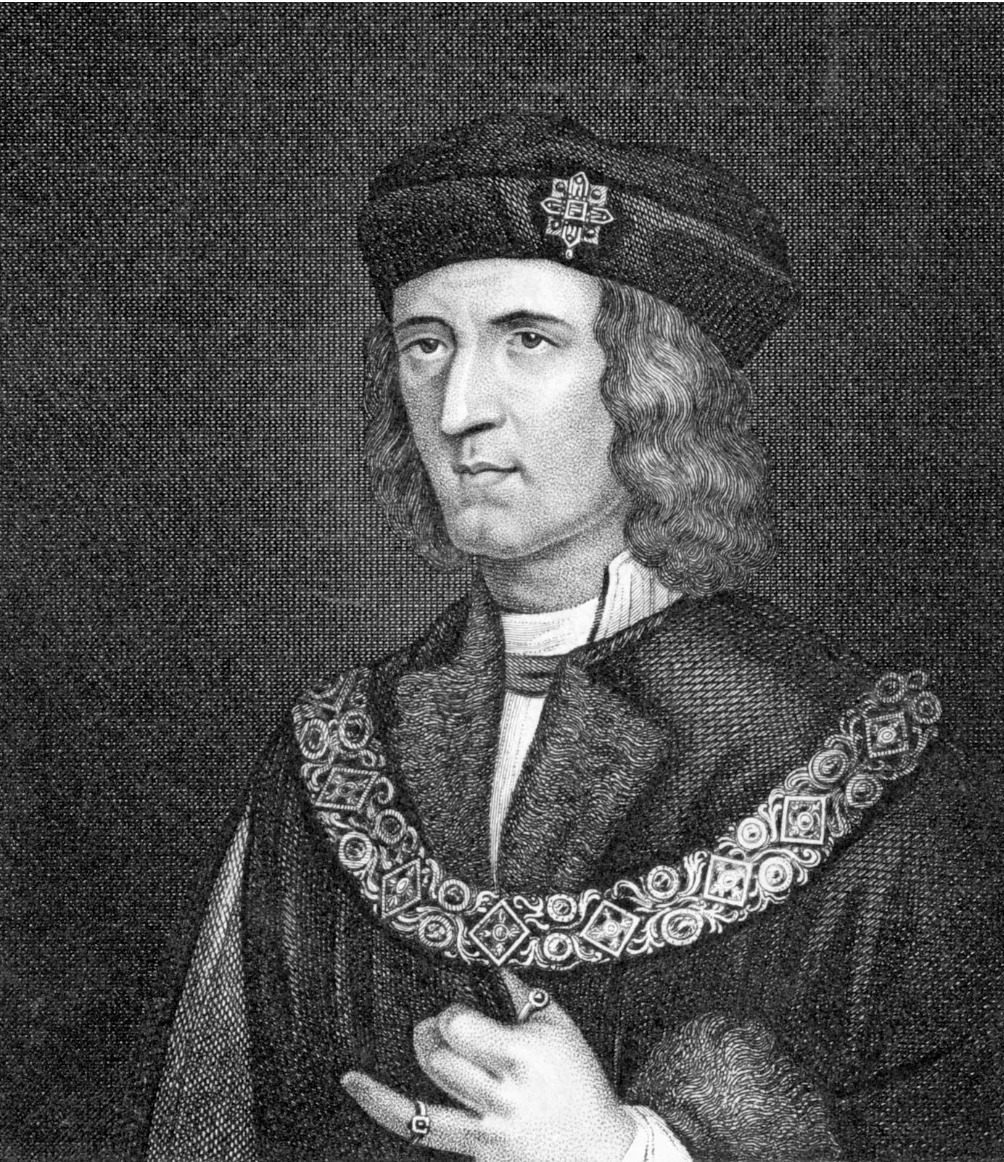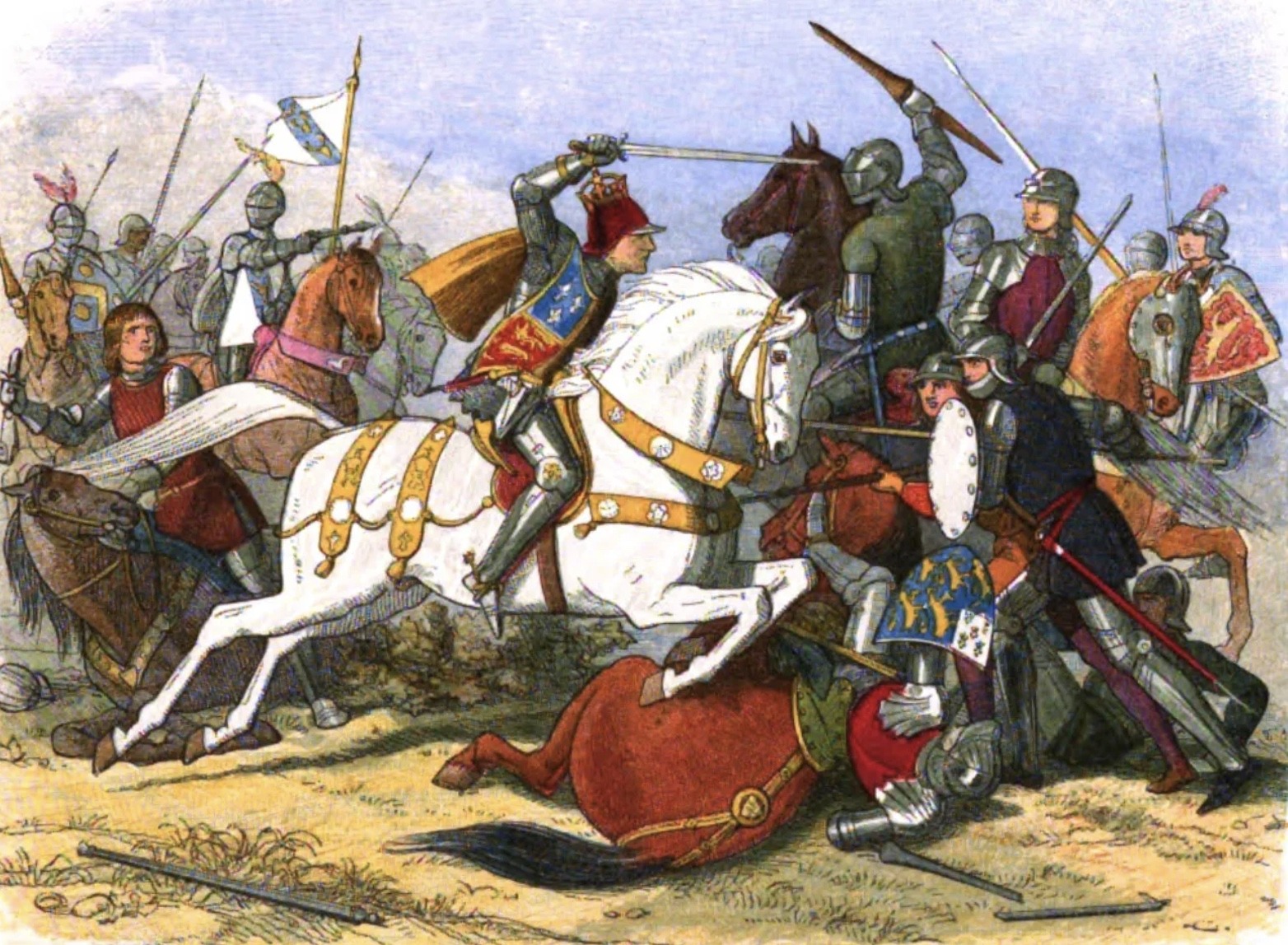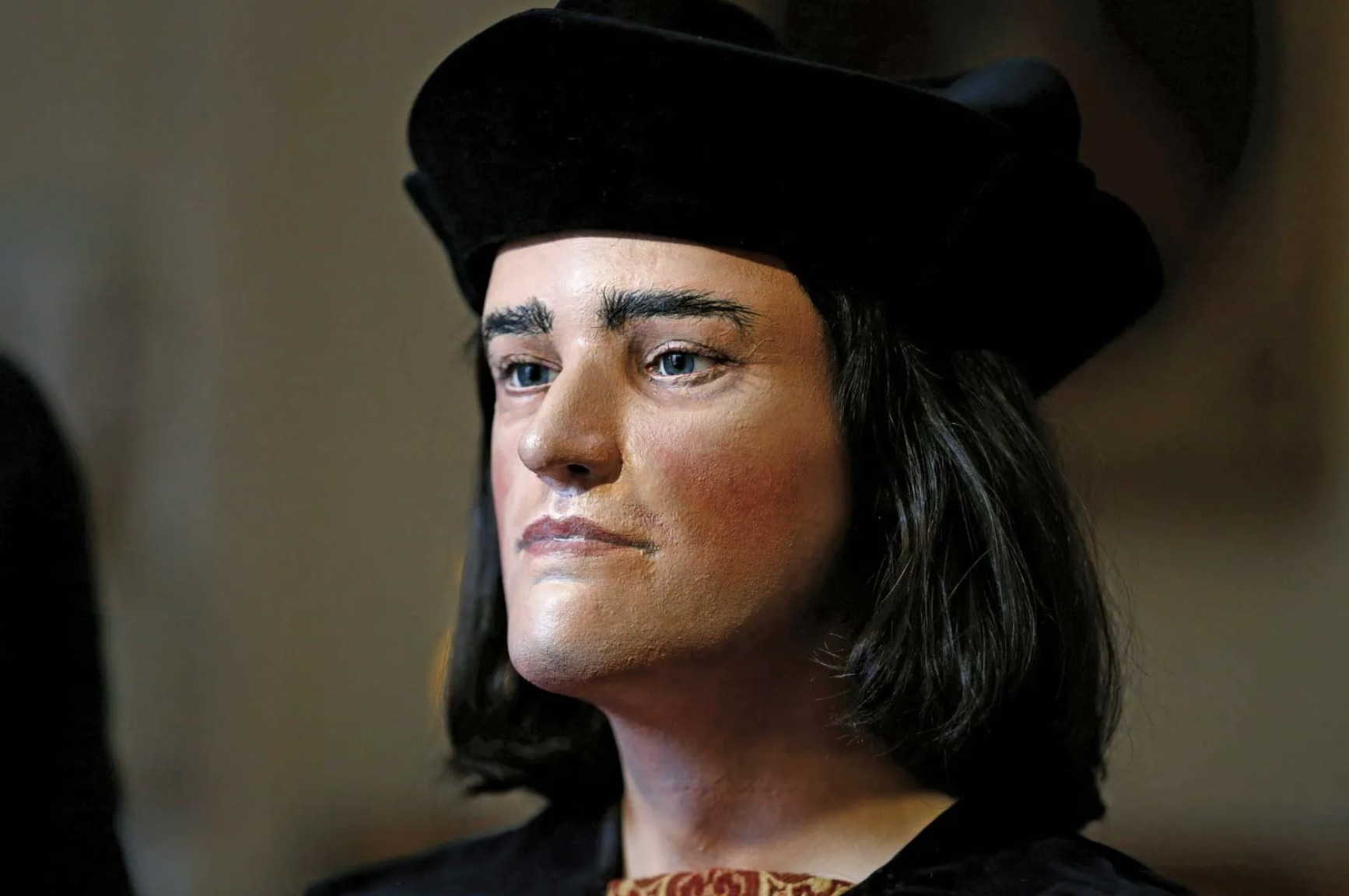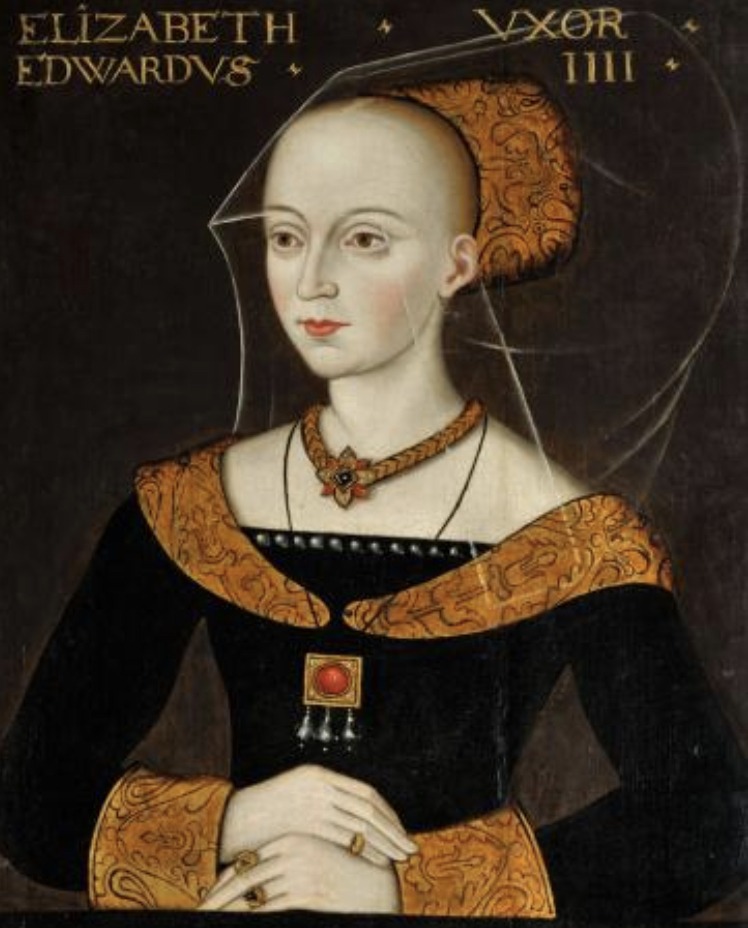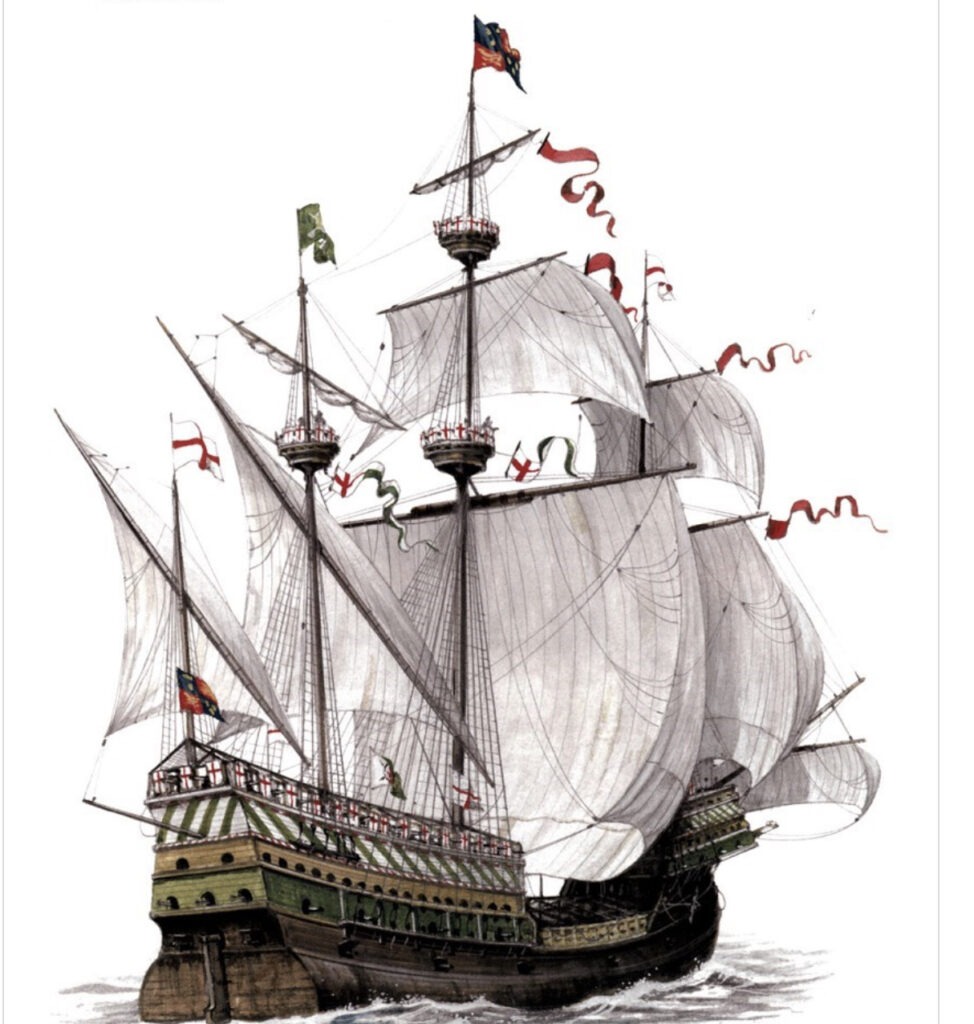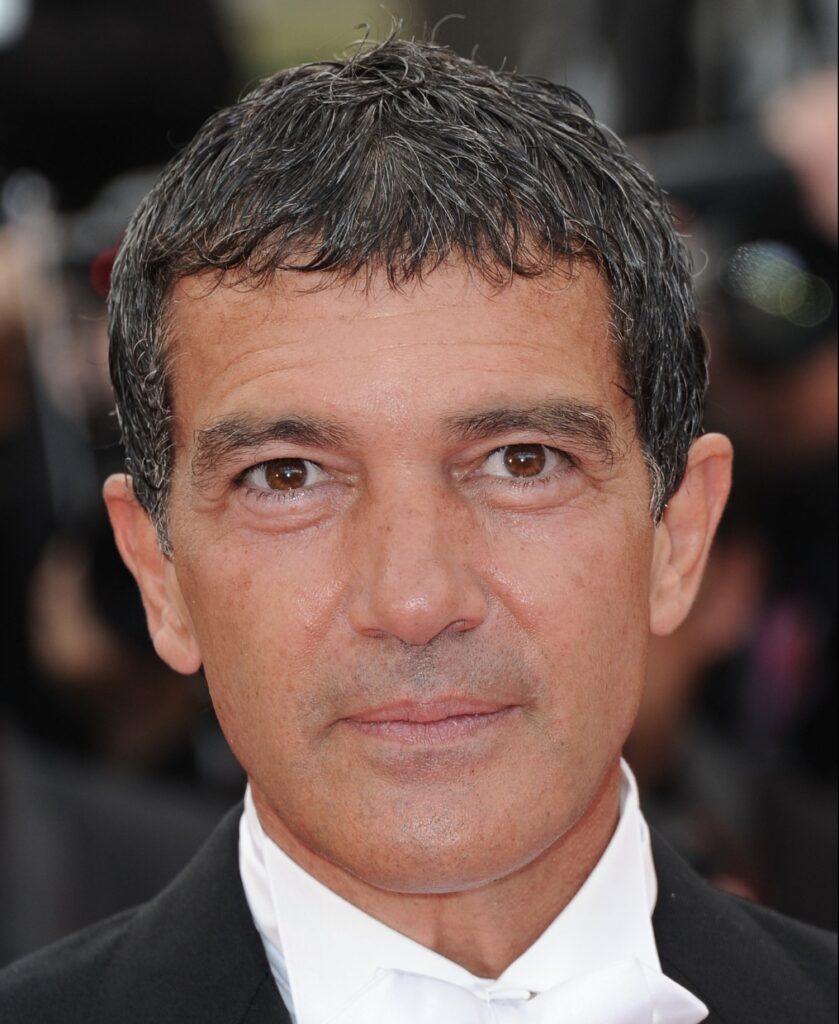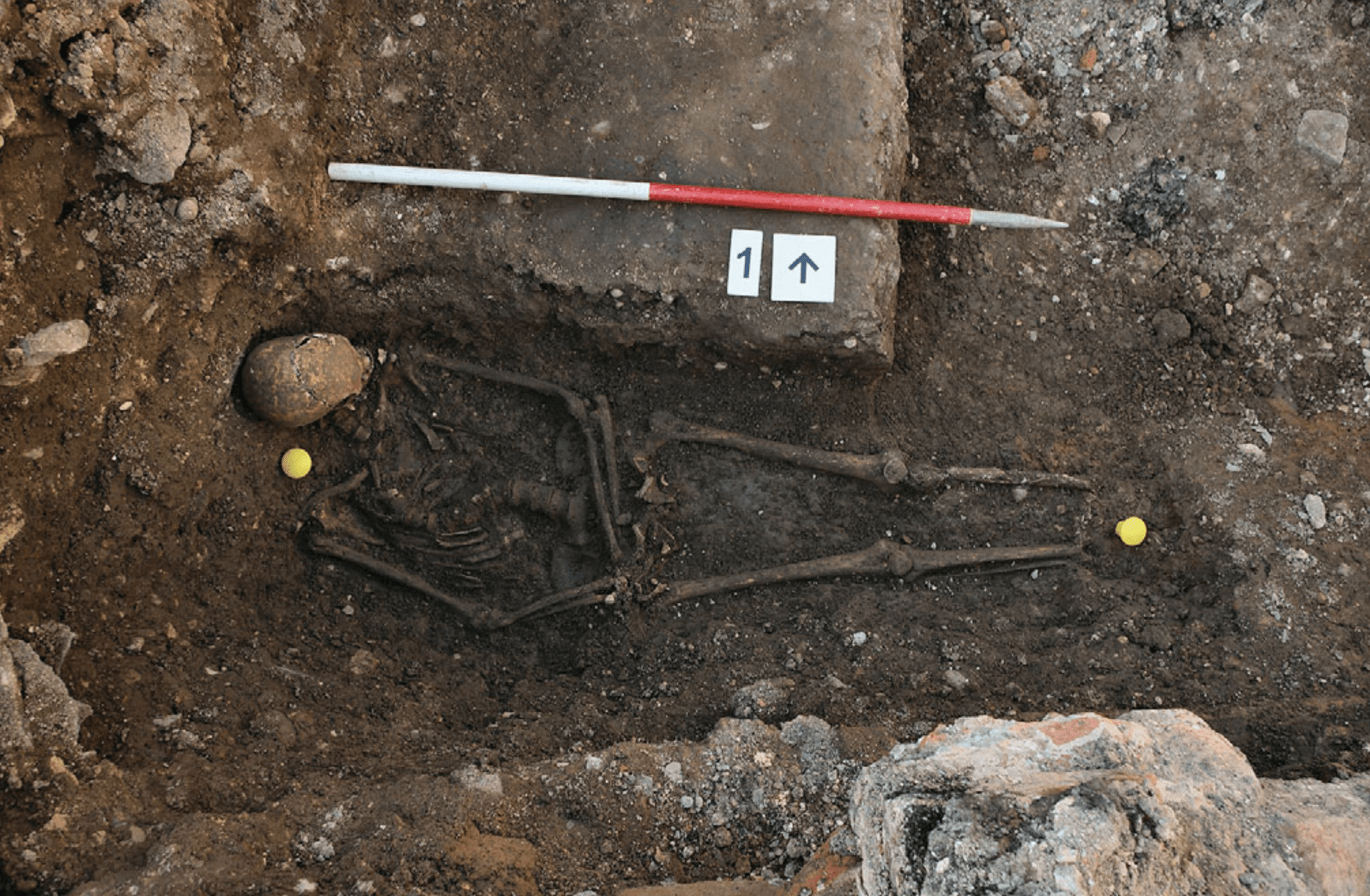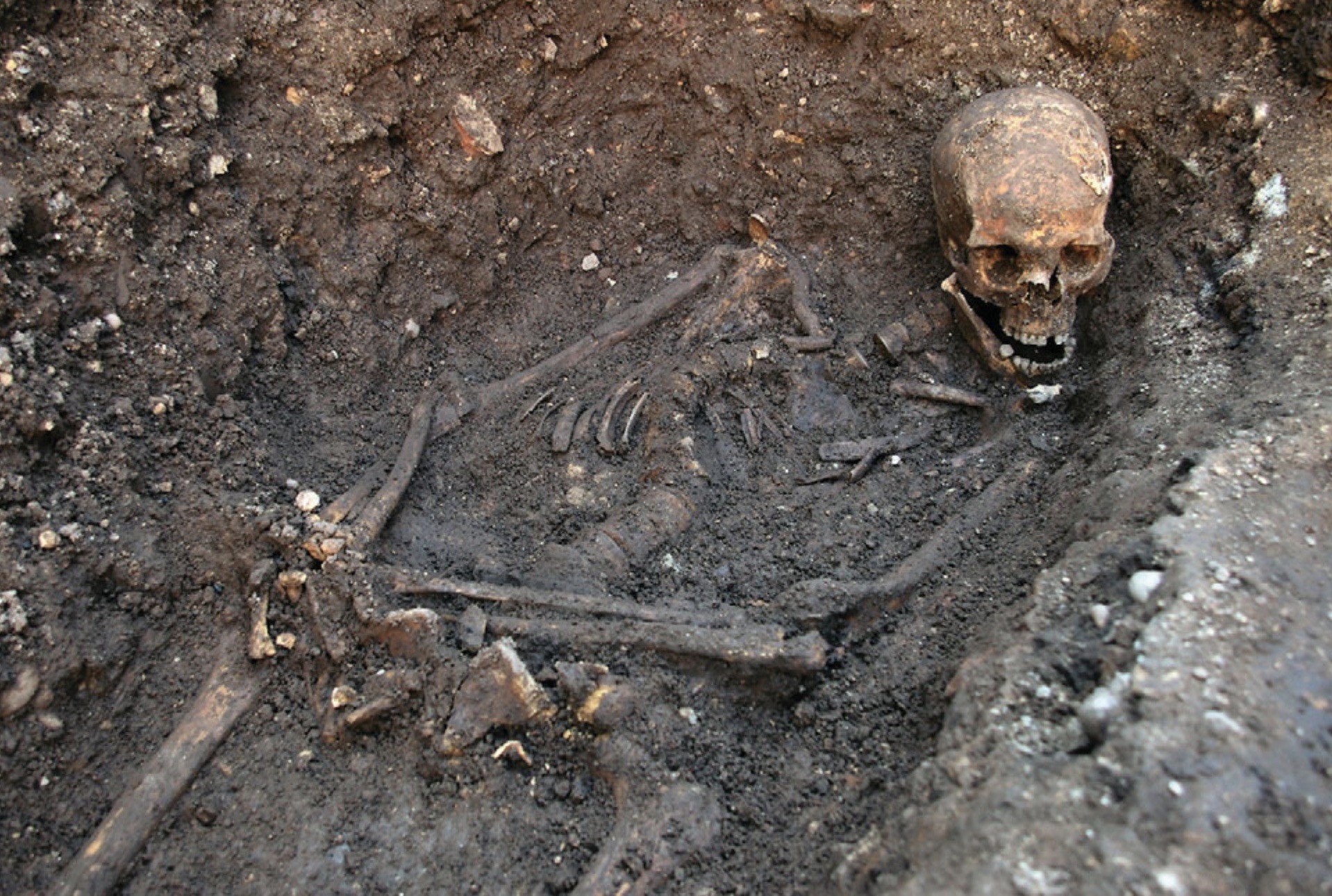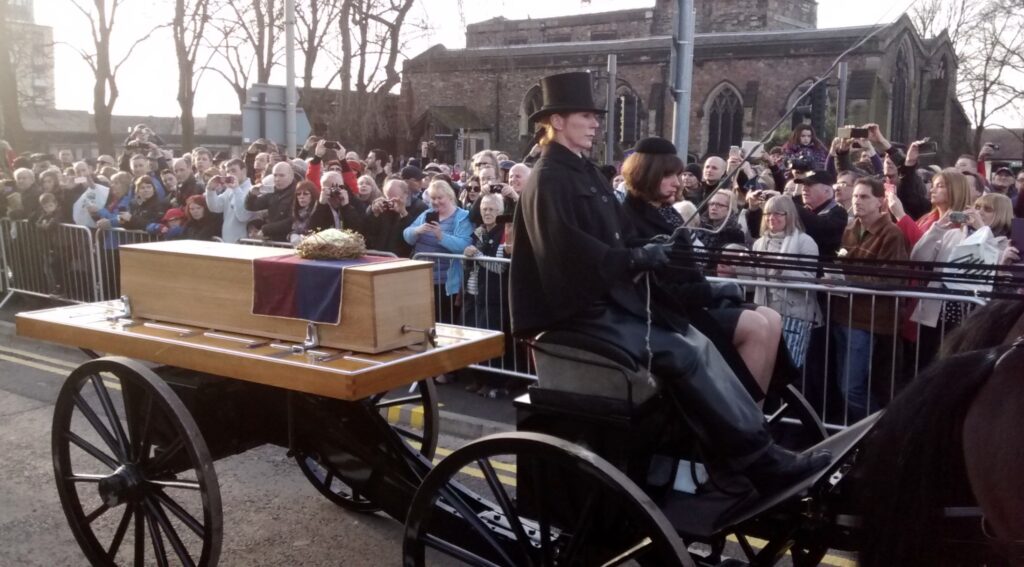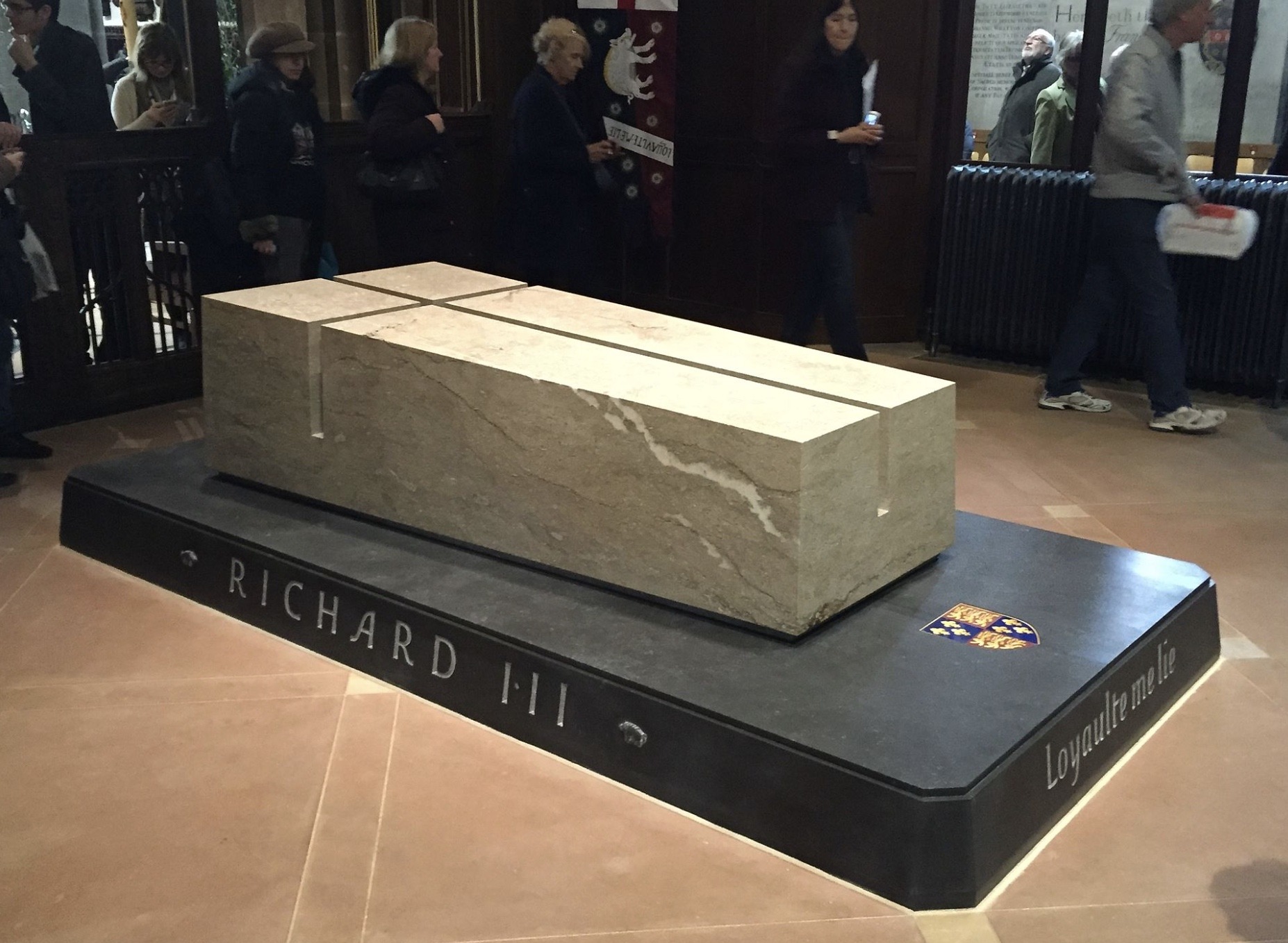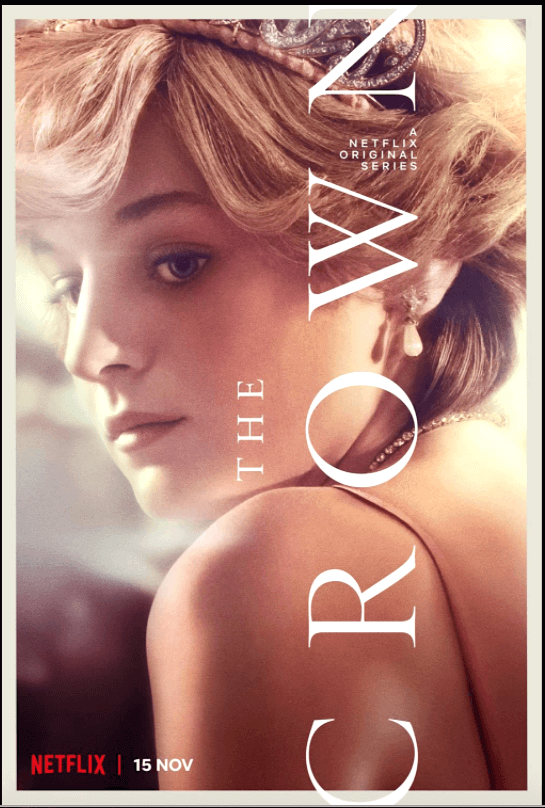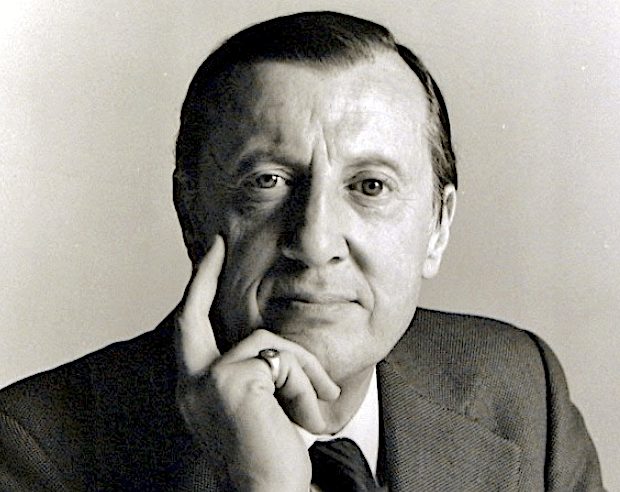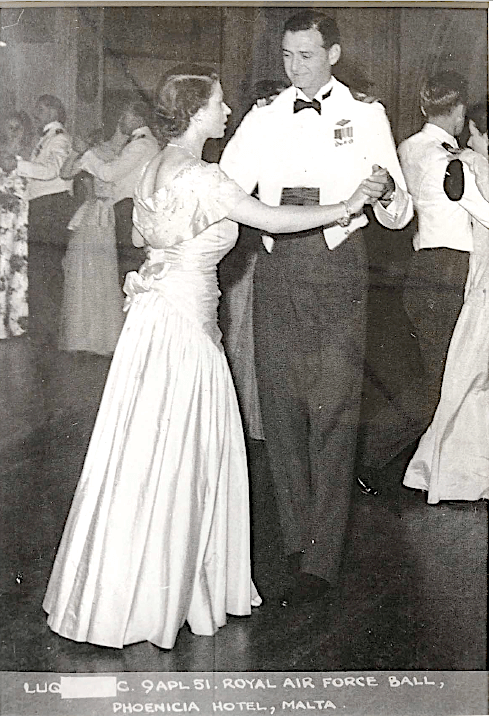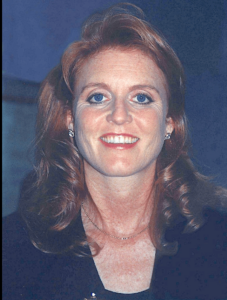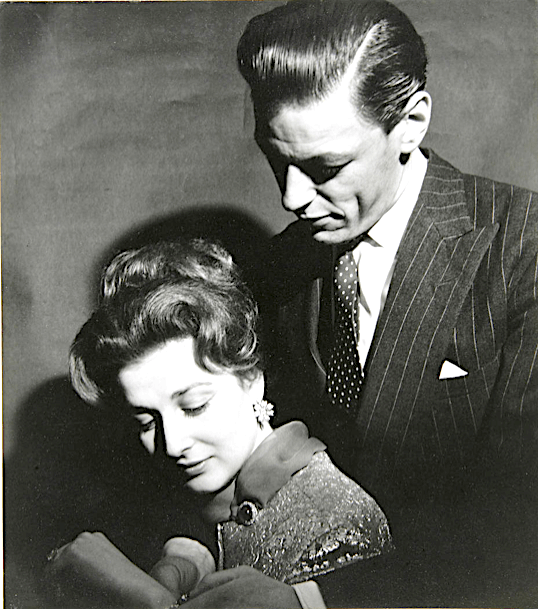FOREWORD:
American news anchor Tom Brokaw’s 1998 book ” The Greatest Generation ” popularized this term for the generation who enlisted in World War Two.
“It is, I believe, the greatest generation any society has ever produced.” Brokaw argued that these men and women fought not for fame and recognition, but because it was “the right thing to do.”
My father, whose formative years spanned The Great War and The Depression, was a member of “the greatest generation”. Like countless others he made a contribution to the war that saved Europe from Fascism.
This memoir is written not only to honor my father, but to honor all those who flew in World War Two, and all who fly today. My father loved to fly, as you will see. Through an account of his career, I offer a window on Royal Air Force life between 1930 and 1955, a crucial time in its history, and a portrait of an era that shaped the value system of the greatest generation.
My perspective was influenced by regular visits to the local Cinema where British and American WW2 movies were a part of regular programming.. I was 8 years old when my school showed its pupils “The Wooden Horse”, the story of a famous prison camp escape . I had no idea it was one of several in which my father was peripherally involved. But I would have to find that out from official records. He did not like to talk about the war.
CHAPTER ONE

My father taught me to swim when I was four. Here, in a picture taken by his younger brother Lloyd, we are leaving the shore of the Libyan coast outside Tripoli where my father commanded the RAF Base, Castel Benito. I was blessed with great parents who encouraged me in their different ways towards a life of fulfillment.
Eric Trenchard-Smith was born on June 15, 1910 in Australia, which had only four years before became a self-governing Dominion in the British Empire. While the new nation was sovereign in its domestic affairs, the United Kingdom maintained control over its relations with the wider world. Initially young Eric grew up in Manly, a coastal suburb of Sydney, in the east coast state of New South Wales.

This was the Manly Beachfront, where he first learned to swim and body surf. In the age before television and smart phones, the great outdoors was where kids entertained themselves.

Sixty years later, I would stage major scenes from “BMX BANDITS” all over Manly and the Northern Beaches in a private homage to my father’s birthplace, where his sense of adventure was formed.
Eric was the third of four boys born to Ethel and Oliver Trenchard-Smith, His father was a commercial traveller for Potter & Burke, a pharmaceutical company that represented Johnson & Johnson products. His salesmanship was impressive enough for the company to appoint him their New Zealand Manager, resulting in the family moving to Auckland when Eric was 12. The same year Eric contracted respiratory diphtheria. Sore throat, barking cough, swelling, made it Australia’s highest cause of infant mortality in the pre-vaccination 1920. As my father’s breathing difficulties became more severe, the family consented to a potentially risky procedure at the time – a tracheotomy, an incision in the throat providing a direct airway to the windpipe. I’m sure the experience had its impact on my father’s development. What does not kill you makes you stronger.

World War One, while tragically high in Australian (62K) and New Zealand (18K) casualties, had nonetheless been a boon for the Dominion’s rapid economic growth. Consequently, middle class income in 1922’s Auckland provided a good standard of living, particularly for a senior management executive. The Trenchard-Smith family bought a house in Epsom with a view of Mount Eden a mile away, and an adjacent clay tennis court where Eric learned a future social skill. The family raised White Leghorn chickens, and had an orchard of fruit trees; the boys had their toast spread with jam made from apples, guavas, nectarines, peaches, figs. There was also a walnut tree and a tomato tree. The home, as described my uncle Lloyd’s memoir, had an Angelus brand Pianola in the “sitting room” and a wind-up gramophone wired to a speaker on the large back verandah. The brothers could play Vitaphone dance records when friends came over. In the dining room, there was a six valve “wireless set”. Radio reception was not good till brother Ray and his father built an outside “aerial”. Two thirty foot timber poles were connected by a “scarf joint”, creating a sixty foot mast, the requisite height for reception. which was then embedded upright in the back lawn. Four cables tethered it to the ground. The radio had clarity thereafter. I admire the problem solving ingenuity of past generations.
The boys often walked 4 miles to school. Oldest son Ray was soon at University, youngest son Lloyd became his mother’s focus of attention, middle brothers Oliver Junior and Eric had permission to roam in the adjacent bushland by themselves taking a bag of food, ” a tucker bag”, and camp out for a night or two. Self-sufficiency and adventure was encouraged.

Potter & Birks’ business in prospered, enabling Oliver Trenchard-Smith to buy their first family car, not the one shown, but an equivalent brand new 1923 six cylinder five seater Buick with folding hood. Horse drawn transportation was the norm, as were bicycles and motor cycles with side cars. Cars were the province of the well to do. I cannot find an accurate sale price for a 1923 Buick but it could well have been half a year’s salary. I suspect Potter & Birks provided the vehicle for their chief sales representative in New Zealand within a year of his arrival, something Oliver Trenchard-Smith probably negotiated as a bonus for taking his family to Auckland, a city less developed than Sydney, Australia. Many along the Trenchard genealogical line dating from the 1100’s have displayed a flair for negotiation; thereby gaining wealth, avoiding execution, etc. Perhaps it’s in the DNA.

From 1925 owners had to register their motor vehicles. Soon there were more than 150,000 on the road. New Zealand had one car for every 10 people, second only to the US, and ahead of Australia and Britain, a reflection of the country’s rapidly developing prosperity.. At the age of 13, when his father was away, Eric taught not just himself but also his mother to drive. Licenses and road safety regulations were not introduced in New Zealand for another two years. His mother provided piano lessons for Eric who showed some aptitude although it was discouraged by his father as being an “unmanly” pursuit. My grandfather was by repute a difficult man, He would come home from weeks of business travel tired and expect calm and relaxation in the household. The two middle brothers were rambunctious teenagers. My grandfather beat Eric with a leather belt at age 12 for some act of defiance, according to his younger brother Lloyd, who overheard the encounter in the next room. According to my uncle Lloyd:
“Eric was the strong willed naughty brother and received many beatings from my father. My brother Ollie was gentle by nature. Eldest brother Ray was often the peacemaker when he thought my father was being a bit unreasonable towards Eric or Ollie.” Spare the rod, spoil the child was part of parenting culture in those days. but it did not take root with my father, who resolved disciplinary issues without ever raising a hand to me. Thus, he broke the cycle of corporal punishment embraced by his own father and generations before him.

My grandfather’s politics was politically conservative. anti- communist and racist. In his will he stipulated the disinheritance of any of his children who married a communist, a Jew, or member of the African or Asian races. This became an issue many years later when Oliver Trenchard-Smith’s second son Oliver Jnr. wanted to marry Renata Rebane, an emigre from Estonia. My uncle Oliver had a difficult time convincing his father that Renata, as a 14 year old had fled from the bloody Russian invasion of Estonia, and was therefore not a communist. But he prevailed. In 1966, I visited my aunt Renata and her 90 year old mother in Sydney. She told me of walking home through the fields from school one day past the bodies of people shot from a passing train. The White Russian/Red Russian War of 1918 -22 is a fascinating and neglected slice of geo-political history, hopefully to be explored in large scale streaming series, as History should. In that visit my father and I met Michael Romanoff, a purported Romanov cousin and leader of the White Russian community in Sydney, who had embraced Australian life. We body surfed with him after a picnic on Bondi Beach. Like Renata, he had lived through interesting times. Passions ran high. I include this White Russian propaganda poster because, well, I find propaganda art interesting. It can reveal more about the propagandists than they realize.

My grandfather wanted his son, who had a flair for computation, to train for 5 years as an articled clerk, then work for him as an accountant. This was not the life young Eric had dreamed of.

My father was a life long bird watcher, often taking field glasses on walks. There was something about the wonder of flight that fascinated him. To be the master of a machine that can emulate a bird, to be no longer earthbound, was an appealing concept to adventurous young men, and probably a greater reason for my father to apply to join the RAF than to avoid working for his father, with whom he “did not get along.” I did get along with my father, particularly from the age of 13, when I began discussing what I might do with my life when I left school. His advice to me was to find something I loved doing and get paid for it; advice I took. The nub of it was: follow your passion.My father had decided his passion was aviation, the new game changing development in transportation, barely a generation old. During the 1920’s, Australia, a continent 3000 miles from coast to coast, was obsessed with “Those Magnificent Men and Their Flying Machines.” Cinema Newsreels proudly featured the latest planes to an audience that “went to the pictures” once a week.

Aviation pioneers became celebrities. Sir Charles Kingsford-Smith became a household name after completing the world’s first trans-Pacific flight with Charles Ulm from America to Australia in 1928, an event recreated in the 1946 movie “Smithy”, or “Pacific Adventure” in the United States.

Sir Charles Kingsford-Smith and Charles Ulm standing next to their plane upon arrival in England in 1929. (National Library of Australia)
I know my father saw the 1927 Academy Award winning silent movie Wings, which contained the most elaborate aerial combat sequences yet filmed. This UTube trailer, (with added music and sound effects for a 2007 special screening which I attended) ) shows how how the young men of Australia and New Zealand were first introduced to warfare in the skies.
A glorious tournament of Knights, challenging gravity and the laws of physics. Hard to resist. But it was not the adrenalin rush of warfare that my father sought.
It was the joy of flight.
The Royal Australian Air Force had few planes and little need for recruits. But Britain did. In 1930, the British government, anticipating the hostilities ahead. offered short service commissions to volunteers from Commonwealth countries. Successful applicants would be trained for 3 years, receive a King’s Commission and return to their respective countries, Thus a talent pool of experienced pilots would be available to recall if the threat from Germany became real.
Thinking ahead, my father had, in his late teens enhanced his resume by volunteering while at university for the New Zealand Army, training part time as a bombardier with the 4th Field Howitzer Battery. When the Royal Air Force called for Commonwealth volunteers, Eric told his father that he wished to serve his country (Australians and New Zealanders at that time often referred to England as the Mother Country.) and join the RAF in the UK. He persuaded his father he would return in three years when his short service commission ended. How could a conservative anti-communist father stand in the way of his son’s sense of patriotic duty? My father applied, citing his brief military service, sailed to England in 1930 and was accepted. Listed as Smith, he is standing third from the right at the end of his first term at RAF Cranwell College Flying School.

As it turned out, he did not return to Australia after his short service commission expired. His rating as a pilot was listed as “exceptional”. He was given a full commission in the Royal Air Force and served for 25 years. reaching the rank of Wing Commander. His service record reveals a quiet achiever who successfully handled a variety of challenging assignments. He did not think he did anything remarkable. He just did his duty as best he could. So thought the vast majority of the Greatest Generation.
CHAPTER TWO – FLIGHT

My father and I enjoyed Those Magnificent Men on a giant screen of the Odeon, Leicester Square. As was commercially sensible for a big budget holiday season attraction, the movie played pioneer aviation for comedy.
In reality, flying a century ago was a hazardous business, and all those that undertook it knew the risks. It must have taken blind faith and a special kind of courage an to entrust your life to canvas stretched over a wooden framework, held together with wire, string. and a great deal of glue; but that was what the pioneer pilots were working with when war broke out in 1914, and aerial combat was developed.. Casualty rates were high. Below is a restored Sopwith Camel, Britain’s most successful WW1. fighter. It was credited with downing 1,294 enemy aircraft, more than any other Allied fighter in the conflict. A brief digression into the Camel’s unique characteristics will illuminate the range of risks pilots faced when they took to the air.

In the hands of an experienced pilot, the Camel was highly maneuverable, an essential quality in the relatively low-speed, low-altitude dogfights of the era. But she was quite challenging to fly, and especially during take off and landing,

This was an inevitable byproduct of the fighter’s design – critically small dimensions, high undercarriage, a narrow distance between the wheels; and notably the moving mass of the rotary engine. This affected the plane’s center of gravity, causing stalling or a fatal spin. In six months of 1917, more than a hundred accidents occurred involving Sopwith Camels, and thirty pilots were lost. Pilots who survived the severe flying school of the Western Front mastered the Camel’s eccentricities, and went on to become Aces.
1914 – 1918 were the infancy years of aerial combat. Pilots shooting at each other with pistols gave way to a gunner sitting behind the pilot with a Lewis gun on a swivel ring. He could only fire to the side, above or behind the aircraft, limiting options in a dogfight. What fighter pilots needed were guns that pointed at their targets as they pursued them. so twin machine guns were mounted in front of the cockpit, directly behind the propeller, shooting between the rotation of the propeller blades.

How, you may wonder, did the wooden propeller survive the fusillade of bullets? The solution was timing, as is demonstrated in glorious slow-motion by the Slo Mo Guys. At one minute fifteen seconds into their video, the Guys begin their demonstration.
OK. I’m going to get into the weeds here. While the video above is a joy to watch, it doesn’t touch on the real innovation behind what makes it work, the synchronization gear, which restricted the machine gun so it could only fire in between the propellers. This video gives a sense of the ingenious amalgam of wood, metal strut, and wire components involved in the Sopwith cockpit.
To take the risks involved, here, in the British currency of the day, is what the newly formed Royal Flying Corps paid their flying officers
Major: 32 shillings per day – Captain: 19 shillings, rising to 20 shillings per day after 1 year in the position + an additional 8 shillings per day flying pay
Lieutenant: 12 shillings per day + an additional 1 shilling per day for each completed year (up to a max of 16 shillings) +an additional 8 shillings per day flying pay; 2nd Lieutenant: 10 shillings a day + 8 shillings a day flying pay
Probationer: 7 shillings and sixpence a day plus 4 shillings flying pay
20 shillings made up a Pound Sterling. In 1918, a family needed 225 Pounds a year to live on. By the time my father joined Cranwell College in 1930, wages for graduate pilot officers were not much higher than in 1918. But the College offered room and board and the prospect of promotion.

The Royal Flying Corps had become the Royal Air Force in 1924. Cranwell College was founded to train future pilots. When my father sailed from Sydney to England to start training there, he met a New Zealander on board with the same intention. Regrettably, on his first flight, there was a mechanical malfunction and the man was killed alongside his instructor.

The RAF Archives list more than 100 pilot fatalities in 1931, a dozen in flight training. This seems to be the accident referred to.
ANNING, Anthony Frederick Paul, F/O – Killed 13 February 1931 in an Atlas, Cranwell Cadet College; loss of speed on a gliding turn during approach for a practice forced landing. He was instructor.
ACTON-ADAMS, Arthur Moreland, New Zealander; Flight Cadet – Killed 13 February 1931 in an Atlas, Cranwell Cadet College; loss of speed on a gliding turn during approach for a practice forced landing.
Crash landings and collisions on the airfield were not uncommon as pilot training expanded beyond trainer experience. This luckless fellow caused both his plane and a hanger to burn down.

Below are the remains of an Armstrong Whitworth Atlas and an Avro Tutor after a fatal collision at No.3 Flying School, Grantham in June 1931.

MARKBY, Jack Eugene, F/O – Killed 30 October 1931 at Hucknall in a Tutor of No.3 Flying Training School, Grantham. Member of No.504 (County of Nottingham) Squadron. He was pilot of the aircraft.
McHARDY, Louis, F/O – Killed 30 October 1931 at Hucknall in a Tutor of No.3 Flying Training School, Grantham. Member of No.504 (County of Nottingham) Squadron.
The RAF Archives continues with reasons for this accident.
“When the machines were over the Squadron hangar one got into a bump and rocked from side to side. When the pilot found that he was underneath his leader’s machine he turned away and his top left plane caught the leader’s tail, causing it to fall off. The leader’s machine continued for a few seconds and then dived onto the aerodrome. It was twisted right round as a result of the collision. The jury returned a verdict of ‘accidental death’ and attached no blame to anyone.”
Flight report of court martial (issue of 20 February 1931) included the following:
“W/C R.D.G. Small said that the regulation about distance between machines flying in formation was very seldom carried out. It was much easier to fly in tight formation than at the correct distances and intervals. According to evidence, both machines got into bumps near a hangar. P/O Angell in his evidence said that he could not control his machine in the bump. He was not aware that there had been any impact until he landed. His machine was less than half a span away from the other. The court acquitted Angell after a brief retirement.”
Pilot Officer Angell, himself, aged 21, was killed a month later when his Siskin 111A hit a tree while low flying.
An RAF career had its perils, even in peacetime.
CHAPTER THREE – TRAINING TO FLY
For the first year, RAF Cranwell grounded the cadets in the fundamentals of aviation, combined with military life coaching, and a dash of college education.


Cadets were instructed in English language and literature; mathematics, engines and the theory of flight; mechanics and draughtsmanship; wood and metal work; elementary science; and the use of the wireless: map reading; military drill; PT; sanitation and hygiene. Here they are learning Morse Code.

The second year was when the cadets were taught to fly, including the use of a compass and machine gun while flying. The working day started at 6.45am, when the cadets were woken. There was a parade at 8am (even on Saturdays), after which the cadets marched off to lectures, workshops, drill or other activities until 12.30. From 2pm until tea at 4.30, there were more organized activities. After tea, there was more study preparation. Cranwell was both an educational and a military institution, with military protocols dominant. There were daily kit inspections Cadets had lay out their kit on their bed in a very precise manner. If the instructor wasn’t happy, he might tip the whole lot onto the floor and tell the cadet to start over. Precision was important in aviation. But as military boot camps go, RAF Cranwell was pretty mellow.

Flying instruction started with a demonstration of a plane’s working parts. Here students study a rear aerelon, a hinged flight control surface on the trailing edge of each wing, that controls the roll of the airframe, or effects maneuvers.

Flying instruction began with an initial period of dual and solo work in fundamentals of take off and landing, stalls, spins, forced landings and maneuvers. It was followed by a “diversified” phase to include acrobatics, accuracy approaches, “strange field landings”, My father’s favorite among the trainers was the Tiger Moth. Considered “easy to fly, difficult to fly well”, the RAF found the Moth ideal for training fighter pilots. It had a top speed of 104 mph. a low stalling speed, a ceiling of 14,000 ft. and a range of 300 miles. It was an ideal aircraft on which to learn aerobatics. Once my father was cleared for solo flying, he enjoyed looking down at the countryside gliding by below from the open cockpit of a Moth, while navigating by following railway lines; it’s a view still enjoyed by the pilot of this restored Tiger Moth.

The original Tiger Moth cockpit seems cramped. Being over 6 foot tall my father probably found all cockpits cramped.

The upright shaft at the bottom of the frame is the joystick. As described in this subsequent training manual for monoplanes, the joystick controls the attitude of a machine: to raise or lower its nose, to produce bank to left or right and to turn the nose of the machine to left or right in relation to the horizon. The pilot maneuvers the joystick with his hands and the rudder with his feet. (No shit, Sherlock). I love old training manuals.

Before a pilot could take off, the wooden propeller had to be swung by hand. This potentially hazardous task was carried out by ground crew, or by the pilot himself. Once swung, the tip of the propeller blade suddenly went from zero to 320 feet per second; plenty to take off a hand, smash bones, or split a skull clean in half. Hand propping accidents were not uncommon. They still occur today.

Pioneer aviator Elsie Mackay demonstrates the stance she adopted to stay clear of the propeller arc. Practitioners were instructed to grip the trailing edge, using as little of the fingers as possible, then swing the blade like a golf club, at the same time twisting your body away from the propeller as you ‘follow through’. That reduces the risk of ‘banana fingers’…

Sadly Elsie Mackay’s prominent aviation career was cut short in 1928 when she and her copilot attempted to fly a single engined aircraft across the Atlantic in bad weather. Like Amelia Earhart, her body was never found. The dark side of aviation – death, dismemberment and an unknown grave – were risks that flying school cadets accepted. Accidents were a factor at Grantham and other training centers.


I don’t know if my father was amongst these hardy Cranwell College cadets on parade in the snow. but he was among the graduating cadets at a ceremony presided over by “the father of the Royal Air Force”, Sir Henry Montague Trenchard, 1st Viscount Trenchard, who had been given an hereditary peerage for his service to military aviation. He had founded Cranwell College in 1920.

A brief digression on the family name: Trenchard was derived from the Old French word trenchier, meaning to cut, hack, slice. This became a generic term for a swordsman, soldier, man of war, or butcher. Norman knight Roul de Trenchard fought in the Battle of Hastings in 1066. The first recording of the Trenchard name in the UK was on a deed of land granted by William the Conqueror to Paganus Trenchard, witnessed by his grandsons, for services during the conquest of England. The Trenchard descendants, traced through Church records of births and deaths from 1143 onwards, were frequently servants of the state: burghers, sheriffs, judges, knights, politicians. Sir John Trenchard earned his knighthood by fighting on the winning side of the Wars of the Roses. A subsequent Sir John Trenchard became Secretary of State to joint monarchs William and Mary in 1692.
Here’s how I come to share the Trenchard name. On August 4, 1803, Miss Elizabeth Trenchard married Mr. Robert Smith. When their son William was born, he was christened William John Trenchard-Smith. In order to preserve the Trenchard lineage, they fused the family names. William’s son Edward Trenchard-Smith sought his fortune in Australia. He was my great grandfather.
Trenchard emigrants also prospered in America. George Trenchard became Attorney General of West New Jersey. His son Edward Trenchard commanded ships in the US Civil War, ending his career as a Rear Admiral. It seems there is a strong martial element in the Trenchard DNA, and Sir Hugh Montague Trenchard is a prime example.

Viscount Trenchard, as he would become, was certainly an example of the British bulldog breed of Empire Warriors. A bullet to the chest during the Boer War lost him his left lung and caused partial paralysis in his legs. Recuperating in Switzerland, he took up bobsled racing, resulting in a crash that cured the obstruction to his spine, enabling him to return to the Boer War, leading mounted infantry. He survived 6 years of active service in Nigeria before tropical disease forced his return to England. While convalescing, he thought about the future of military power in the air, as yet untried. Concealing the fact that he was partially blind in one eye, he took flying lessons for 10 days and received a pilots license, though he was not particularly gifted and never instructed flying. Administration and political savvy was his real skill, which he demonstrated as commander of the Royal Flying Corps in France during World War One, where he pioneered strategic bombing. After the war he was knighted and became Chief of the Air Staff. In 1920. He founded Cranwell College in 1920.

Here is Viscount Lord Trenchard, on the eve of his retirement as Marshall of the Royal Air Force, inspecting the graduating pilot officers. Trenchard’s nickname in both the Service and Whitehall was “Boom” for “his stentorian utterances and low rumbling tones”. I’m not sure in what tones Lord Trenchard spoke to Pilot Officer E.T. Smith at their brief meeting, when he said ” So, you are from the Australian branch of the family ?”

When my father entered Cranwell College, the name Trenchard was legendary in the RAF. For him to continue to use his full family surname Trenchard Smith that had been hyphenated in Australia since 1860 would have invited regular questions as to how he was related to the Father of the RAF. Something my father wanted to avoid. He did not want to seem to be trading on a famous name. So he uncoupled the joint surname, making Trenchard his middle name and Smith his surname. (He would recouple the surname 25 years later when he retired from the RAF.) But Viscount Trenchard had done his homework on each graduating pilot and noted noted the middle name of Cadet Eric Smith. (Third from the left.) My father probably came to his attention because his rating as a pilot at flying school was “exceptional”.
 Nine months after leaving flying school my father was back as an instructor. He would in due course become an instructor of instructors in the training of pilots. He would earn a nickname “Expert Eric”. During his 25 year career, my father flew every new plane that came his way, from a Sopwith Camel to a Vampire jet. His RAF log book recorded flights in over 80 different types of aircraft. As part of an exercise, my father learned to land a plane on an aircraft carrier. The weather was not great, the seas choppy. On his approach he could see the carrier’s deck yawing. But a happy landing ensued.
Nine months after leaving flying school my father was back as an instructor. He would in due course become an instructor of instructors in the training of pilots. He would earn a nickname “Expert Eric”. During his 25 year career, my father flew every new plane that came his way, from a Sopwith Camel to a Vampire jet. His RAF log book recorded flights in over 80 different types of aircraft. As part of an exercise, my father learned to land a plane on an aircraft carrier. The weather was not great, the seas choppy. On his approach he could see the carrier’s deck yawing. But a happy landing ensued.

Photographs of many of the types of planes he flew in the early to mid 1930’s can be seen in this fascinating website.
https://glostransporthistory.visit-gloucestershire.co.uk/royalair30.htm
CHAPTER FOUR – THE GATHERING STORM

By 1933, a German fringe politician named Adolf Hitler, previously viewed as a rhetorically skillful clown with a violent following, had gained traction with the electorate aggrieved by the harsh terms of the peace treaty imposed on Germany at the end of World War One. Guided by Josef Goebbels, his chief propagandist, Hitler recorded a widely distributed phonograph album – think today’s podcast, sold in shops on vinyl – in which his strutting antisemitic rants at rallies were replaced by an almost Chancellor like demeanor. Households across Germany listened to a message of national pride and resurgence. Corporations and conservatives believed Hitler would protect their money. Socialists believed Hitler championed the working man.

The text states: “In the deepest need Hindenburg chose Adolf Hitler for Reich Chancellor. You too should vote for List 1.”
To end political instability, rival German power brokers appointed Hitler Germany’s Chancellor, believing they could control him. One of Hitler’s principal political backers wrote:“We box him in. Within two months we will have pressed Hitler into a corner so tight that he’ll squeak.”
Yet, Hitler would would outwit them all and start a world war that wrecked Europe and killed tens of millions.
Hitler’s rise and fall is a factor in my father’s story and the evolution of the Royal Air Force. It’s important to understand what the greatest generation was fighting against. After the Nazis achieved power, Goebbels wrote “ The big joke on Democracy is that it gives its mortal enemies the tools to its own destruction.” Authoritarianism remains the mortal enemy of Democracy. The war is eternal. Today it is being fought in Ukraine.

The danger Hitler posed was evident to former cabinet minister Winston Churchill. He was out of office at this time, considered a passed over war hawk. His 1934 speech, reproduced here with illustrations on Utube, eloquently outlines the issues.
Hitler’s intention to persecute Jews was now out in the open. On a street in Worms, Germany, the antisemitic propaganda newspaper Der Stürmer (The Attacker) posts its headline: “The Jews Are Our Misfortune.”

“Interracial relationships” between Jews and non-Jews were prohibited under the Nuremberg Race Laws. Citizens were encouraged to report suspicions of the “crime” of interracial relationships to the police.

Other morally repugnant social experiments were being instituted. The Nazis coined the term “Mercy Killing” to describe the involuntary euthanizing of the sick, elderly and disabled. This propaganda poster from the 1930’s gives the high cost of caring for such people as a fundamental justification for euthanasia.

” 60,000 Reichsmarks is what this person suffering from an hereditary defect costs the People’s community during his lifetime. Fellow citizen, that is your money too.”
These propaganda posters further point to transactionalism at the heart of Nazi ideology. Here, amplified by a racist trope. The caption from a Nazi propaganda film strip shown to Hitler youth says: “Mentally ill Negro (English) 16 years in an institution costing 35,000 Reichsmarks.”

God’s Will has always been a useful emotional manipulation. Here it was applied to euthanasia and forced sterilization. The caption reads: “…because God cannot want the sick and ailing to reproduce.”

Churchill’ saw the gathering storm ahead. His warnings of Nazi plans for European domination were ignored by a government deeply affected by the horrors of the Great War. Conflict with Germany was to be avoided at all costs. The new Chamberlain government did not invite Churchill into the Cabinet. opting for a policy of appeasement.
Churchill did what he could behind the scenes. He had taken flying lessons (not a good pilot apparently) and was a friend of Lord Trenchard, the father of the Royal Air Force, who shared his views. Although retired from the RAF, and currently in charge of the Metropolitan Police, Trenchard frequently used his platform as a member of the House of Lords to loudly voice his opinion on RAF matters. He knew Germany was secretly developing civilian planes convertible to military use. He pushed for was a massive bombing force as Britain’s best deterrent. His advice, like Churchill’s, was ignored. But it did jolt the government into recognition that the RAF, as Britain’s first line of defense, should be modernized and pilot training expanded. As a result my father trained to fly at RAF Cranwell, to which he returned as an instructor within 9 months of graduation.
An artist captures a flight of Hawker Furies flies over Cranwell after a snowfall.

Having graduated in September 1932, and sent back to flying school, now Acting Flight Officer E.T. Smith began his duties as an instructor. His full rank would be confirmed a year later. The RAF offered to extend his three year short service commission to six years. At that point, if his service continued to be satisfactory, he would be granted a permanent commission. That would be his dream come true. He started learning the capabilities, and limitations of every different plane that came his way. New models of fighters, bombers, transports, seaplanes were being delivered to RAF bases across England and all Commonwealth countries. RAF needed pilots who could fly a variety of planes, and instructors who could work across the board. There was a shortage in both categories. It seems my father’s love of flight had combined with a flair for instruction.

Instructors trained with a variety of specially modified dual control aircraft. This two seater Avro Type 621 Tutor was a simple but rugged basic trainer, frequently a student pilot’s first experience of the skies. My father spoke fondly of the Tiger Moth for its maneuverability. By 1935 the RAF trained about 300 pilots a year, with plans to increase the strength of the Royal Air Force by 1,500 aircraft by 1937. Cranwell College developed this teaching aid for twelve pupils at a time.

Once pilots had achieved a level of confidence in the air, training progressed to instrument flying. To simulate conditions of zero visibility, this RAF Miles Magister had been adapted for blind flying training. The pilot in the back seat pulled the hood over his cockpit and focussed on his instrument panel.

An instructor sat in the front cockpit, to check the accuracy of the flying and watch out for other aircraft.

Once they had their wings, all pilots learned the packing and use of the parachute, should it be necessary to bail out. Practice jumps from a tower approximated the speed of descent, and taught pilots how to land. Flight Officer Smith took the parachute course, training that would prove useful some years later.
Active service was ahead.
CHAPTER FIVE – POSTED TO INDIA IN 1934
To imagine what the life of an RAF Plight Officer was like on the North West Frontier of India, an understanding of the historical context is helpful. Forgive me for getting into the geo-political weeds here, but if History is not studied, we will repeat its mistakes. And the Sykes-Picot Agreement was a great mistake. Short term gains, long lasting repercussions.

In May 1916, Britain and France, anticipating victory, entered into a secret agreement, with the assent of Imperial Russia, to carve up the soon to be defeated Ottoman Empire into spheres of influence, both political and economic. France got Syria, Britain got Iraq, which was adjacent to British controlled Kuwait. thus providing an Anglo-French dominated corridor linking the Mediterranean to the Persian Gulf. When the Soviets took over Russia in late 1917, they revealed the secret agreement to the world. Arabs felt betrayed because they had entered the British side of the war believing they were promised self determination.. They saw the Sykes-Picot Agreement as a covert transfer of Turkish colonial rule to the European powers. Under the British and French mandates, borders were put in place without regard to the ethnic, linguistic, cultural and religious fault lines of the region. Iraq was originally three separate provinces of the Ottoman Empire: Kurdish, Sunni and Shiite,.The clean lines of the European drawn maps caused conflicts the world is still dealing with today.
Inevitably this breach of trust produced Arab insurgencies. By 1920 a countrywide uprising had spread across Iraq. Britain, like all colonial powers throughout the previous century, was brutal in response. using the technology honed by World War 1, armored vehicles and air power. In a secret 1923 memo, then Secretary for War Winston Churchill advocated for the use of mustard gas. “I am strongly in favor of using poisoned gas against uncivilized tribes,” he declared, criticizing his colleagues for their “squeamishness”, declaring that “the objections of the India Office to the use of gas against natives are unreasonable. Gas is a more merciful weapon than high explosive shell, and compels an enemy to accept a decision with less loss of life than any other agency of war.” He was overruled. Gas was not deployed, in favor of “aerial policing”, a strategy developed by the new Chief of the RAF, the afore mentioned Sir Hugh Trenchard.
Britain’s Air Minister, Lord Thomson, detailed how one district of “recalcitrant chiefs” was subdued in the Liwa region on the Euphrates in November 1923.
He wrote: “As they refused to come in, bombing was then authorized and took place over a period of two days. The surrender of many of the headmen of the offending tribes followed.”
The RAF flew missions totaling 4,008 hours, dropped 97 tons of bombs and fired 183,861 rounds for the loss of nine men killed, seven wounded and 11 aircraft destroyed behind rebel lines. Between six and ten thousand Iraqis were killed. British and Indian Army losses were less than a thousand. There was little debate on the morality of indiscriminate bombing of civilian areas. Even though the deliberate targeting of ‘non-combatants’ was already regarded as a war crime under the 1899 Hague Conventions, to which Britain was a signatory, the British government insisted the bombing was legitimate suppression of unlawful rebellion in a region under British control.
OK. I’m going deeper into the weeds of Imperialism here.

“The East Offering Its Riches to Britannia”, painted by Roma Spiridone in 1778, speaks volumes about how the British people were sold colonialism by the East India Company. Britain must civilize the savages, convert them to Christianity, and use their resources for the greater good of the Empire. Basically, it’s God’s Will. Who dares argue with that? Starting in the seventeenth century, Britain’s East India Company, using the largest private army in the world, seized control of substantial sections of the Indian subcontinent, colonized Hong Kong and parts of South East Asia, while remitting revenue to the British government as a licensed privateer, before Britain officially assumed full control of India in 1857. The East India Company was the original corporate raider.

Colonialism was the bastard child of racism and capitalism. The European powers may have introduced improvements to medicine, education and infrastructure, but they nonetheless saw their colonial subjects as children of a lesser God, and colonies across Africa, India and Asia as an endless supply of raw materials and cheap labor to feed the economic needs of the burgeoning European middle class. Britain was not the worst but all colonial powers used land seizure, forced labor, unfair taxation and brutal repression of dissent to carry out a policy that was at its core justified by racism. Clearly, I am not a big fan of colonialism, though I recognize that as a baby boomer I am a beneficiary of its legacy.

The British government regarded the strategy of “aerial policing” in Iraq as a pragmatic success. A handful of RAF squadrons, with a small force of troops and armored vehicles maintained Britain’s military control over Iraq until World War Two, even after Iraqi independence in 1932. The policy was adopted across troubled regions of the British Empire. In late 1934, Flight Officer E.T. Smith was posted to one such trouble spot, a rough border province in what is now Pakistan, with orders to take part in support missions against insurgents from bases like this along the Afghan India border.

It is my opinion that History’s verdict on colonialism should not extend blame to the foot soldiers, or the aviators, in my father’s case, who carried out colonial policies. They believed the world view their governments sold them. Such was the strength of colonialist indoctrination of the times, when my father joined the Royal Air Force in 1930. Like most Australians, he revered Great Britain, and believed he was serving a righteous cause. As his training began, he must have considered that he would be called upon to drop high explosives on Britain’s enemies in the continuing “police actions” in British controlled regions of the Middle East and South Asia. My father’s view then was that war policy, right or wrong, was the responsibility of government; the responsibility of a serving officer was to obey orders. Our Country, Right or Wrong was a slogan first uttered in 1816 by a US Naval commander after defeating the Barbary Coast pirates, taking root thereafter in Armed Services culture. But social values evolve. My father’s service in India convinced him that Independence was inevitable but needed to be carefully managed to prevent bloodshed between Hindus and Muslims. He had rejected his father’s racist attitudes as illogical, but like most of his generation he retained a paternalistic view towards British colonies, that developing nations needed their hand held for a longer period of transition to allow time for democracy to set firm. He feared that too rapid an exit from Britain’s former possessions. could lead to the fledgling democracies being replaced by dictatorships. He believed the British government in its haste mismanaged the partition of India in 1947 which caused probably a million people to die in massacres by both sides. The legacy of this social trauma continues with ongoing tensions between India and Pakistan, particularly over Kashmir.
RAF India had squadrons manned by Indian officers and air crew. like those shown below, who participated in these missions against insurgents.
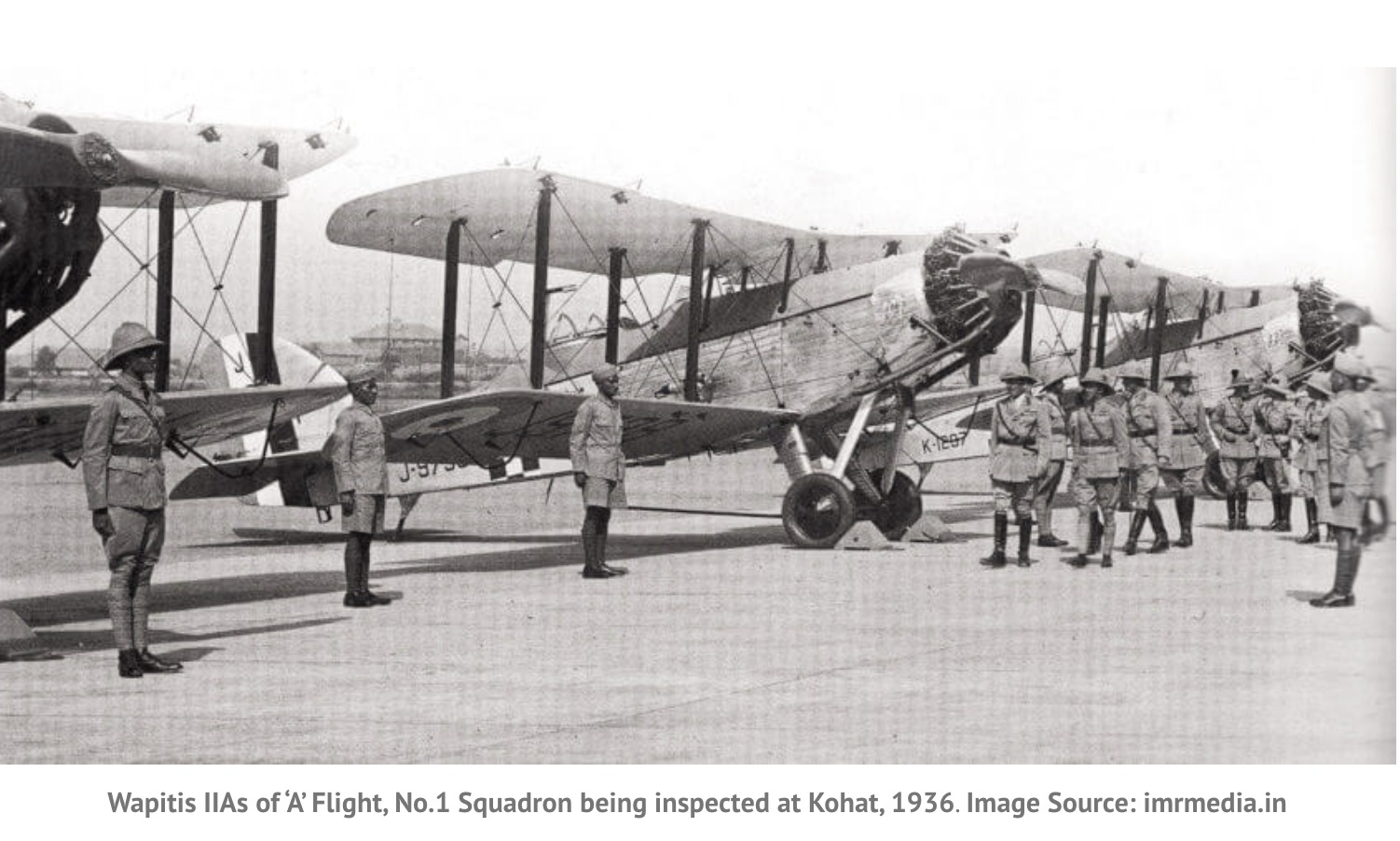
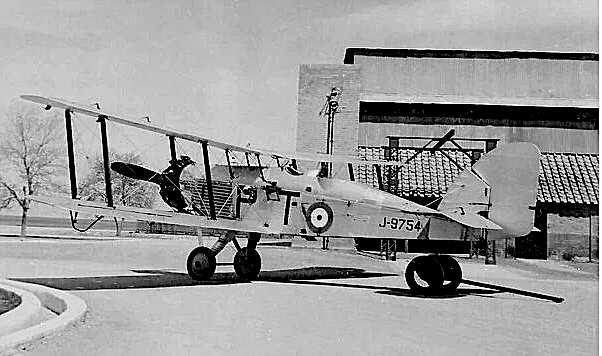
Perhaps my father’s contact with Indian pilots at Cranwell had a bearing on his posting to India in 1935.
In 1936, Mirza Ali Khan, known as the Faqir of Ipi, a long time opponent of the British Raj, intensified his campaign in Northern Waziristan.

Funding for his insurgency was later revealed to have come through from Mussolini’s Italy, and Hitler’s Germany, with the Italian ambassador as conduit. At one time Mirza Ali Khan was able to put 20,000 fighters into the field.

British and Indian Army units pursued the Faqir of Ipi , but he would always vanish. In fact, he would never be captured. .

The Faqir led an ambush against two British marching columns in Waziristan’s previously peaceful Khaisora Valley, trapping the units and inflicting more than a hundred casualties.

RAF strafing runs and air drops of ammunition saved the day. My father was always reticent to talk about his combat experiences, so I don’t know if he was involved in the air cover for the evacuation, but it is probable.

Among planes involved in these actions would have been the Hawker Hart, and Hawker Audax. Powered by a Rolls Royce water-cooled Kestrel engine, it could reach speeds of 184 mph with a range of 470 miles. Excellent maneuverability made the Hart an effective biplane bomber for the RAF, which eventually produced over 900 Harts. The Hawker Audax was an adaptation od the Hart for tropical climates. The crew of two sat in individual tandem cockpits, with the pilot sitting under the wing trailing edge, and operating a single .303 Vickers machine gun mounted on the port side of the cockpit. The observer sat behind the pilot, and was armed with a single Lewis gun on a ring mount, while for bomb-aiming, he lay prone under the pilot’s seat. Up to 520 pounds of bombs could be carried under the aircraft’s wings.

Also deployed in India was the Bristol Bulldog. a single-seat biplane fighter, which could carry four twenty pound bombs. It was armed with a pair of Vickers machine guns mounted one either side of the cockpit. When modified with slightly swept wings and an enlarged fin to improve spin recovery, the Bulldog became a successful RAF export to Denmark, Estonia, Finland, Latvia, Siam, Sweden, Japan, Australia and Canada during the inter-war period. Another modification was the large semi-circular cut-out in the trailing edge of the upper wing, to ensure the pilot the maximum field of vision. These were the principle weapons of war the RAF deployed in its colonial police actions.

From an RAF summary of events in 1935:
“ Trouble erupted again in Mohmand territory. Under the guidance of the Hadji of Turngzai, a lashkar of 2,000 tribesmen gathered with the intention of destroying a recently completed military road. Having warned the lashkar to disperse, a 38-aircraft demonstration was executed over the area. Following little observable change in the lashkar’s behaviour, a phased bombing programme commenced on 20 August in support of ground operations. However, close support was restricted throughout the period. Both Nos. 27 and 60 Squadron had a Flight each at the Hill Deport, reducing aircraft availability considerably.”
Here’s an extract from the report on what seems like quite a large operation.

After criticism of British bombing in Iraq, the RAF had moderated its terms of engagement in Afghanistan, by the time my father served there in 1935 and 1936. But the policy was still somewhat cold blooded. Bi-lingual leaflets were first to be dropped on a rebel village requiring compliance by a certain date otherwise the village would be bombed. If that date passed without compliance, a squadron would return to drop leaflets announcing the village would be bombed at noon the next day, so that the inhabitants could leave and take their herds to the safety of nearby caves. But the village and its fields would continue to be bombed every day until compliance was achieved. Leaflets would again be dropped to indicate it was safe to return. Ultimately insurgencies would dissipate. Till the next incident.

My father would only talk of his combat experiences when pressed. This is what he told me of his involvement in one “aerial policing” action. Leaflets had been dropped warning of the coming punitive air raid on a small recalcitrant village somewhere in Waziristan. On the appointed day, my father flew a maneuverable fighter bomber, probably the Westland Wapati, Dive bombing was the Wapati’s speciality. Or it might have been a Hawker Hart, depicted here.

The technique was to pass directly over the target, throttle back and pull the nose up sharply until the airspeed was within 20 mph of the stall. At this point, full rudder was applied. This was called a stalled turn. With the nose pointing vertically upwards at low speed, the rudder wheels rotated the aircraft elegantly on its axis to a position heading vertically downwards. If the pilot judged correctly, he should be looking straight down at the target. What my father saw was a lone goat directly below in the impact zone of the bomb. It probably lost its way during the evacuation and had wandered back to the village. My father did not want to kill a goat. He had no problem bombing those that shot at him, but not a goat. Seconds away, he veered sharply to the side and dropped the bomb near the edge of the village, scaring the goat away. A small thing, perhaps offering an ironic comment on the contradictions of war, but reflecting an underlying value system that aspired to protect innocents from harm.

Aerial missions, particularly at low altitude, had its hazards.

Afghan rebels inevitably captured .303 rifles and cartridges. So unless an aircraft was on a dive bombing or strafing run, the rule was to stay above 3,000 feet, out of the range of rifle fire. “The tribesman is a good natural shot, and is fully alive to the necessity for deflection when shooting at fast moving aircraft,” warns the pocket-size 1939 manual Frontier Warfare—India (Army and Royal Air Force). However, if detailed reconnaissance required pilots to fly lower, they should “make full use of their speed, fly an irregular course, and use their weapons to keep down hostile fire….”

If bad weather or ground fire forced a pilot down over hostile territory, his standing orders were: “first remove the bolt from the Lewis gun and throw overboard.” Once landed, the pilot had to burn the plane “by firing a bullet / flare into the petrol tank.” If escape was blocked, “It will be wisest to surrender with good grace and a bold demeanor, preferably to the older and more important-looking men among the crowd; the younger element is liable to be hot-headed and unpleasant.”

The British offered a reward of 9,000 rupees for return of a downed airman. This was generally successful. There had been instances for decades of rebellious tribesmen castrating captured British servicemen and bureaucrats in order to prevent them breeding more invaders. So the RAF provided what were commonly known as “goolie chits”; safe conduct letters for air crew, “goolie” being a Pashto word for testicles. The chits guaranteed a significant reward if the bearer was returned with all his parts intact. This morbid prospect was immortalized in an RAF Mess Hall drinking song by the refrain: “No balls at all. No balls at all. When your engine cuts out, you’ll have no balls at all.”
Life on a North West Frontier base could be uncertain.
“More significantly, a severe earthquake, consisting of two main shocks, struck the native city of Quetta and the nearby RAF Station on 31 May 1935, causing widespread devastation to aircraft and infrastructure alike. Air Chief Marshal Sir David Lee recalls: … as we began to taxy [sic] slowly towards the tarmac it soon became clear that the station [Quetta] had suffered immense damage. Hangers were still standing but the other buildings appeared to be heaps of rubble with clouds of the choking dust still floating upwards. An airman with a bandage round his head came limping out to meet me as I turned into line with about a dozen other aeroplanes which had arrived before us. While undoing my straps, I looked around; every airman in sight had some part of his body bandaged and, in fact, I don’t think I saw a single airman without some injury during our brief stay. Immediate relief was transported by air assets, with doctors, nurses and urgent supplies arriving in short order. Ultimately the RAF Station was abandoned: No. 5 Squadron relocated ”
Provided an officer returned from air operations with all his parts intact, or did not die from the many tropical diseases to which Europeans were susceptible, and was not a casualty of earthquakes or insurgency, then RAF service on the North West Frontier offered both officers and air crew a pleasant life style at bases like Fort Miram Shah. Here there were considerable amenities unavailable at RAF stations back in England. Soccer, rugby, cricket, hockey, tennis, squash, equestrian sports were all available. It was like a country club for all ranks. My father regarded the period of his India service as one of the happiest of his career.

My father entered RAF boxing contests and won a bronze. One of his few medals reflects his service in India.
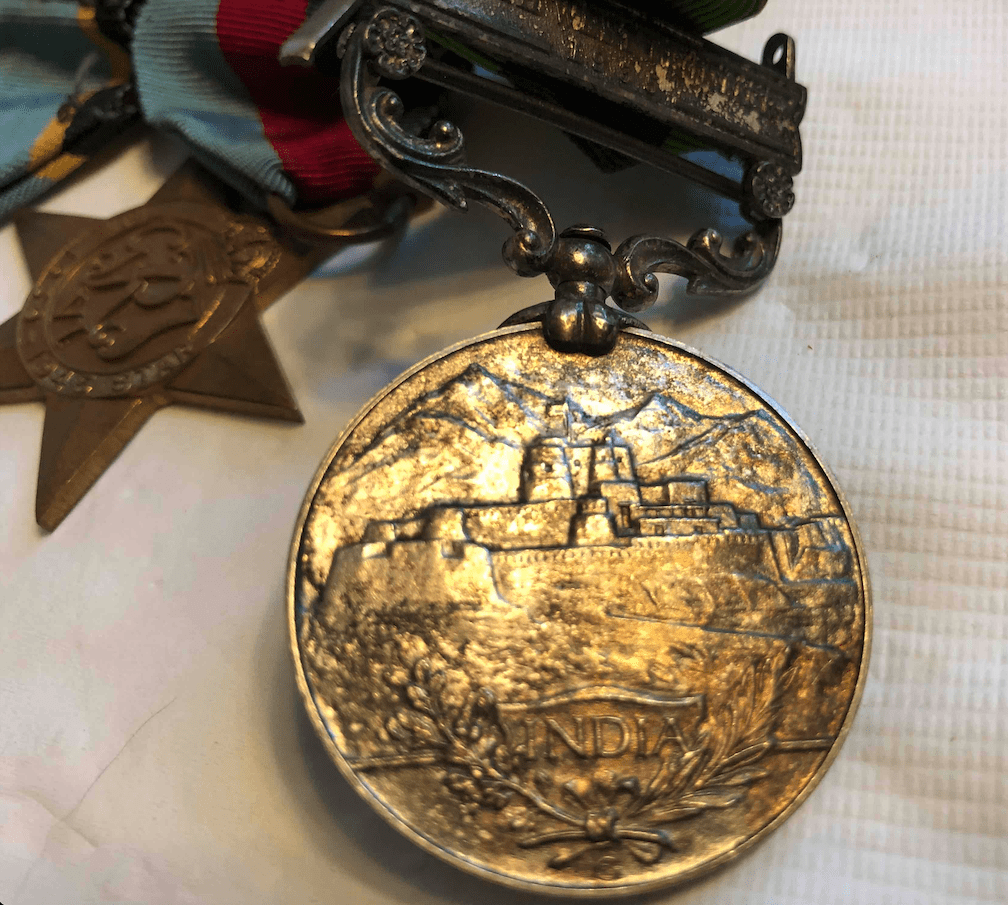
Sometimes his Squadron would take off at dawn, land on a nearby plateau, have breakfast under the wing, before conducting training maneuvers. Back to base by lunch. The flight of Hawker Harts parked below brought along family members and dogs. 
But all good things must come to an end. Aviation was evolving. The biplane was giving way to the monoplane. The RAF had new plans for Flying Officer E.T. Smith. He was posted back to England in November 1936, promoted from Flight Officer to Flight Lieutenant, and would spend the next three years at a number of RAF bases, training pilots in the flying techniques of different aircraft, navigation, precision bombing, and aerial combat.
CHAPTER 6 – WINGS OF CHANGE
For a decade, aviation engineers had been developing the successor to the biplane. In 1929 Junkers produced the first monoplane aircraft to carry passengers and cargo between Berlin and London.
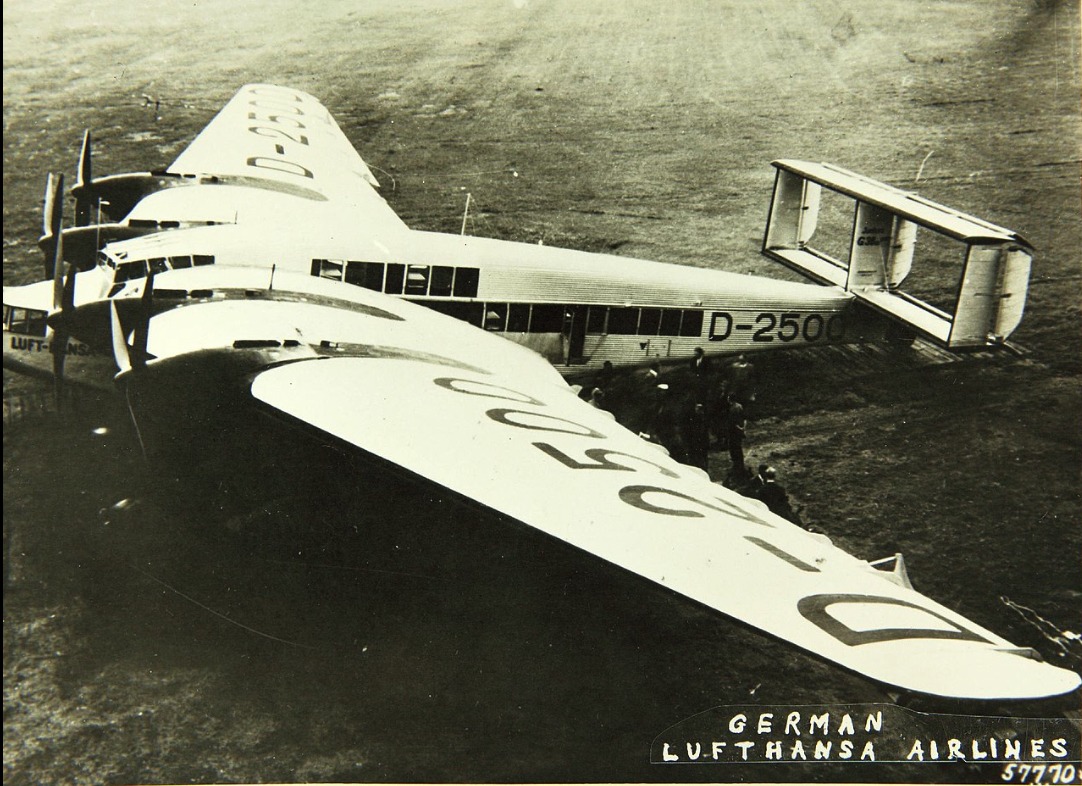
Germany had been prohibited by the Treaty of Versailles from developing a military air force. These designs show the Junkers G-38 would easily facilitate conversion to a long range bomber. This did not go unnoticed by Winston Churchill and others concerned about Germany’s lurch towards Fascism.


The same year US company Northrup produced the Avion Experimental No. 1 , the first rudimentary attempt at an all-wing vehicle, but it had a twin-boom, twin-tail empennage for added stability.

This was a subsequent design in 1946.
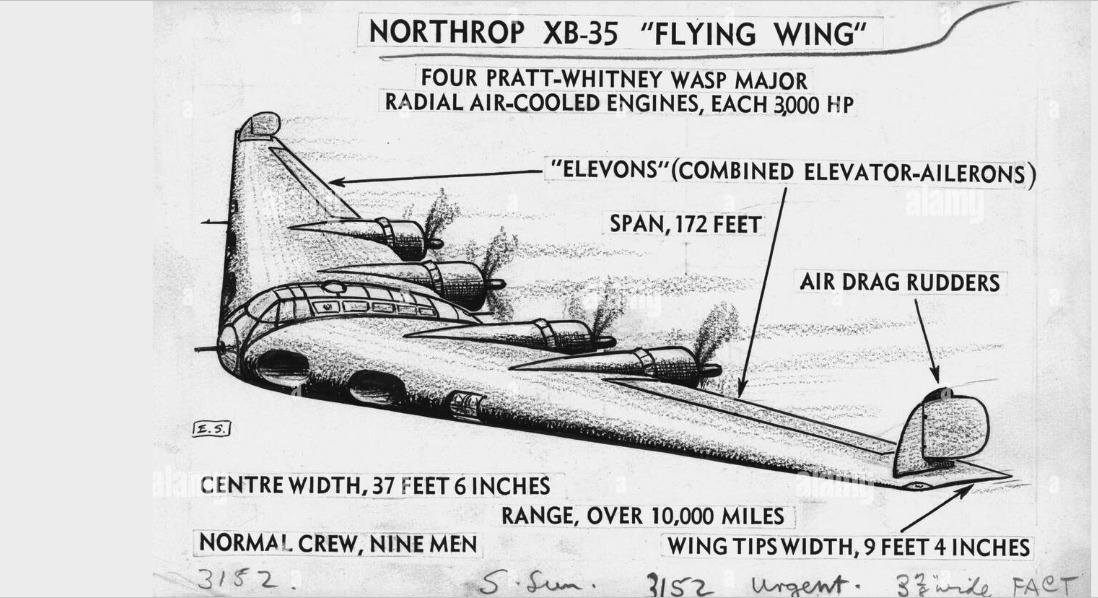
This design would evolve into the current Stealth Bomber.

Our current fascination with Aerospace technology was mirrored in the 1930s. Air displays were staged to popularize aviation as a daring, noble calling.
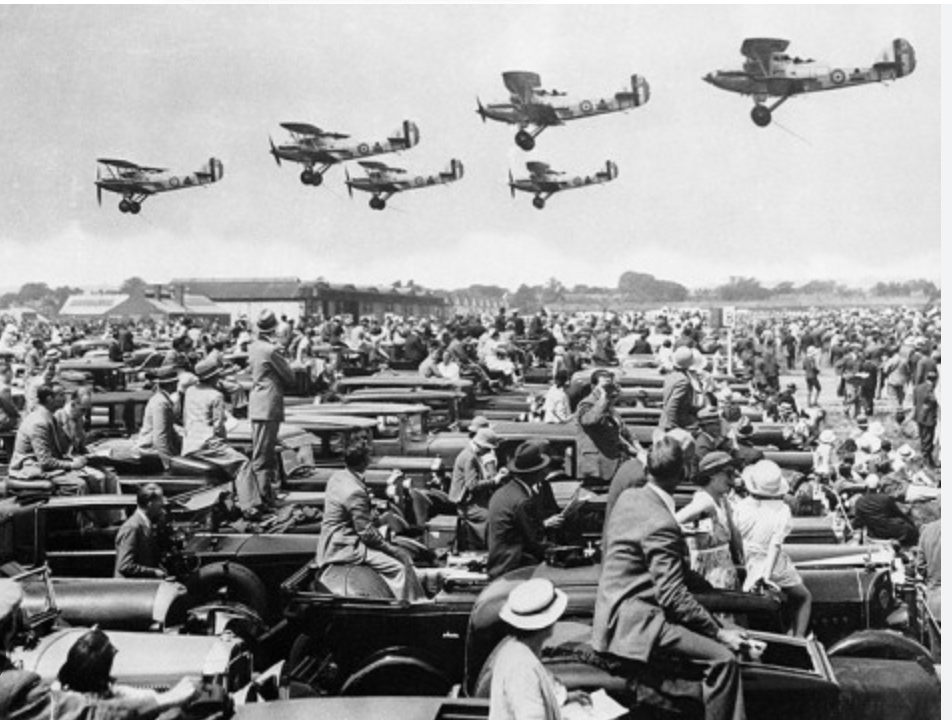 Universities offered flying courses.
Universities offered flying courses.
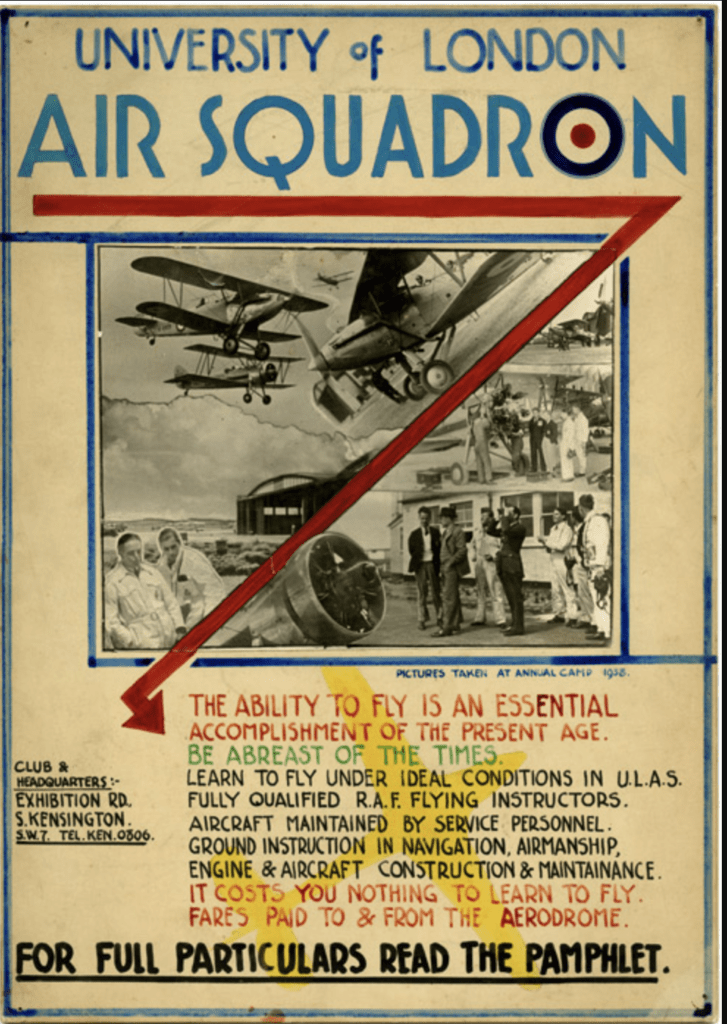
It was a time when celebrities, the wealthy, and politicians learned to fly. Winston Churchill took lessons in 1913, when he was 34, older than most pilots. Later he was reported to be “ “A very fair pilot once he was in the air, but more than uncertain in his take-off and landing.” A frightening assessment, or in Sir Hugh Trenchard’s words, he “was altogether too impatient for a good pupil.” After several near-misses, the loss of one of Churchill’s own instructors in a flying accident, he finally stopped piloting, following pleas from his wife Clementine and several colleagues. However, once he became Prime Minister Churchill would occasionally take the controls of the plane for a period while in flight.
To handle their increased pilot intake, the RAF needed well trained instructors. My father resumed these duties when he was posted back to England from India in November 1936, He was promoted from Flight Officer to Flight Lieutenant, and would spend the next three years at a number of RAF bases, training pilots in the flying techniques of different aircraft, navigation, precision bombing, and aerial combat. There is a good overview of pilot training in this website.
https://www.wondersofworldaviation.com/mobile/training_pilots.html
The RAF had been developing its first two monoplane fighters, the Hawker Hurricane and the Supermarine Spitfire. In 1936 the Hurricane went into production followed by the Spitfire a year later. My father would learn to fly both planes, then instruct others in their handling. He would ultimately instruct instructors in flight training procedures. Here is his official training record.

Trained pilots received a certificate.

With the imminent prospect of a second air war, Speed! became a priority in design. There were two leading competitors. In late 1934, the Air Ministry ordered Hawker to create an “Interceptor Monoplane ” able to carry a total of eight guns. Here’s the appropriately named “Hurricane ” prototype, photographed before its first flight in November 1935.

Hawker improved aerodynamics by making landing gear retractable, The new Rolls Royce Merlin engine, was capable of delivering a maximum level speed of 315 mph (507 km/h). The RAF test pilot’s report on the Hurricane’s maiden flight stated: “The aircraft is simple and easy to fly and has no apparent vices”.

The competing Supermarine Spitfire prototype, photographed below, displayed promise but needed improvement. The Spitfire’s stressed-skin construction required precision engineering skills and techniques which were rare in the aviation industry. Initially the Air Ministry passed, but the designers persisted.

Significant improvements resulted. Retractable landing gear, and an enclosed cockpit were installed plus a new elliptical wing, designed to be as thin as possible, thereby reducing drag. The Rolls Royce Merlin engine was enhanced by a new a three-bladed metal propeller and a new cockpit hood, providing a maximum speed to 348 mph (557 km/h), making the Spitfire faster than the Hawker Hurricane. On 3 June 1936, the Air Ministry placed an order for 310 Spitfires, an impressive number for its time.

Here are fully restored replicas of each aircraft passing along the white cliffs of Dover as part of a WW2 air display.

The Spitfire and Hurricane’s future adversary would be the Messerschmidt ME 109,top speed of 350 miles (570 km) per hour. Here’s a full working replica photographed at a recent air show.

Several online tutorials compare both the Spitfire and Hurricane against their most frequent opponent the Messerschmidt.109. Check them out when we reach the Battle of Britain. http://www.spitfireperformance.com/spit1vrs109e.html.
As war loomed, firepower became an important issue in fighter aircraft design. This twin engined Westland Whirlwind carried four closely grouped 20 mm cannon mounted in the nose. Clustering the weapons eliminated the convergence problems of wing-mounted guns. Its concentrated firepower (600 rounds a minute) was intended to strafe columns of vehicles, supply trains, and shipping.


With its all-metal fuselage, pilots found it noisy, cold, and uncomfortable. This particular Walrus was sent to Australia, were it served in WW2 before disappearing during a night reconnaissance. The Walrus could be modifies for catapult launching from cruisers or battleships, For those who like to get into the weeds of aviation history, this 1940 instructional film reveals the complex technological process and precise teamwork involved in catapulting a seaplane off a ship.
26 minutes in, there are good shots of the Walrus catapult take off, water landing, and crane recovery. Plus one hair raising moment @ 26.55.
As part of an exercise, my father learned to land a plane on an aircraft carrier. The weather was not great, the seas choppy. On his approach he could see the carrier’s deck yawing below. He had to gauge the right moment to cut power.

But a happy landing followed.

From 1936 till mid 1940, Flight Lieutenant E. T. Smith served as a training instructor at various RAF bases. As he learned and taught the flight characteristics of a variety of fighters and bombers, he earned the nickname “expert Eric”. He is featured next to his commanding officer in a cartoon published as “Aces of Tern Hill”.

NEW CHAPTER
The new King George the Sixth, who had got his wings in 1918 serving in France, rose to Group Captain by 1922, and had become Air Vice Marshall of the Royal Air Force upon the sudden abdication of his brother Edward the Eighth. In 1938 he visited the Central Flying School at Upavon, and met with all the instructors including my father, seen here in the top row. “H.M. The King” is seated in the center of the front row. George the Sixth was played by Colin Firth in the movie The King’s Speech. Other aspects of his life are featured in the Netflix series The Crown.


The nomadic and uncertain life of an RAF officer was not ideal for long term relationships. My father had girlfriends wherever he was stationed, but none became serious until October 1938. My father’s letter to his mother who had travelled from Auckland , New Zealand to visit him that year, and had recently sailed back, would have given her joy.

My mother, as much as my father, was a significant influence on my life, So I will digress for a moment and tell her story up to the point she met my father.

Vera Eileen Baxter was born on April 4th 1918. World War One was grinding slowly to its conclusion. Young Vera lived in an upstairs flat in Putney, London, with her mother Amelia and father John Baxter, an Northern Irish merchant navy captain who was often away at sea. Vera was an only child. A subsequent male baby was lost in miscarriage. When at home on leave, her father was frequently out of the house. “Why doesn’t Daddy take me out like other girl’s daddies do?” She recalled once asking her mother. The account of her childhood chronicles the trauma of an Irish/English custody battle of the period.
When my mother was eight years old, John George Briggs Baxter, to give him his full name, returned home from sea two weeks earlier than expected, to find his wife Mrs. Madge Amelia Baxter, nee Clarkson, absent, and his daughter cared for by friends, who advised him she was just taking a short holiday with a lady friend and would be back soon. In fact my grandmother had become increasingly lonely during her husband’s long absences, and had formed a relationship with another unhappily married man. They were spending a few days together across the Channel in a French seaside hotel
In my mother’s memoir she writes how her father came into her room late at night, sat on the end of her bed, silhouetted by a shaft of light from the landing, and burst into tears. Amid heaving sobs, he told Vera that she would never see her mother again. She had committed the marital crime of adultery, and he was instituting divorce proceedings. John Baxter was a proud Irish Protestant, a member of the Loyal Orange Association, an anti Catholic political group. Back then, divorce between Protestants was permitted under these circumstances, but it would be a blot on the family name. The anger and bitterness my grandfather felt at his betrayal would be most keenly experienced by his child. The scar from this traumatic night would never fully fade.
He took young Vera immediately to his father’s house in Northern Ireland to be looked after by his sisters, who resented the imposition as did all senior members of the extended family. Great aunts Gertrude and Harriet were the worst, referring to Vera’s mother as “that Scarlett Woman…” They would not call her Vera, the name her mother chose; instead she was called by her middle name, Eileen, because it was more Irish. These aunts would make public show of their religious devotion, praying fervently, when they accompanied their brother and his daughter to Church on Sundays. John Baxter was somewhat deaf and tended to fall asleep during sermons. His sisters took this opportunity to exchange gossip about the other congregants, particularly the women, Their hypocritical behavior was digested by my mother, feigning attention to the sermon. contributing to her life long suspicion of organized religion. Vera’s aunts put her into a series of Dickensian boarding schools, the first of which expelled her when they learned she was “a child of divorce.” A new school was found for her; Clair Lodge in Newcastle, County Down. a building she describes as “gaunt.” It sat at the foot of the Mountains of Mourne, in its own grounds, surrounded by a thick hedge, right beside a beach, sometimes lashed by gale force winds. On one occasion the girl’s dormitory windows facing the beach were blown in. It took days before repairs were accomplished. Her hand written memoir details the conditions.

“The winter months were unspeakably cold.We washed in cold water from the jugs on washstands, and often had to break the ice before doing so.”
Food was “reasonable, but I never want to see massed swede again as long as I live.
Medical care was survival of the fittest.. If you became ill at Clare Lodge, the treatment was to be confined to a large empty bedroom on the far side of the building. No doctor ever visited. Miss Parkes brought the meals on a tray. I had the usual share of childhood diseases; chicken pox – ‘Don’t scratch, Eileen!’ Mumps and the agony of forcing food down with aching jaws to avoid having the same meal brought back again. One unfinished bread and butter pudding was served three days running till it turned sour. My worst illness was whooping cough. This time I was not put to bed, and walked around with it for three weeks. Once, during lunch, I was red/purple in the face from whooping, and Miss Agnes said ‘ Stop coughing, Eileen dear, you’re making yourself worse!” Mercifully it was the last day of term, and when my grandfather picked me up, I was violently sick, and he took me straight to the doctors. I remembers him standing over my bed, as I whooped and whooped, saying ” She’s going to die..”

For four and a half years Vera was often cold, hungry, and made to feel inferior. Throughout this period her mother petitioned for visitation rights: initially she was allowed only one hour per visit. ” I longed to see her, but I was constantly being filled with propaganda against her. Prior to her visit, my grandfather stormed around the house, spitting out hatred of her. and offered me a penny if I did not see her. My mind was in a complete muddle. By the time she arrived, I ran and hid under a bed. She eventually found me,, knelt down begging me to come out. We had a tearful re-union. then she had to go back to England.”
In the morality of the times, Vera’s mother was “the guilty party” and had lost custody. . Finally, having married the man who had been the cause of the divorce, she could now offer a stable home, she petitioned for custody. The court decided the best interests of the child, now turning thirteen, were to live with her mother in England where she had grown up, rather than in Ireland, where her father would be away at sea for long periods. Vera moved to England to live with her mother and her new stepfather, Mr. Fred Medwin, a businessman, whose fortunes waxed and waned over the years.
” I came back to England with an Irish brogue that was so thick that my stepfather could not understand a lot of what I said. Now I had to be groomed to be a well mannered English lady. I was grateful to be back with my mother but terrified of my stepfather. He was subject to outbursts of rage, and would yell loudly, with his eyes bulging in anger, usually picking on some small thing quite suddenly. Each time this happened my stomach would do several somersaults, and my heart raced. The old cliche ‘out of the frying pan into the fire’ applied to those early days.”
Stepfather Fred Medwin, with two teenage children of his own, was a good parent, despite fits of temper. John Baxter, her actual father, disowned Vera when she succumbed to pressure to assume her stepfather’s surname. She never heard from her father again. Another blow upon the wound. Vera, no longer Eileen. was once again addressed as Vera. She was sent to a girls boarding school, Abbotsford in Broadstairs, where she excelled at French and piano lessons, and rapidly assumed the accent of her stepfather. Following the pattern of her Irish years, Vera was rebellious and a misfit. Things changed at age 16, when she was sent to “finishing school”: An Ursuline convent school in Brussels, which specialized in teaching the girls to be good cooks, as preparation for marriage. The warmth of the Catholic Nuns contrasted with the disdain she had experienced from Protestant clergy. Her confidence grew. She became fluent in French, and learned dressmaking. For the first time in memory she began to feel happy. Then she was cast as the lead in two stage shows at the school, performing in French,. She had found her calling. She decided to become an actress, perhaps to receive from an audience the approval she had been denied throughout her formative years.

Due to a financial downturn, the family could not afford to send her to RADA. She interviewed with agents, some of whom made it clear what the price of representation would be. She declined. The best entry level strategy was to join an extras agency, get booked for crowd scenes at a guinea a day, be noticed and someday be given a one line part. She signed up for crowd work immediately. There were four movie studios—Pinewood, Beaconsfield, Denham, and Elstree—not far from Cookham where the Medwin family lived. Stepfather Fred’s business had bounced back and he was operating two local hotels and renting out another property. He bought Vera, in her words, a ‘terrible old bone shaker’ for ten pounds sterling. She was regularly at work across the range of studios. Extras had to provide their own clothes except when the movie was a period piece. Occasionally she was the lighting stand-in for a prominent actress Diana Churchill. Same height, same hair coloring. She started to score those 1-line parts.. Waitress: “Your boiled egg, sir.” Three days’ work playing a newspaper reporter followed. She was slowly making her way up the ladder. Acting is a thankless profession, in which few however talented make a decent living. But my mother had beauty, drive and an extrovert personality that masked her insecurities. She might have done well. Then she met a young RAF officer, my father. It was apparently love at first sight.

Resuming my father’s story, his letter to his mother continues, with financial concerns, and an indication that relations with his father had improved since his departure to the UK eight years before. Trenchard-Smith Senior could only have been impressed with his son’s application to his chosen career, and had apparently sent some money previously so that his son could buy a car upon his return from service in India. A Flight Lieutenant’s salary was tight for a married couple, and my father would have to bear all expenses, including purchasing a life insurance policy, until the RAF marriage allowance adjusted his yearly pay.

The next section of the letter offers a clue to his father’s prejudice towards those who were not White Anglo Saxon Protestants. Although there was not an outright prohibition on marriage to Roman Catholics, such a match would not have been popular. Vera’s mother and stepfather were Protestant, but open minded enough to send Vera to a Catholic “finishing school” for girls in Belgium, where she learned excellent culinary skills from Cordon Blue chefs. These were evident during their early courtship when my father “popped down” to see her each weekend.

Food at an RAF Officer’s Mess was, shall we say, undistinguished. My mother’s cooking was phenomenal, and she taught me to prepare a passable range of dishes. among the many educational gifts she passed on. The letter then refers, with my father’s sense of irony, to a conversation during his mother’s visit, about him being ” a confirmed bachelor”, before concluding he was awfully happy.

My mother, late in life, began a handwritten memoir which she never finished. I will quote from it occasionally where it sheds light on social conditions and RAF life that she and my father experienced together.
They met when she was invited by a hopeful RAF officer suitor to accompany him to a Saturday nightclub ball at the officers mess at RAF, Upavon. where Flight Lt. Eric Smith was also stationed. When the ball was in full swing, she noticed “aa tall dark, handsome man who was staring at me intently. A few seconds later I waas told that there was someone who wanted to meet me.” When they were introduced, it was a classic case of love at first sight. or as my mother put it. “We both fell like a ton of bricks.“.
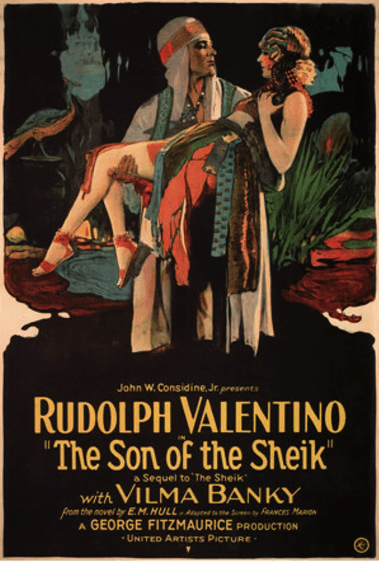
Their first date took place a few days later, lunch and a movie at the local cinema screening a revival of Rudoph Valentino’s silent classic The Son of the Sheik. Like many cinemas of the day, the program featured an organ recital in the interval. With blasts on the pipes, the instrument and its player rose from beneath the stage, with a banner sign round its base – ” up came slowly – Eric Smith and his organ. This amused us a lot.” When Eric delivered me home, he parked and blurted out “I’m madly in love with you..Will you marry me?” I said yes, and crept into the house on cloud nine.” ( A 1970’s metaphor, when she wrote her memoir)
It was a big decision to propose marriage 20 days after first meeting. One factor that may have impacted my father on his visits to Vera Medwin at her stepfather’s house was witnessing her distress when her stepfather drunkenly argued with her mother. According to my mother, my father told her as he left not to worry. ” I will take you away from all this.” Luckily Fred took to Eric straight away, as did her mother. My parents were married six months later.


Vera’s stepfather Fred Medwin, seen here standing beside her mother, gave the bride away, in the absence of her real father who had ceased contact with his daughter when she changed her name to Medwin. As my mother put it: “He threw me away.”
Flight Lt. E. T. Smith had several weeks leave due to him so he took his new bride for a honeymoon in France. Fred helped out with the cost of motoring from Paris to the Riviera. My mother’s account in her memoir, when read today, has a fin de ciecle quality. It was June 1939. They toured the Eiffel Tower, Napoleon’s tomb. Palais de Versailles.Taxis drove at frightening speed, though this probably didn’t bother my father. They saw night club performances forbidden in England; nude and semi nude girls at Bal Tavern and the Folies Bergère. Linguistic differences amused my mother who was semi-fluent in French. When the honeymooners requested a double bed, it was called un lit Anglais. Similarly a contraceptive was un capot Anglais, which British people of the day called a French letter. Both nations blaming the other for sex. First night in Paris, the honeymooners got oyster poisoning from a restaurant famous for its oysters. When they finally emerged from their room 2 days later looking tired and disheveled, the hotel staff , unaware of the poisoning, gave them admiring looks.
They drove to Monte Carlo, economized by camping out on alternate nights. At Hotel Chateau Diedato my mother had her first sight of the Mediterranean, where she enjoyed time on a pebbly beach. She reported how my father in comparison extolled the smooth sandy beaches of Auckland and Sydney. My mother would spend her last 30 years living a short walk from the sandy beach of Avalon, New South Wales. Perhaps her honeymoon influenced her choice. They certainly by her account had a good time. They bought “dirty french postcards” and sent them to Eric’s brothers and his fellow officers.
At the hotel where they spent a week, the honeymooners were befriended a small wirey German man in his fifties. “He said we looked so happy he was sure we were not married.” recalled my mother. His name was Peter Bloch. He would reconnect with my parents in England. He had been a solicitor to the former German Kaiser Wilhelm , who was deposed in 1918. His service to the Kaiser was engraved on his gold cigarette lighter. Mr Bloch’s wife had denounced him to the Nazis, causing him to flee, and perhaps influencing Mr. Bloch’s views on marriage. He had originally been born in England and was now applying for a British passport. Given the recent Nazi annexations, he was sure war was imminent. Other British holiday makers dismissed it, believing Mr. Hitler will keep his word this time. A few felt if there was war, it would be short, that there could never be another conflagration like The Great War. British complacency, even ambivalence, about the Nazi threat has been well depicted in a range of Brit TV series . As for their honeymoon my parents put such thoughts aside and enjoy a beachside oasis of peace while they could. This involved visits to casinos , illegal in England, nightclubs and cabaret till the wee hours, in the company of two British doctors on leave from Somalia, and the spritely Peter Bloch, who despite is age could out-drink everybody, yet was still the first on the beach the next morning. He knew an era was about to end.
Upon their return to England, my parents were soon moved into married housing on the base at at RAF Upavon. My mother derived some amusement, which I share, from the bureaucratic manner in which all household inventory was documented on the official form, with items listed as if standing stiffly to attention. ” For instance: Mats/ Door, Mats/Bath Cork, and importantly, Pots/ Kitchen to differentiate from Pots/ Chamber. Now, if you reached the rank of Group Captain, your Pots/ Chamber had a gold ring around the rim and a crown…”
Not a time, my mother thought, when a man needed to be reminded of his rank. She always had an irreverent attitude to officialdom.

In August of 1939, Britain and Poland signed an agreement of mutual assistance. This mean that were any foreign power to interfere with either country militarily, the other would rush to their aid. Days later, on September 1st, Germany crossed the Polish border under a flag of nationalism, on an invented crusade to liberate the oppressed Germans of Danzig, a semi-independent area created by the terms of the Treaty of Versailles, 1919. War preparations had been underway for some time.

All the officers at Central Flying School, Upavon, including my father, wanted to go on operations, They were told they were too valuable as instructors training future pilots, for which massive recruitment was underway. The courses lasted six to eight weeks. Many retired officers rejoined the RAF and came to the CFS for a “refresher course”. Instructors like my father would assess their flying skills on aircraft they had flown before, and introduce them to the new Hurricane and Spitfire. The commanding officer of the Refresher Squadron listed this pilot’s ability as “Exceptional”, the same rating my father held.

Additionally, more flight instructors had to be trained to handle the increase in new pilots. One was a New Zealand friend of the family. An extract from a letter my father wrote to his mother on January 29, 1940 conveys his sense of detail in flight instruction.
“I’m keeping fairly fit and I am looking after Ronnie Laird. He arrived on the present course so I am hammering him into shape and he should be a useful instructor when I’m finished with him. He is extremely keen and is progressing quite well. I wouldn’t have recognized him. It is rather amusing to get hold of a colonial and pull their voices to pieces. With due respect to the New Zealand accent and intonation , it is rather dull coming down through the earphones in an aeroplane, but he realizes his voice weaknesses and is gradually speaking with the intonations I want him to.
Communication air to ground, pilot to crew, spoken in a noisy environment, required required clear diction and uniform pronunciation to avoid potentially fatal pilot or navigational errors.
“He studies hard and I have said before, is terrifically keen and and the mere fact of being selected to be trained as an instructor means a lot to him.”
My father was clearly proud to be a flight instructor himself, and the foundational role of flight instructors in the development of the RAF. But, like his fellow officers, my father wanted ” to go on ops.” It was a rite of passage. What his training had been for. He was philosophical when denied.
“I’ll be a fatalist and just take what job they give me if they’re going to move me from here. I hope you received my last letter posted email on aprox January 10, 1940. I suppose the Aussie and New Zealand contingent will be over here any time now. The AAF squadron received a very warm welcome in this country. Damn good show. I bet they do well .”
My father, now senior flight instructor at Upavon, continued trying to mint new instructors, and give refresher courses to re-enlisted officers.
One of the pilots taking a refresher course at the Central Flying School early in 1940 was Douglas Bader, whose RAF career was immortalized in Paul Brickhill’s best seller and 1956 movie Reach For The Sky, which topped the UK box office that year.

Bader had graduated from CFS in 1930, the same year my father entered the school. They were friendly but not close at that time. They had different attitudes to flying. My father was a keen but prudent adventurer, cautiously pushing the boundaries of new aircraft. Bader was an extrovert who saw flying as a means of demonstrating his mastery of the environment. He had established a reputation for aerobatics at the 1931 Hendon Air Show, and was training to win the next year’s title. Two pilots had already been been killed disobeying regulations by practicing maneuvers at under 500 feet. On 14 December 1931, at the Reading Aero Club, Bader attempted some low-flying aerobatics in a Bristol Bulldog biplane, apparently on a dare. He crashed when the tip of the left wing touched the ground. Reach For The Sky accurately recreated the cartwheel nature of the crash.


In his last barrel roll, he swung the tip of the upper wing too low to the ground.The plane cartwheeled and broke in half.

Bader’s legs were mangled in the process. Both had to be amputated—one above and one below the knee. Bader’s report in his logbook read:. “Crashed slow rolling near the ground. Bad show.”
After a long convalescence, during which he needed morphine for pain relief, Bader was fitted with 1932 issue artificial legs. This was a hard adjustment for a man who had captained rugby, cricket and hockey teams as a student. He met and married Thelma Edwards, a waitress in the local tea room. She greatly helped in his recovery,. He fought hard to regain his former abilities. In time, he was able to drive a specially modified car, play golf, and even dance.

As soon as he was physically able, Bader successfully retook all necessary flight training courses. Despite political connections, Bader was nonetheless declared unfit for duty. He was invalided out, and joined a company the would become Shell Oil.
As war approached, Bader repeatedly requested that the Air Ministry accept him back into the RAF, but he was told only “ground jobs” were being offered. Using his connections at the Air Ministry, Bader eventually regained a medical categorization for operational flying at the end of November 1939 and was posted to the Central Flying School , where my father instructed, to be given a refresher course on modern types of aircraft. He had convinced the Air Ministry that a fighter pilot really did not need legs to shoot at the enemy.
On 27 November, 1939 eight years after his accident, and days after his arrival at CFS, Bader flew solo again in an Avro Tutor. My father, who was overseeing his refresher course, was a witness. Bader, once airborne, he could not resist the temptation to turn the biplane upside down at 600 feet inside the circuit area. On the few occasions my father spoke about Bader, he was ambivalent. While he respected Bader’s courage and determination, he found him a somewhat overbearing personality, always seeking to be the center of attention, his daredevil behavior potentially a risk to other pilots. The low level stunt he just pulled to impress the Flying School revealed he had lost none of his penchant for recklessness. But my father recognized that war, particularly war in the air, needs daredevils. Who would not be inspired by a legless man volunteering for aerial combat? Bader certainly had real skills as a pilot. He quickly progressed through the Fairey Battle and Miles Magister, the last training stage before flying Spitfires and Hurricanes. In January 1940, Bader left the CFS to join 19th Squadron on operational duty. When the Battle of Britain began, his skills in aerial combat became evident. He would be credited with downing 24 Luftwaffe planes between 1940 and 1941.
All RAF officers wanted their turn on “ops”. From the start of the period known as “the phony war”. my father’s requests for “ops” were repeatedly denied because of his value as an instructor of instructors, He found this particularly galling in May 1940 during the collapse of the British Expeditionary Force and the evacuation of Dunkirk, the chaos of which is well conveyed in Charles Cundall’s famous painting. Christopher Nolan’s Dunkirk movie brilliantly captures the RAF experience supporting the evacuation.

Fearing the potential loss of the army, the British government were reluctant to risk experienced pilots they would need to defend Britain for the invasion likely to follow. My father chafed. My mother was to a degree relieved. Her childhood had embedded a fear of abandonment. heightened by marrying an RAF pilot. She knew flying fatalities were a fact of life in peacetime. The scale of the war to come could barely be imagined. My father’s importance as an instructor at CFS would at least delay the possibility of the telegram all wartime wives dreaded. At the height of the Battle of Britain, the life of a Spitfire pilot was could be as little as four weeks.
Between February and May 1940, Bader practiced formation flying and air tactics, as well as undertaking patrols over convoys out at sea. During this time, he crashed a Spitfire on take-off. He had forgotten to switch the propeller pitch from coarse pitch ( for high speed flying) to fine pitch (for take off), resulting in the aircraft careering down the runway at 80 mph before crashing. Despite a head wound, Bader tried to walk to another Spitfire for a second attempt and found that his artificial legs had been buckled from being forced beneath the rudder pedals during the crash. He recognized that if he had not lost his legs previously, he would have definitely lost them then. Recovery this time was a matter of ordering replacement legs. Despite this repeat snafu, Bader’s skills as a Spitfire pilot became evident when he brought down a Dornier in action over Dunkirk..
Bader had his own ideas about aerial combat. He favored using the sun and altitude to ambush the enemy, but the RAF did not share his opinions. Official orders/doctrine dictated that pilots should fly line-astern and attack singly. Bader began using his Air Ministry contacts to lobby for the “Big Wing” approach, a massive formation of six squadrons in a frontal attack on the approaching bombers. As his “kill count” grew, the Air Ministry took note. He was promoted from pilot officer through Flight Lt. to Squadron Leader within a year.
But when the Blitz on London started, Ft. Lt. E.T. Smith got his wish for action. He was assigned to a squadron on reserve night fighter duty. He did not like to talk about his wartime experiences. He did not want me growing up during Britain’s decades long victory parade, believing War was glorious. A night fighter pilot’s task was challenging. Radar could provide the direction of enemy bombers, but once they were engaged and dispersed, individual enemy aircraft were hard to locate accurately in the dark. Being in the right place at the right time for those few seconds of target visibility was a matter of luck. Pursuit is a lot easier in daylight. On his few missions he was unsure whether any of the bursts he fired would have brought down an enemy plane. The only other detail he offered was that he received, as a night fighter pilot, an extra ration of carrots, because of the perceived benefit to eyesight of a heavy dose of beta carotene. Vitamin A.

The Ministry of Information (MOI) had mounted a big campaign to support food rationing regulations. Food was a weapon of war. Both its propagation and conservation were vital. Embedded in the propaganda campaign for sustainable nutrition was an additional objective; the deliberate attempt to disguise a significant reason for RAF success against the Luftwaffe – Radar, a secret advanced warning system, that enabled RAF fighters to lie in wait for incoming waves of bombers. An explanation for the uptick in pilot victories needed to be circulated. The MOI interviewed RAF night fighter ace, John Cunningham, nicknamed “Cat’s Eyes”, who ultimately shot down 20 planes, 19 at night. He attributed his accuracy in targeting to eating an excess of carrots. They improved his eyesight, he said. The MOI published the interview, the British public responded, and the campaign took off. As food rationing increased, the carrot and the potato became national characters throughout the war.

The carrot became a sugar substitute when rationing limited two people to 8 ounces of sugar a week. The kids are unimpressed.

Even Walt Disney lent a hand. Did this inspire Bugs Bunny?

Some have said the publicized benefits of carrots to Battle of Britain fighter pilots was in fact part of a disinformation campaign to deflect attention from a new technology critical to Air Defense – Radar. It certainly helped enshrine the carotene benefit in Myth. There is some anecdotal evidence that the Luftwaffe might have believed it and issued some fighter pilots with extra carrot rations. Rationing had begun in 1940. Here’s a collage of food propaganda posters.

By September 1940 my father had resumed his role as instructor of instructors at Central Flying School. Douglas Bader would occasionally visit. He was becoming a national celebrity as the legless air ace with an impressive list of credited “kills”. Here is a colorized photo of him boarding a Spitfire without assistance, swinging the longer artificial leg into the cockpit first.

The winter of 1940 – 41 was particularly severe. It would cause my mother to have an unusual encounter with Douglas Bader. My father’s letter to his mother sets the scene.
“January 9 January 29, 1940.
Dear Mother, still here, and at the moment completely stranded as all the roads are covered with ice (glazed frost, which is very rare). Most of the telegraph wires are down and any tree with long branches have snapped.The rain freezes on contact with any object and the telephones wires are covered with a cylinder of ice one and a half inches in diameter – a beautiful site in a way but it has done a lot of damage. as you have probably heard we had a , something freeze up all over England for about two weeks 20° of frost most days and flying was bitterly cold. No amount of protection on hands would keep out the cold if you touched any metal part of an airplane,Every blade of grass is completely enclosed in a cylinder of ice and walking on the road and pavement is very dangerous unless you have steel studs in your shoes.”
There were eight steps leading up to the Central Flying School Officers’ Mess. Newly promoted Squadron Leader Bader slipped on an icy patch and fell while attending the Saturday night dance, splitting his dress pants open below the crotch. Colleagues helped him inside. My mother always carried needle and thread in her handbag and offered to sew up the tear. In her memoir she recounted how Douglas Bader sat in his underwear in a bathroom, while my mother used her convent taught needlepoint skills on his trousers. Once restored for public exhibition, Bader asked my mother to dance. His wife of ten years, Thelma, to whom he was devoted, was the only woman he ever danced with, but she could not attend. Would my mother oblige? My mother’s memoir continues:
” He felt we would manage if I took a larger step with one foot than the other. As we foxtrotted to the center of the room, suddenly Douglas let out a yell of pain, then hobbled with me to the nearest chair. Everyone was looking in apprehension. Then Douglas started laughing uncontrollably. I kept asking with concern what was wrong. ” If you must know, ducky, I got my balls caught in my false leg.”
Hilarity ensued. Bader was an ebullient extrovert, popular in the Mess. My mother recalls him amusing an audience with one of the ironies of being a double amputee serving officer. Boot polish kept getting on his socks. The housekeeping system required that an officer leave the shoes he needed to be cleaned outside his room overnight for his batman to take care of before breakfast. In Bader’s case each shoe contained his artificial leg, still fitted with a sock. The batman would not remove the shoes from the “tin legs”before polishing, always smearing the socks. Social history trivia is a window on British classism.
During the Battle of Britain, Bader’s competitive nature and genuine aviation skills made him an ace fighter pilot. He was eventually credited with 22 aerial victories. One advantage that Bader had over his fellow fighter pilots came courtesy of his amputations. The high g-force experienced by pilots throughout combat often caused them to pass out, as the blood was forced to drain from their brains and into their legs. Bader’s dual amputation meant that he didn’t lose as much blood to his lower extremities, allowing him to maintain blood pressure and stay conscious for longer.
During 1941 Bader’s wing was re-equipped with Spitfire VBs, which had two Hispano 20 mm cannon and four .303 machine guns. Bader flew a Mk VA equipped with eight .303 machine guns, as he insisted that these guns were more effective against fighter opposition. His tactics required a close-in approach in which he felt the lower calibre weapons had a more devastating concentrated effect. For a better understanding of the war in the air, there is much analysis available on line on the relative merits of the Spitfire, Hurricane and Messerschmidt. In fact an actual trial of a Hurricane versus an Me 109 was conducted in May 1940 by the RAF, using a captured undamaged Messerschmidt.

Both aircraft were flown by experienced fighter pilots. The trial focussed on four comparisons: take-off performance, rate of climb to 15,000 feet, dogfighting; and line-astern formation flying.
In the first test, the two aircraft took off together and climbed straight to 15,000 feet. The performance of the Me 109 in this test was significantly better than that of the Hurricane, despite the fact that the Hurricane was fitted with a constant speed airscrew and flown at full throttle and full revs.
At 15,000 feet the aircraft separated and approached one-another head-on and commenced the dogfight. The Hurricane pilot did a stall turn followed by a quick vertical turn, enabling him to lock onto the 109’s tail. The pilot of the 109 was unable to prevent this maneuver succeeding. From that point the Hurricane pilot had no difficulty remaining on the tail of the Me 109. The pilot of the 109 tried all possible maneuvers, concluding with the one most usually employed by German pilots, namely a half-roll and vertical dive. The Hurricane followed this maneuver but the 109 drew away at the commencement of the dive, being the faster machine.
The pilot who flew the Hurricane gave this opinion..
“The Me 109 is faster than the Hurricane by some 30 to 40 miles an hour on the straight and level. It can out-climb and initially out-dive the Hurricane. On the other hand it has not the maneuverability of the Hurricane, which can turn inside the Me 109 without difficulty.”
The conclusions drawn from these tests enabled the RAF to train new pilots in combat strategy and tactics to maximize strengths and minimize weaknesses of the Hurricane. retired Wing Commander “Bunny” Current gave this evaluation after the war.
“I flew [Hurricanes] almost daily for just short of three years, from December 1938 to August 1941, when I took command of a Spitfire squadron in Hampshire. The Hurricane was a magnificent war-horse, with its unsurpassed gun platform in the leading edge of the wings, which had a deadly promise. It had no vices whatsoever, with superb reliability, and was so easy to fly in all weather conditions. Totally trustworthy in all respects, it was a confidence-giving aeroplane, loved by all who flew it.”
While the Spitfire became the dominant fighter by the end of the war, the Hurricane would be responsible for 60% of German aircraft shot down during the Battle of Britain. The loser in aerial combat, if he survived the bullets disabling the plane, had one chance to stay alive as his aircraft plummeted down: his parachute.

.
The folded silk canopy, checked by the pilot before take off, also provided a comfortable seat. U Tube has an interesting piece on WW2 parachutes, British, German and American.

544 RAF pilots of Fighter Command and more than 2,500 German aircrew were killed during the Battle of Britain. .At the height of the battle, the average life of a Spitfire pilot was 4 weeks, as more and more pilots went into the meat grinder.. Squadron Leaders E.T. Smith and Squadron Leader D. Bader knew the law of averages was not in their favor. As did Vera Smith and Thelma Bader. But the ethos of the time was to suppress emotion, grit your teeth, get on with it. Angst was suppressed by light hearted banter, dance parties, cigarettes and alcohol. Movies at the local picture palace, accompanied by reassuring propaganda newsreels. On radio the new Prime Minister Winston Churchill lifted morale with stirring rhetoric spiced with wit. Hitler had declaimed over the airwaves. “Germany will wring Britain’s neck like a chicken!” After the Battle of Britain, Churchill quipped back : “Some chicken. Some neck.”
As with all service men and women, their lives would be effected by the strategic decisions of high command. In 1940 Sir Hugh Montague 1st Viscount Trenchard, whose portrait as Metropolitan Police Commissioner is reproduced here, returned from retirement to exert his influence on defense policy. which would have an effect on missions undertaken by 242 Squadron, North Weald, where Bader and my father were stationed.
This was Viscount Trenchard’s official portrait upon retiring as Metropolitan Police Commissioner in 1936. The regalia looks a bit ridiculous today for an officer of the law. You might reflect on why the chosen pose had him gazing upwards to the right. The pomp and paraphernalia of officialdom always amuses me.

A brief digression on the iconic and politically skillful Father of the Royal Air Force,. Viscount Trenchard had a powerful personality . “Boom”, it bears repeating, was the Whitehall nickname.for “his stentorian utterances and low rumbling tones”. During his five years as Metropolitan Police Commissioner and subsequently, he was never reticent about voicing his opinion as a newly created Viscount from the pulpit of the House of Lords, if he felt the interests of the RAF he founded were threatened in any way. He opposed the Air Ministry for prioritizing manufacture of Fighters over Bombers. He offered a better plan for the air defense of Singapore , which the government would soon regret rejecting. In 1939, then Prime Minister Neville Chamberlain, hoping to remove Trenchard from his public platform in England, offered the gadfly peer the post of organizing advanced training for RAF pilots in Canada. All offered posts were declined. After the failure of the Norwegian campaign, Trenchard used the House of Lords to criticize the Government’s half-hearted prosecution of the war. .
When Winston Churchill replaced Chamberlain, he wanted to find a place for this leader in the field of aviation warfare. It is said that Viscount Trenchard aspired to be both in charge of the Air Ministry as well as becoming some form of joint secretary of defense, making the RAF a driver in the war effort. rather than a component. That was more power than Churchill was prepared to give away. Trenchard realized that by his rash demands had excluded himself from a pivotal role in the British war effort, so he became an unofficial Inspector-General for the RAF, visiting deployed squadrons across Europe and North Africa on morale-raising visits. In May 1940 Trenchard visited 12th Squadron in France.

But Trenchard always had Churchill’s ear. He successfully lobbied for the removal of the Chief of the Air Staff and the Commander-in-Chief of Fighter Command. Both were replaced by Trenchard protégés.
Trenchard proposed that the RAF should “Lean Towards France” – Go on the offensive, having won the battle of Britain, engage the Luftwaffe over French skies, and win the resulting battle of attrition. That was the theory, of which Douglas Bader was a strong supporter. The RAF introduced a new offensive stance: the “Circus” sorties, daylight raids undertaken by a small force of bombers with a powerful fighter escort.

They were intended to lure enemy fighters into the air so that they could be outnumbered, engaged and destroyed, while protecting the bombers from attack on a specific target; the initial code name: Ramrod. Rhubarb was code for a small-scale attack by fighters using cloud cover, to surprise and destroy German aircraft in the air or on the ground.

The RAF’s ‘Circus’ raids, had been under way since early 1941. British intelligence had detected the imminent rift in the Nazi/Soviet alliance.and observed much of the Luftwaffe assigned to protect the French coast was being transferred to the east in the build up to the invasion of Russia. When Nazi tanks rolled across the Russian border on June 11 , the RAF stepped up their attacks over occupied Europe to draw Luftwaffe units back to France and take pressure off Stalin’s Russian Front, The Luftwaffe countered by stationed its remaining squadrons at bases further inland, from where they could decline combat or engage RAF fighters in places where they were at a tactical disadvantage for lack of fuel.
TRANSFERRED TO “OPS”
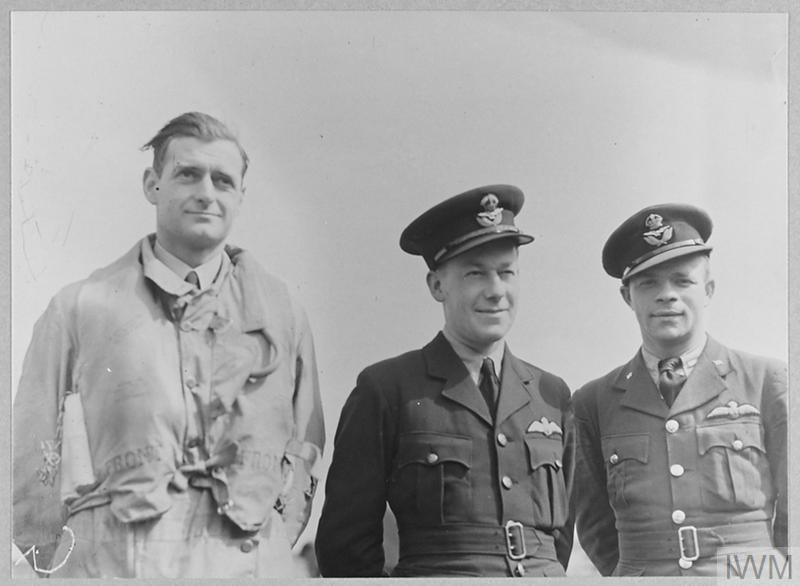
My father finally had his requests to leave flying school and “go on ops” accepted. He was transferred to 242 Squadron, which was assigned to the ” Circus” sweeps. RAF pilots and aircrew flying over enemy territory faced the possibility of capture, interrogation by the German military and confinement in a prisoner of war camp. The Great War had provided both sides with some experience in handling their respective prisoners. All ranks were duly briefed on what to expect, what information a POW was required to divulge – only name, rank, serial number, next of kin. In April 1941, my father attended a briefing by an RAF Intelligence Officer, who outlined some evasion and escape technique. It was an officer’s duty to try to escape, because by doing so, they were forcing the Nazi war machine to divert troops and resources for their recapture.
Circus raids by 242 Squadron at the beginning of June had been uneventful.

On June 17, the Squadron was ordered to provide close escort to Blenheim Bombers on a raid over France. Squadron Leader E. T. Smith had a meal with his fellow pilots, then attended final briefings from Wing Commander Kellett, who led the mission. At 6.40 pm the Squadron took off. Twelve aircraft, a mixture of Hurricanes and Spitfires joined the flight of Blenheim MK. 5. Bombers and crossed the English Channel. Their mission was to bomb a chemical factory outside Bethune.


The major remaining German fighter groups in France, JG26 and JG2, only intercepted when conditions were in their favor. 15 miles out from Bethune, the RAF mission was unexpectedly attacked by Messerschmitt 109’s in significant numbers. The formation was scattered in the ensuing melee. My father was flying a Hurricane.

Both Hurricane and Spitfire guns carried 14 seconds of ammunition, fired either in bursts or continuously. Pilots liked to leave a couple of bursts available in case of a dogfight on the way home. From my father’s brief account of the action, he he got behind an ME 109, and fired a short burst. He saw a stream of smoke as it banked away. At that moment, another ME. 109 raked his plane.
Smoke was seeping into the cockpit. The Hurricane was not going to make it home. The engine was about to fail. He knew he had to bail out while he still had flight control. As the smoke thickened, he carried out the procedure he had learned for a clean exit, one that safeguarded against the slipstream slamming the pilot into the tail section. Let gravity do the work. He slid the cockpit canopy back, flipped the plane upside down, released the harness holding him into his seat, and dropped out into the sky. This digital simulation created by video gamers for a Utube demo captures such an adrenalin charged moment.


My father never discussed how he felt at the moment of his capture. He must have felt gratitude at escaping almost certain death. The possibility of going home to his wife one day, when the odds of surviving years of missions was remote, mingled with disappointment that he could no longer use his accumulated expertise in pilot training to aid the war effort. He wished he’d had a better innings, to use a cricketing metaphor prevalent among the young pilots the RAF recruited extensively from British Public Schools, a culture my father had absorbed. My father had hoped for more time at bat, to put more runs on the board. His “probable” victory would never be recorded. He simply joined the list of the Missing.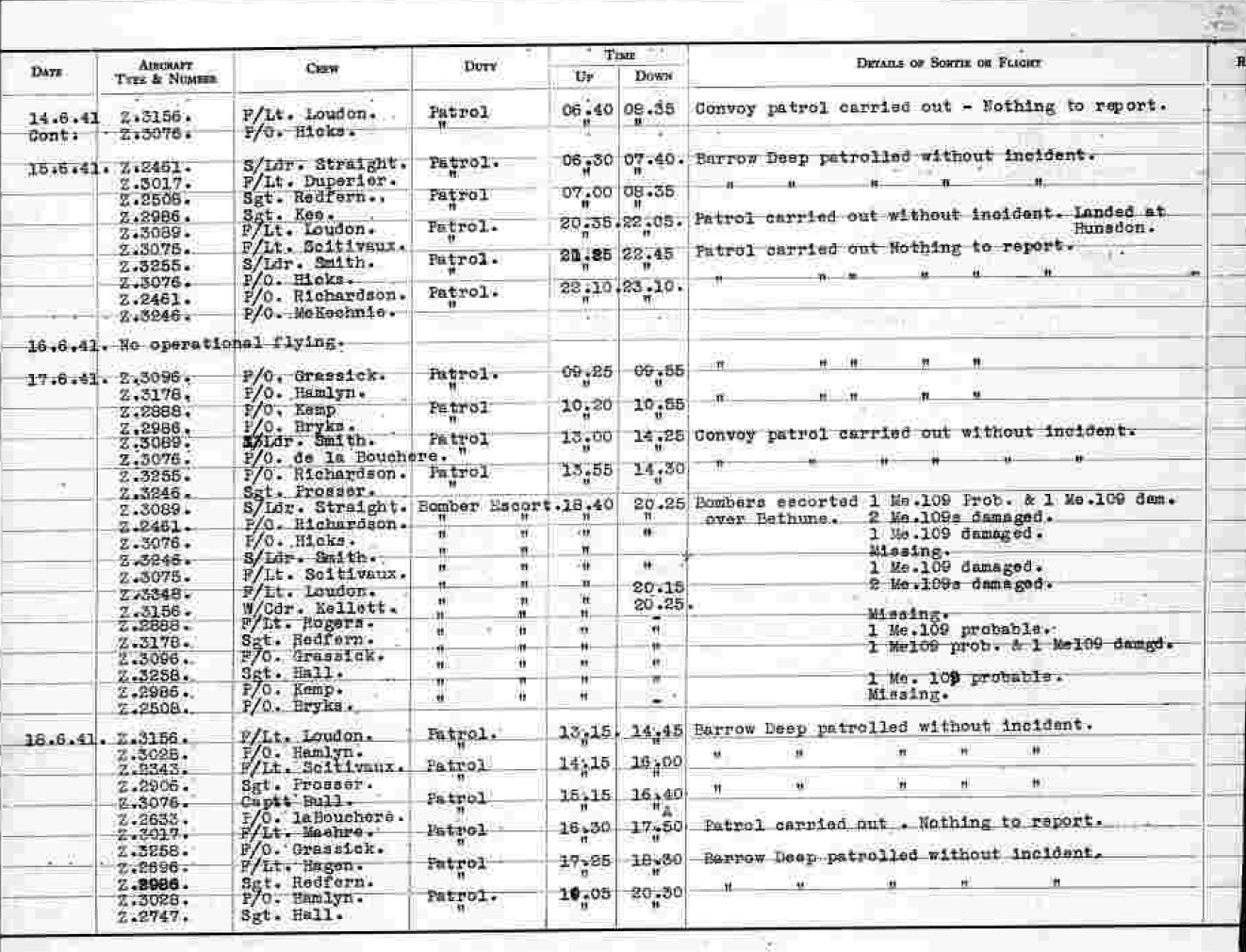
Historical records reveal that Fighter Command greatly exaggerated the success of its “Circus” missions. From June to the end of December 1941. It claimed 731 Luftwaffe aircraft were brought down, against a real Luftwaffe loss of 154 aircraft, 51 of which were not lost to RAF action. In fact, Fighter Command claimed 51 pilots were shot down by June 1941 but another 411 were lost by years’ end, a greater loss than July to October 1940. Defenders of home ground have the edge over attackers. This time the Germans had the advantage. In hindsight, the “Circus” operations had a deficit effect; the aircraft involved would have been better employed in the Middle and Far East. I doubt if my father gave much thought to the policy of which he was now a casualty awaiting transportation to prison camp. His focus was on survival and escape. If he saw any silver lining to his situation, it would have been that he was now automatically promoted to the next rank, Wing Commander. This ensured. at least, in the event of his death, his wife would receive an increased RAF widow’s pension.
THE ORANGE ENVELOPE
Three planes from the squadron did not return from the mission, the names of the pilots recorded dispassionately in the daily log.

But the RAF was meticulous in their response to the bereaved or families of the missing, with an extensive bureaucracy to ensure next of kin were promptly informed and their needs met. Upon notification of a KIA or MIA or POW, an action checklist would swing into place requiring departmental countersignatures at each stage.

The War Office took the dependents of serving men seriously. Taking care of the women behind the men was important to maintaining the morale of the country., and you I’m going to show how the RAF handled the process in its communications with my mother. First 242 Squadron reported the “Missing” to the Air Ministry, with name and address of next of kin, with advice that she had not been informed. The Air Ministry would draft the telegram.

After my father was posted to a base near the coast, my mother was living in a converted flat above the garage at Coverack, her parent’s house. In her memoir, she recalls the moment: “I was so lonely, and of course, lived in constant terror of what the future held. Six weeks later I was awakened early one morning. My mother and an old friend stood in the doorstep. My mother’s face was actually gray, and she had been crying. She pushed the dreaded orange envelope into my hand muttering ‘ He’s only missing, darling. Only missing…’ Her voice trailed off. My heart was breaking.”

” I read the telegram missing.Missing, repeat, missing. I stumbled into the lounge and clasped a large picture of Eric to me, rocking backwards and forwards in a state of incoherence. My mother picks me up to drink some neat brandy, but nothing Wield the feeling of an agonizing emptiness that I felt. Only missing meant nothing to me. I have seen so many wives living in hopes for months only to be told her husband had been killed. Why should I be one of the lucky ones, how was I to live without him?“
The pain she must have felt as a newlywed is hard to imagine. A letter confirming the telegram duly followed.

The Squadron had immediately itemized her husband’s personal effects and notified her that no will had been found.

My mother like many RAF wives had to manage the pain of uncertainty, the prospect of grief. “My mind was occupied with Eric, willing him to be safe. At times I feel unexplainably happy, that he was safe. Looking back I feel there must have been telepathy between us. At other times I was again plunged into black despair. Luckily for me mother nature took over and I would sleep with no dreams, just complete black heavy sleep.”

My mother, like most British families, would listen to the German broadcasts of the most prominent Nazi propagandist William Joyce, known as “Lord Haw Haw”, who spoke nightly across the British airwaves, intending to undermine morale. By contrast, in Nazi Germany, it was forbidden to listen to foreign broadcasts, potentially punishable by death, in the last year of the war.

In the 1930’s, William Joyce had been Director of Propaganda for the British Union of Fascists (BUF), but fled to Germany at the start of the war, and become their English language mouthpiece. Joyce’s broadcasts, delivered in a snide tone, both mocking and menacing, always began with the announcement “Germany calling, Germany calling,” Joyce urged the British people to surrender, blaming the Jews for the outbreak of war. Although listening to the broadcasts was not illegal, it was strongly discouraged. This did not stop 6 million regular listeners and 18 million occasional listeners around the United Kingdom from tuning in. This was because Lord Haw Haw would at some point read out six or eight names of newly captured British servicemen. This ensured listenership.

America incorporated Lord Haw Haw into a 7 minute animated propaganda short produced by Looney Tunes, adjusting the name for the American ear. Each evening the radio in Coverack was tuned to Lord Haw Haw as he tortured the families of the recently missing. My mother found that hope dashed nightly did her no good, and her stepfather took over the monitoring of broadcasts. Eventually the International Red Cross, the established conduit for casualty information, contacted the Air Ministry.

Then on a July 5th, two and a half weeks after Squadron Leader E. T. Smith was reported shot down, a telegram mercifully arrived.

In my mother’s memoir she recalled that such was her state of dread, she had her mother open the telegram. When she heard the news, she wrote that she screamed ” Prisoner of War” over and over. I’m sure ” .unwounded repeat unwounded” resonated too. Not maimed or blinded by burns, Relief accompanied by a new sense of hope. Her husband had done his duty. Circumstances beyond his control had taken him out of the firing line, to somewhere where he could perhaps remain safe till the war’s end and come home to her. That night Lord Haw Haw announced Squadron Leader Eric Smith as one of the 6 new POWs. The family raised the Union Jack on the Coverack garden flagpole for all to see. William Joyce’s broadcasts ultimately strengthened rather than weakened British morale.
MOVE
Here is Joyce, shortly after being wounded during capture in May 1945. He was hanged for treason at Wandsworth Prison six months later.

Two days later the War Office communicated further relief, that the address of the prison camp where her husband was being held would soon be forthcoming so that they could write to each other. A lifeline every wartime grass widow needed.
?
The next item on the RAF agenda was the Missing Officer’s Personal Effects.

And his outstanding mess bill of Six Pounds, One Shilling, and Six Pence.! To be deducted from his continuing salary, as remitted to his dependent.

Providing these belongings offered memories to the bereaved and hope for the families of the missing. I have included the pro forma chain of paperwork because reflects the RAF ‘s care and concern for those left behind. Captured servicemen were automatically granted a promotion in absentia. My father’s rank changed from Squadron Leader to Wing Commander. My mother benefitted from the increase in his salary. Now she had to face the rest of the war alone, however that might turn out in the dark days of 1941. She did what the women of Britain did. She joined the war effort.

My mother worked in a number of factories, making amp meters, tail caps and fins for bombers. She graduated to be the manager of a canteen. requiring her to do all the shopping, preparing, and washing up leaving everything clean for the night shift.

The women of England rose to the occasion in great numbers, as American women would subsequently do. Before the war’s end, the 18 year old future Queen Elizabeth The Second drove an ambulance. My mothers wartime service culminated in her graduation to manager of a canteen. requiring her to do all the shopping, preparing, and washing up leaving everything clean for the night shift. She was happy to keep busy, while she waited for my father’s safe return.

PRISONER OF WAR
Squadron Leader Eric Trenchard Smith spent the next four years as a Prisoner of War at a variety of camps.

Upon release, all POWs were required to fill out a questionnaire. I now have a clearer picture of how he served his time “in the bag”.

All air crew flying into enemy territory received a lecture from an RAF Intelligence officer in case of capture. Instruction on how to respond to interrogation were given. Information on what kind of conditions to expect gleaned from POW’s letters and reports from the Swiss agency that monitored both British and German POW camps. In the culture of the times, it was considered an officer’s duty to try to escape, causing the enemy to divert troops for recapture, thus still aiding the war effort. All aircrew at these lectures were advised that in every POW camp there would be an escape committee who assess individual plans for escape and facilitate those most likely to succeed. Officers were encouraged to develop a secret letter writing code with a spouse or family member, so information could be passed back and forth through POW mail undetected by German censors; ironically, often wives of camp officials. My parents did not develop a messaging code, but my father did volunteer his services to the escape committee of every prison camp to which he was sent.

My father never liked to talk about his experiences as a POW. He felt the war had taken away four years of his life during which he was frequently cold, hungry and in danger. The war had cost him most of his friends and some cousins. He never attended reunions. He wanted to forget the war. Perhaps his reticence to talk was affected by signing the Official Secrets Act at the conclusion of his POW debriefing.

I have tried to piece together what his POW life was like from his brief comments on the subject, and from the accounts of others in the official records. How Allied prisoners of war dealt with their reversal of fortune is reflected by the strength of character with which their generation was raised.

Following interrogation and 3 months at an interim camp, my father along with an assortment of new POWs, arrived at Warburg Railway Station.

After disembarking from a train of cattle cars at Warburg, the prisoners were marched out to a treeless, dusty plain where the camp stretched out over three quarters of a mile. An aerial surveillance picture from high altitude.

I’ve tried to imagine what my father and fellow captives might have been thinking as they trudged towards their new home. I am sure some prisoners counted their paces to calculate the distance between the camp and a railway line, where they could possibly jump a train. My father, being a proficient navigator, would have taken note of the camp’s geography, as did this POW.

 =
=
The double perimeter fence of barbed wire was constructed around wooden frames, set about 8 feet apart and around twenty feet in height. At the bottom, in the gap in between the fencing, a further thick tangle of barbed wire had also been positioned. Guards patrolled inside and outside the double perimeter day and night.

Regular perimeter guard towers displaying mounted machine guns. Signs along the wire and beside the the well guarded front gates read: HALT! LAGERGRENZE! Continuing in English: ” Camp Boundary! Prisoners trying to cross the wire will be shot at!”


Allied prisoners of war were occasionally shot while trying to escape. In 1941 it was infrequent, rarely at Air Force camps, because of the Luftwaffe’s respect for the RAF, but it happened. The funeral ( lower picture) of a POW shot by guards while attempting to escape near Dresden in 1944. shows German guards firing three volleys over the coffin as respect for a fallen enemy. In fact, POWs at Offlag V1-B were in less danger from the guards than from the insanitary conditions of the camp.
In 1939, twenty nine large huts had been hastily constructed at Warburg intended by the Nazi Government to accommodate the amount of prisoners of war they anticipated housing before hostilities came to a quick end in Germany’s favor. Neville Chamberlain‘s appeasement policy had caused Hitler to underestimate the British people’s willingness to fight. By late 1941, Offlag V1 B was already substantially overcrowded. With new arrivals from North Africa, the disastrous Crete campaign, and the recently opened Russian front, the total would rise to 3000 prisoners.

All the huts contained ten large and four smaller rooms, dimly lit by acetylene lamps. They had no electricity. Inadequate heating made the huts freezing cold during the harsh German winter. Double bunks lined the walls, fitted with musty, straw filled mattresses. Between 12 and 16 officers were assigned to each room, where they would be locked from dusk till dawn. Previously, six to eight occupants to a 20 foot room had been the custom. Rodent droppings littered the floors. There were reports of prisoners waking to find mice and rats running across them. Primitive outdoor sanitation, vermin, and the lice that already infested prisoners uniforms added to the risk of disease. Soon there were cases of bronchitis and diphtheria.The conditions that my father and other POWs faced upon arrival on October, as the extremely cold winter of 1941 set in. The camp Commandant Sturtzcopf, fearing the outbreak of typhus, finally exterminated the fleas and vermin, In time the Germans built new brick buildings to ease overcrowding. and increased the supply of Red Cross food parcels. They added a library of 400 books, and a football ground which became a hockey field in winter.

Sports and literature had benefits outside of morale. Coded messages in prisoner’s letters could be devised from the classics of Shakespeare and Dickens. Sporting equipment could be repurposed for escape. POWs derived sustaining comfort from either attempting to escape or by supporting escape attempts, thereby continuing the war by other means. The Germans believed sports were the way POWs would burn off pent up energy and thus divert their attention from escaping. They understood escapes would be inevitable, just as Luftwaffe personnel were expected to try to escape from British POW camps. This report on Offlag V1 B compiled post-war by former POWs reflects Commandant Sturtzcopf’s attitude to escape.

For some POWs, escape would be the pinnacle of sports7 . World War Two produced some legendary escape artists, whose exploits have been immortalized in books, movies, documentaries and television drama. I am only going to touch on those men I know my father worked with, starting with Douglas Bader, epitomized in the book and film Reach For The Sky.

It was not long after his arrival that my father was joined at Offlag V1 B by his fellow officer from 242 Squadron, Douglas Bader, shot down over St Omer. Bader was now a decorated Ace, (DSO and DFC), This RAF photo, taken a few months earlier shows Bader with fellow officers admiring a cartoon emblazoned on their planes: 242 Squadron’s boot is kicking Hitler’s arse.

Soon Wing Commander Bader would have the tail of his Spitfire sheered off, not by the Luftwaffe, probably by friendly fire. Ah, the ironies of war. In 1945, RAF Ft. Lt. Casson, who was also shot down in the same dogfight, reported the possibility in retrospect; that in the melee he mistook Bader’s plane for an ME 109, opened fire with cannon, causing the target’s tail to separate from the fuselage. Bader believed he had lost his tail by colliding with another plane, but no such damage was reported by the German side of the dogfight.
Bader had been pushing for more sorties to fly in late 1941 but his Wing was tired and becoming resentful of Bader’s determination to add to his score of 20 confirmed kills. Bader’s immediate superior at Fighter Command, Trafford Leigh-Mallory, was urged to withdraw a visibly tired Bader from operations. But Leigh-Mallory did not want to upset his star pilot, and allowed Bader to continue frequent missions over France. On August 9th 1941, Bader was flying without his regular wingman who had a cold that day. He became separated from his formation, and chose to attack a flight of six ME. 109s without back up, shooting down two, before the law of averages finally caught up with the daredevil Ace.
Bader’s ability to survive aerial disaster continued. When he attempted to bail out, his right leg got tangled in the cockpit as the plane spiraled downwards. Unable to get it loose, he pulled the ripcord on his parachute and the force of the canopy opening snapped the straps on his trapped prosthetic limb, freeing him from the falling plane. He parachuted into Saint Omar. The landing knocked him unconscious, and he was taken to the local hospital. His damaged missing leg was recovered from a field.
Bader would spend time in three prison camps, two of which he would share with my father. The two men had known each other at Cranwell Flying School in 1930, before Bader lost his legs and left the RAF. They had reconnected in 1939 when Bader came there to be trained on the new Hurricanes and Spitfires. My father was one of his instructors, and subsequently served in the same Squadron. My mother’s memoir recalls, as 22 year old new RAF bride, how Bader’s wife Thelma had taken her under her wing at social gatherings. No doubt it was comforting to my father to hear how she was coping. Thelma Bader and Vera Smith would share the same anxieties for the next four years.
Bader’s arrival at Offlag X1B, while a perceived blow to Britain’s air war, gave camp morale a significant boost, and provided leverage to slowly get Offlag conditions improved. Bader was admired rather than resented by senior Luftwaffe officers for his 20 confirmed kills, just as WW1 German fighter ace Baron Von Richthofen was admired by the Royal Flying Corps, precursor to the RAF, a generation before. This mutual respect was evident at the time of his capture.
Local Luftwaffe Colonel and ace fighter pilot Adolf Galland, together with fellow officers, two of whose planes Bader had just shot down, welcomed Bader to their airfield and received him as a friend. He was cordially invited to sit in the cockpit of Galland’s personal ME 109. Bader asked if it was possible to test the 109 by taking it for, as he put it, “ a quick spin around the airfield.” Galland reportedly laughed, and politely declined, stating he feared Bader would attempt to escape and then he would have to give chase and they would shoot at each other again. Galland would end the war a General, credited with 104 aerial victories.

Galland did notify the RAF of Bader’s damaged prosthetic, and offered safe passage if they wished to parachute in a replacement. Reich Marshall Herman Goering himself gave the green light for the operation. Churchill did not want to give Germany a public relations victory and declined. A flight of six Blenheim bombers were dispatched – Circus 81 – to drop the replacement right leg over Saint Omar, on their way to another target. Here’s the operational report.

It was dropped in a Red Cross crate.

This German photo has Bader receiving the prosthetic limb which has a flexible knee joint. Bader would return the favor in 1945 when he met Galland, then himself a prisoner of war. One of Galland’s fellow POWs was an amputee, Hans-Ulrich Rudel, Germany’s most decorated fighter pilot. Bader arranged for Rudel to be fitted with the latest artificial leg.

I imagine in their first conversation, Bader and my father would have exchanged notes about their shared parachuting experience. They were now eligible to be members of the Caterpillar Club, formed in 1922 for men who bailed out of a disabled aircraft, all beneficiaries of the silkworm.

It had been a textbook chute exit, in my father’s case. In Bader’s, it helped to have a disposable leg.

Walking round their new environment, Group Captain Bader – like my father promoted upon capture – and Wing Commander Smith would have discussed the future of the war, and what part they could play in it. There was a high level of RAF involvement in escapes from WW 2 prison camps. Those who have tasted the freedom of flight are particularly driven to escape the confinement of a cage.
Bader had re-enlisted in the RAF to distinguish himself in combat. Now as a POW, he was going to distinguish himself as an escapee, and a legless one at that. Initially, Bader and two others tried cutting through the wire with home made wire cutters at a blind spot in the camp’s perimeter, but they only got a few feet before a warning shot was fired. He had already made one escape attempt from hospital after his capture, and remaining free for a number of hours. Bader’s new duty was, as he put it, “ to be as big a bloody nuisance to the Germans as possible.” Eventually his multiple escape attempts would cause the commandant of Colditz Castle to threaten to take away his legs.

During roll-calls, or “appels”, Bader would regularly engage in what he called ‘goon baiting.” mocking the guards as they passed. The German guards, unaware of the derogatory connotation, willingly accepted the nickname after being told it stood for “German Officer Or Non-Com”. A frequent target of Bader’s goon baiting was Lieutenant Hagar, a hardline Nazi, who one day lost patience and ordered a guard to slam his rifle butt down on Bader’s foot, unaware of his artificial legs. Instead of a cry of pain, derisive laughter from Bader caused Hagar public humiliation. Bader’s “goon baiting” would sometimes result in prolonged appels in cold weather as collective punishment. This caused some resentment among POWs who felt Bader was seeking attention at their expense. To my knowledge my father never engaged in “goon baiting”. He preferred an unobtrusive relationship with camp authorities, the better to observe their routines, and find guards susceptible to bribery.

But Bader did make some positive contributions to Escape Committee’s intelligence section through his relationship with another dedicated “goon baiter” Flying Officer Peter Tunstall. A POW since Dunkirk, he managed to achieve by war’s end the record number of 416 days in the cooler for his escape and “goon baiting” infractions. Tunstall and Bader would have a fortuitous meeting in Offlag V1 B.

Heeding advice at his pre-ops “in case of capture” briefing, the resourceful Flying Officer Tunstall and his fiancee Ann Doul had arranged a system of secret communication, using a form of invisible ink, undetectable by those who examined prisoners’ outgoing mail. Tunstall could then pass on information about his condition that enemy censors would have inked out. Bader suggested that Tunstall’s next letter to his fiancee should contain a message from Bader to be passed on to his wife Thelma, who in turn would ensure it would quickly reach the right desk at the War Office. Bader and Tunstall collaborated on multiple messages during their time together at Offlag XVB and Colditz. Here’a an example of a letter from Colditz sent by Tunstall and Bader to Tunstall’s fiancee. It was despatched in an envelope which passed German scrutiny before being passed on to Britain via the Red Cross.

Inside was an innocuously worded letter and a photograph. The photographic paper has been carefully split and the message – written on a sheet of tracing paper – inserted.
Note the writing follows the dark part of the image to remain hidden.

Bader’s messages, relayed by Ann Doul, to Thelma Bader were recorded in War Office files. Here is the third 1942 message recorded “by this method.”

The message also contained useful nutritional information for the Red Cross. Confirmation that German citizens were disobeying Hitler and listening to BBC radio would have been encouraging to Churchill too.

“Keep bombing these bastards to Hell!” – mild by his normal run of expletives – was Bader’s war policy advice. He was an avid proponent of the Big Wing strategy and supporter of Lord Trenchard’s campaign for massive bombing raids. Tunstall’s accompanying letter provided a series of instructions to his fiancee, as to how she could create similarly invisible messages, concealed in her mail to him. The enterprising Tunstall also suggested his fiancee could use this opportunity to apply for a job in intelligence.

This example of classic spy craft reflects the ingenuity of that WW2 generation who knew how to fix things and invent workarounds as needed. Luckily this subterfuge was not discovered, otherwise Tunstall and Bader could have been accused of espionage, potentially a capital crime.
Code provided a two way street of information for the War Office. One POW camp received a request via coded letter: Find out the thickness of the armor on the then new German Tiger tank. Resourceful POWs found a way. They contacted a Polish national brought into the camp for some maintenance work; he then contacted the Polish Underground Movement, which had people actually working in one of the factories that made the tanks. The thickness of the armor plate was measured and the information passed back to London.
Both Tunstall and Bader regularly clashed with the most unpopular guard, Major Radermacher, who POWs described as a strutting, jackbooted Nazi, According to reports he would occasionally become unhinged, pull out his Luger pistol, wave it around while yelling at the prisoners, casually loosing off a shot or two into the air.

Radermacher was hated for prolonging roll calls in freezing weather, and for his so-called “bastard searches”, which focused on prisoner’s personal belongings. If Radermacher found contraband, or signs of escape involvement, he would become enraged and order the prisoners’ bedding and belongings to be thrown outside their hut in the rain. Among other petty cruelties, offenders’ toothpaste were squeezed out onto their blankets. Rademacher would be prosecuted for one of these “bastard searches” after the war.
I NSERT
NSERT
An extract from evidence submitted about a particular incident.

INSERT: Reasons behind Guards aggressive searches. Reactions to war developments. Guards sympathy during manacling reprisal after Dieppe.
The daily indignities of incarceration, the years of cold, hunger, and the uncertainties of war had its cumulative effect on all POWs. Most returned to their homes in reasonable, if undernourished, physical condition, but their psychological damage from prolonged incarceration under these conditions, a kind of creeping PTSD, was not understood for many years after the war.
The rank and file guards were a mostly men deemed medically unfit for front line duty, battle invalids, missing fingers or an eye, or disfigured by burns. Several were over age WW1 veterans. Few were hard line Nazis, like Radermacher. The guards knew that POW duty was a whole lot safer than the Russian front. They just hoped for an a quiet war.

ESCAPES: GREAT AND SMALL

My father initially became involved in tunneling, He had learned basic carpentry and woodwork as a teenager in New Zealand, useful for converting bed boards into tunnel shoring. Although broad shouldered, he adapted to the narrow confines Two feet from elbow to elbow, from chest to cranium; a tight fit for a six foot tall man like my father. As a tennis player, he had a strong right shoulder for digging. .Tunneling was done by various five man teams, rotating the functions of digging, shoring and sand disposal. He immersed himself in the process, ultimately supervising three tunnels.

His brief written account barely reflects the complexity of the work. From what I can distill, after a period of digging at the tunnel face, my father functioned as a supervisory logistical officer over three tunnels with an emphasis on security. The RAF was now operating an underground mission, with its pilots providing overhead protection.
My father had to schedule shifts of volunteers for digging, recruit other volunteers to acquire tools, and bed boards, or roof timber, cut to size, and delivered to each tunnel hut but unobserved by guards. Similarly the sand dug up from each tunnel had to be disposed of invisibly. Tell tale traces of sand could give away the hut involved. All three tunnels had to “covered”. That meant a screen of look outs, “stooges”, had to be in place tracking all the guards’ movements, and warning tunnelers when necessary.. Part of “covering” involved creating distractions to divert guard tower sentries’ attention away from POWs involved in illicit activities. Douglas Bader sometimes engaged sentries’ attention by taking off his artificial legs in full view.
Escape had to be a military exercise. Think of it as a non-combatant commando raid – in reverse; breaking out of, rather than into, a secure enemy facility, and vanishing undiscovered. To prepare and execute such a complex mission under the watchful eyes of those dedicated to its prevention required all the disciplines of warcraft, with the notable exception of violence. If a German civilian or soldier was ever hurt or killed in an escape, Allied POW’s relationship with their captors would change forever.
The bulk of the POWs at Offlag V1-B were Army personnel from British , French, Polish and Russian units captured since 1940. RAF flight crew were among the minority. All groups planned escapes. Sometimes in coordination. There was both collaboration and rivalry between RAF and British Army escape committees.
I imagine Royal Air Force escapers brought their particular aerial perspective to the business of a breakout mission that was being conducted underground. In metaphorical terms, the tunnels were bombers intended to deliver a payload of disruption to the German war effort. The tunnels had to be protected by a fighter screen of volunteers, on reconnaissance sorties, criss crossing the camp, ambling randomly about, it seemed, yet all part of a human intelligence sharing network to warn tunnelers through coded hand signals of impending searches. The guards were under constant surveillance. Their routines were logged in a record book each day. The watchers became the watched. This enabled routines to be established for escorting supply lines of tunnel tools and sand disposal, or guiding shifts of tunneling volunteers to the designated hut, all without attracting attention of the enemy. My father and fellow Wing Commander N.C. Hyde coordinated this operation and spent the winter of 1941 trying to bring one of these tunnels to fruition.
In October 1941, a radio receiver was smuggled in. Senior British officers could now get access to BBC broadcasts. An officer would transcribe the war news in shorthand, which would then be read to the occupants of every hut, before being destroyed. This helped keep up morale in the hard winter that followed.

On December 7th, 1941, Japan attacked Pearl Harbor. In solidarity, Germany joined Japan in declaring war on America, an ultimately catastrophic decision by Hitler. America’s entry into the war boosted POW morale throughout 1942. There was now hope that the tide would turn.
My father’s involvement with the escape committee would have brought him into morse code contact with MI.9, a secret department of the War Office between 1939 and 1945, responsible for supporting escapes and creating “evasion lines” for escapees and downed airmen. MI 9 also created fake charities to send parcels containing escape tools. Using Red Cross parcels would have violated the Geneva Convention, and caused suspension of food that prisoners relied upon. Fake charities set up with a compliant bank in neutral countries provided an adequate fig leaf.
Jacques of London, the British games manufacturer, was commissioned by MI 9 to produce board games and sports equipment containing escape devices. Full sized chess sets, with contraband inside the wooden boards, or the chess pieces themselves, began being received at the camp. Table tennis, tennis, badminton racquets containing money, maps and miniature compasses, dart boards, hollowed out and filled with small items, all to aid escapees find a path to freedom once outside the wire.

Tunnels were attempted in all sectors of the perimeter by groups of Allied escapers. The Poles and the French had their own escape committees. As counter measures, the Germans planted sensors along the outer wire to detect the vibrations caused by tunneling. POWs found a broken device and drew diagrams of how it worked, to assess how to disable it.

Once the sounds of underground work were detected, the camp authorities identified its path, allowing it to continue till it had reached beyond the perimeter. Then heavily laden transport vehicles would be driven back and forth over the suspected area, shaking the ground till the tunnel collapsed. .Several tunnels fell to this method. It became clear that a tunnel had to start twenty feet down. Led by Major Tm Stallard, the Offlag V1 B escape committee was looking for new ideas beyond tunneling, since a recent heavy rainstorm had caused a tunnel my father supervised to collapse shortly before completion. Months of work to no avail.
Going over rather than under the wire was the only alternative for a mass escape, but no one yet had worked out a way.
“Olympia” or “the Warburg Wire Job” , as it came to be known after the war, was the brainchild of Royal Engineers Officer Jock Hamilton-Baillie. Wounded and captured in France, he had successfully escaped from two camps, before being recaptured yards from the Swiss border, then sent to Offlag V 1 B. This baleful mug shot adorned his POW ID papers. A man clearly discontented with imprisonment. He designed a practical remedy, even though his injuries made him unfit to join such an escape.

Hamilton-Bailie had been fascinated by medieval siege warfare at school. He saw how similar techniques could be applied to escape. My father, whom he knew through tunneling, evidently liked his ideas, and became a member of Hamilton-Baillie’s original “Olympia” escape scheme committee. Initially the escape committee rejected the plan as impractical, but Stallard and Hamilton-Baillie persisted.

Jock Hamilton-Baillie had devised a bold plan to build of a set of four ‘hinged’ ladders to be placed leaning against the inner wire and straddle the two barbed wire perimeter fences at the edge of the camp, during a period when the camp’s perimeter lights and searchlights were shut down. Never been tried before, probably the last thing the Germans were expecting – was probably the pitch. To show how it worked, he and two other officers, built a detailed working scale model. In a UT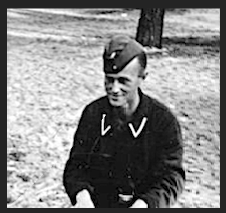 ube video, Hamilton-Baillie’s son, Ben demonstrated his father’s invention with a replica of the scale model Jock Hamilton-Baillie presented to the escape committee.
ube video, Hamilton-Baillie’s son, Ben demonstrated his father’s invention with a replica of the scale model Jock Hamilton-Baillie presented to the escape committee.

It’s an excellent explanation which I summarize here: The ladders were ingenious in both construction and improvisation of materials. The apparatus was in two halves which fitted together – the first a simple ladder with widely spaced rungs and a hook at the top to engage the overhang of barbed wire. The other part was a basic running board, with duckboards and a swing bar at the far end for the men to hang on to and drop off the remaining eight feet to the ground.. The two parts fitted neatly together, one on top of the other whilst they were hidden away. It was estimated that the ladder apparatus could be assembled in about fifteen seconds and fifteen men could get over in ninety seconds. It was to be constructed out of long, two inch thick timbers taken from a hut’s ceiling and bed boards.

When the escape was launched, the ladders were to be carried out and leaned against the top of the inner fence, and hooked into place over the wire. The running board section which fitted over the basic ladder was pushed up and until it cantilevered across the wires to rest on the top of the outer fence. Short ropes on either side of the ladder and duckboard section were tethered to the wire to prevent the two sections from further movement.

130 feet of timber was needed for each apparatus, The ladders, constructed from purloined roofing beams and bed slats. 100 nails and 12 feet of rope to be acquired, assembled, and hidden. As the two joined sections slotted rigidly in place, the plan was for a team of men to climb the ladder, crawl along the duckboard, and jump off after swinging on the trapeze bar at the other end, close enough to the ground to drop without injuring themselves. It was estimated that the prefabricated ladder apparatus could be erected in about fifteen seconds and a dozen men could get over in ninety seconds. Hamilton-Bailie’s demonstration convinced the escape committee that a mass escape was possible if all the elements came together and development commenced.
Rushing the wire at night would be suicide unless the camp’s lights were disabled for the crucial period of the escape. At each corner along the perimeter fence stood a guard tower, eighteen foot high, fitted with a powerful searchlight, linked by field telephone to the central guardhouse, as well as sporting a belt fed machine gun that could spit out 900 rounds a minute. The solution came from Captain Ken Searle, a Royal Army Ordinance officer with some knowledge of electrical engineering. Captain Searle took regular walks along the fence line, noting the visible portions of wiring circuits for the perimeter’s floodlights, the guard tower searchlights, and sentry box telephones.

One day on the north side of the camp, Captain Searle was surprised to notice that the main overhead electric feeder supplying the boundary lights had been installed with a major error. From the “security ring main” mounted on a floodlight pole, extended an “unfused spurline” over the fence line into into a hut used by POWs as a cobbler’s workshop during authorized hours. The unfused spurline offered POWs direct access to the main electrical control panel in the German guardhouse.

The cobbler‘s workshop also contained the camp’s sewing machines, and a barber’s shop .The Germans as a goodwill gesture permitted prisoners access by day, so they could get their uniforms and boots repaired, and obtain regular hair cuts. A sentry patrolled the hut during access hours, and it was locked at night. Searle recruited fellow RAOC Captain Ron Moulson, an electrical engineer for a second opinion. Moulson confirmed the Germans had inadvertently provided savvy prisoners with the ability to control the local perimeter lights at will, if they could gain access to the cobblers’ workshop. The “Olympia” committee devised a plan.

Each day prisoners were permitted entry to the cobblers’ hut to conduct their repairs watched by an armed sentry just inside the door. From a hook on the sentry’s belt, dangled the iron key to the hut. The first step was to copy the key. The two intrepid RAOC Captains, Moulson and Searle, volunteered for the mission.
This kind of spy crafted subterfuge has been dramatized many times in screen fiction. But can any movie adequately reflect the tension Moulson and Searle must have experienced, during the actual operation: best described as the undiscovered snatch/copy/rapid replacement of a forbidden item. The penalty for discovery was a long spell in the cooler, and possible transfer to a concentration camp if the authorities wanted to set an example. Several rehearsals took place, using other POWs as role players to create the necessary distraction to the guard. One fumble, and German attention would be drawn to what prisoners intended at the cobblers’ hut, which could be fatal to the whole escape plan. No pressure, of course.
The cobblers’ hut offered a social venue as well as a repair center. It was crowded with officers, chatting and joking, as mallets hammered and tools whirred. Noise would assist in distraction. Captains Moulson and Searle, shadowed by their team, sidled up behind the guard on duty,, and studied how the keys hung from the hook on his belt. On a signal from Searle, two of the team then created an argument nearby. Angry shouting developed into pushing and shoving. The guard stepped forward to separate potential combatants. POWs crowded round. In the jostling scrum, the guard was unaware of being relieved of his key. Searle was the the pickpocket, passing the key to Moulson who immediately pressed both sides into a tobacco tin filled with homemade wax, created by melting German ersatz soap and Red Cross margarine together. Within seconds a wax impression was made, before the key was replaced on the hook of the guard’s belt. Within a day a duplicate key was created by one of the camp’s amateur locksmiths.
With regular access to the hut achieved, the method for shutting down the camp’s lights had to be tested without arousing suspicion. This was best conducted on a night when the sounds of distant Allied air raids could be heard. They were often accompanied by intermittent blackouts, to which this test could be attributed.
Moulson and Searle devised a simple hand made device involving a pair of arcing horns they would attach to the incoming power cables that fed the various machine tools in the cobblers hut. In theory, a metal shorting bar mounted at the end of a long insulating wooden pole could be laid across the arcing horns, blowing targeted fuses on the main control panel in the adjacent guard house. In this way, some or all of the camp’s power could be shut down on cue.

One night in May 1942, guided by a screen of lookouts, Moulson and Searle evaded sentries and infiltrated the cobblers hut. In their rucksacks they carried dark cloths to black out the windows so they could work by torchlight. They brought insulating wire, removed from the camp’s PA loudspeakers used to disseminate Nazi propaganda. Aluminum rodding and copper were purloined from the service truck that came to repair the loudspeakers. They tested their device to short out only a designated section of the perimeter, so the Germans would regard it as an anomalous glitch. To maintain the secret, Moulson and Searle removed all trace of their activities, even sprinkling wiring they had replaced with dust that they had collected in a small tin, so the wiring looked untouched. They slipped away, locking the door behind them with the duplicate key. Such attention to detail.
The Olympia committee learned that it took the Germans 30 minutes to repair the blown fuses in the adjacent guard house and restore the flood lights, a bonus that would add further time to the the blackout obscuring the escapers. Next a secure place needed for storage of the scaling ladders and training in their use. Another venue where groups of POW were allowed to congregate, was selected, the musician’s hut.

The camp authorities allowed prisoners to form musical groups, including an orchestra, a jazz band, and a choir. They designated a hut for this purpose, and permitted musical instruments to be sent into the camp. The musician’s hut proved ideal for concealing the scaling ladders in plain sight, attached to the walls as shelving for sheet music and instruments. This ruse evaded detection by Major Radermacher during two hut inspections.
The musician’s hut became the venue for testing each assembled ladder and training the designated escapers in their navigation while carried packs weighted to approximate their evasion essentials. The noise of ladder assembly and practice was deadened by loud music practice. Each apparatus was dyed purple with indelible lead dye for camouflage at night. Again, such attention to detail. Over the next weeks, four separate teams of eleven men were assembled and trained on the rapid assembly and deployment of the apparatus. One anchored the ladder and remained while ten went over. They practiced clambering up the widely spaced rungs, navigating the duckboard, grasping the swing bar, and dropping safely to the ground, in a section of the hut blacked out to create the handicap of darkness . The goal was: up and over in 90 seconds. Escape committee records indicate “ Smith” was a member of Team Four.
As more elements fell into place, it became feasible for the “Wire Job” to be combined with a tunnel as a simultaneous mass breakout, something that guaranteed a disruption to German troop movements. A new tunnel at Hut 13 had been progressing well, aided by a jerry-rigged lighting system tapping into camp’s power. When the Germans started transferring RAF POWs to other camps, final preparations for the joint operation began. Discreet rehearsals were conducted of the various distractions – to be staged when the lights went out – to deflect the attention of the Germans to the opposite side of the camp to the “Wire Job” was taking place. In the final days before the selected date, the designated escapers prepared their civilian clothing. acquired provisions, and planned their routes out of the region. The area between Huts 20 and 21 was chosen for the assault on the wire 15 yards away..

On the morning of August 30, there was a tragic accident in the Hut 13 tunnel. A new volunteer, Lt. Dupree, working in an inch of water, accidentally touched a live cable in the jerry-rigged lighting system and was electrocuted. Guards were called to help retrieve the body. With the tunnel sealed, the camp authorities believed the latest escape plan was over; the possibility of another the same day unlikely. They hoped the misfortune would serve as a salutary lesson and convince POWs to accept their confinement and stop risking their lives.. The escape committee were obviously shocked and saddened. They considered postponing “Olympia” out of respect, but as transfers from their ranks to other camps were happening daily, they decided to continue the escape that night as planned. Zero Hour was set for 9.20 pm.
Prior to the 11pm curfew, prisoners could walk freely around the camp. This enabled a protective screen of stooges to guide all four teams past patrolling sentries as they moved the scaling ladders from their hiding place in the roof of Hut 27, to Huts 20 and 21. By 9pm they had assembled the ladders and greased their runners with kitchen fat. And waited.
Similarly, those intrepid electrical saboteurs Captains Moulson and Searle, wearing dark clothing and balaclavas, stealthily moved through the shadows to the cobblers hut, which they entered using the duplicated key. Once again they blacked out the windows, and using a weak torch beam, attached their newly designed shorting hooks to the exposed wiring. It would be triggered once they received a lamp signal from the west of the camp that everything was in place.
The loss of a fellow POW who gave his life trying to expand the escape must have weighed heavily on the minds of each team member waiting for the Go signal, sharpening their resolve to be successful. The tension in that last hour for all those involved must have been tightly wound.
WW2 historian Mark Felton’s book Zero Night gives an extensive and vivid account of the escape, with eye witness accounts from a number of the survivors, but other than my father’s place on Team 4, he is not mentioned.
Zero hour of 9.20 passed.
At 9:25 the camp lights went out. Searle and Moulson delivered as promised.
At the opposite end of the camp to where the wire was to be scaled , the planned diversions went into operation. Two ladders, painted white to catch sentries attention, were leaned against the fence. Grappling hooks embedded in the wire at several points were pulled by unseen hands . Long sections of the fence rippled as the wires vibrated through the holes in their supporting posts, giving the impression that multiple ladders were being mounted along the wire. To add to the confusion, two British officers with German speaking skills began shouting contradictory orders to the sentries running to investigate. In nearby hats, prisoners in the middle of the camp began playing the musical instruments, banging drums, creating a cacophony to disguise the sound at the opposite side of the camp of the scaling apparatus being raised into place and men clambering over the wire.
The first three teams had no problems. Within 40 seconds 32 men got up the ladders, across the wire, and scattered across the adjacent field. However, Team Four suffered bad luck. After two men had made it across, either the ropes locking the duck board bridge to the ladder failed, or rungs of the ladder were defective and collapsed due to faulty assembly. My father was one of eight men dressed in civilian clothes trapped outside his designated hut. All hell broke loose. Once camp authorities discovered the true direction of the escape, sentries fired randomly into the darkness. One the few details my father mentioned about this moment in his life was of the sound of bullets impacting the ground beyond the wire nearby.
One response to a mass escape could have been machine gun fire from the guard towers, But the escape committee calculated that guards would refrain from randomly spraying the darkened fields beyond the perimeter, in order to protect the German patrols known as “Deep Field.” But individual sentries might shoot at a fleeing figure. It was a risk the escapees were prepared to take. As it it turned out, only one POW running from the wire was wounded in the heel. A “Deep Field” patrol inevitably caught 4 of the escapees. 32 POWs vaulted the wire. 6 were recaptured within minutes, 26 became “gone aways” in POW parlance. 23 of them would be caught over subsequent days and weeks. Major Albert Arkwright, Captain Rupert Fuller and Major Francis Edwards. made it back home after finally crossing the Pyrenees via the Comete Escape Line. My father and the other Team 4 members made it to the cooler, for violating curfew where they spent ten days on bread and water. The luck of the game.


How my father coped with this disappointing outcome after months of training, made more painful by the death of a colleague, I do not know. Growing up, I watched my father take life’s disappointments quietly with little complaint, never to brood, but to shrug, and keep pushing forward in his endeavors. It was an attitude forged in prison camp life.
From a historical perspective, one wonders what might have happened if the tragically curtailed tunnel escape had also gone ahead as once planned, alongside the “wire job”, releasing maybe a hundred or more Allied POWs into the German countryside? Would Hitler’s deadly response to the mass escape in 1944 have been provoked in 1942 if the “Olympia” breakout had released more than 32 prisoners? Luckily, on this occasion, the captured escapees were not treated badly, beyond a spell in the cooler. And three men made it to freedom, a morale booster to the Home Front.

Released from the cooler, my father returned to the monotony of captivity. He said little about these days other than “cold, tired, and hungry”. He rejoined the general support system for escapers. When another disruptive escape was planned, he was going to be part of it.
****
The war ground on. There were successes and setbacks, like Operation Jubilee., In August 1942, POWs learned of the Allied raid on the French coastal port of Dieppe.

It was a trial run for a future invasion of occupied Europe, with a subsidiary intelligence operation overseen by Lord Mountbatten and future James Bond writer Ian Fleming to capture an Enigma decoding machine from German HQ in the town. The code breakers at Bletchley Park had successfully breaken into the three-rotor Enigma machines for the encryption and decryption of secret messages. Everything changed on February 1, 1942, when the Germans introduced the four-rotor Enigma device – instantly blacking out Bletchley Park. According to British naval intelligence files, a “pinch raid” was necessary. to crack the four-rotor Enigma machine, A successful pinch would mean secretly stealing parts of the machine, code books and setting sheets without the Germans knowing..
Operation Jubilee was a fiasco. The RAF lost 106 aircraft. the Royal Navy lost 33 landing craft and a destroyer. Tanks were trapped on the beach and infantry largely prevented from entering the town by obstacles and German fire. But it was the fiasco that the planners of D-Day needed to prevent a future disaster.

Within 10 hours, 3623 of the 6086 men who had landed had been killed, wounded or taken prisoner. The cost was high but the Allies learned important lessons regarding coastal assaults that would influence the D-Day landings. Better to create an artificial harbor than to capture a well defended port. Tanks were developed specifically for beach landings. Air support strategies were improved.

This was of little consolation to the many Canadians captured in Dieppe who arrived in Offlag V1-B, to find they were to be collectively punished for war crimes. After the raid, Germany claimed to have found two of their garrison with their hands bound, shot dead. They accused Canadian units of being involved. Orders came down from Berlin that for a period of weeks Canadian POWs from Dieppe were to be manacled 8 hours a day as a reprisal. Disapproving guards often left the manacles unlocked. The practice soon came to an end, but the war ground on. Hopes for substantial progress came in November 1942.

Field Marshall Bernard Montgomery emerged as Britain’s leading General with his decisive victory over Rommel’s Afrika Corps in the Libyan desert.

The upbeat conclusion to 1942 resulted in a British magazine publishing this cartoon mocking the claim Ribbentrop made in 1941.

The Reichminister for Foreign Affairs, Joachim Von Ribbentrop had been German Ambassador to Britain the four years before war broke out. Ribbentrop was deeply hated within the British establishment. Intelligence reports had surface during the Abdication crisis of 1936, subsequently confirmed by an FBI informant, that Ribbentrop had conducted an affair with American divorcee Wallis Simpson, while she was also the future King Edward’s lover. Both Simpson and the King were admirers of Hitler. After Edward abdicated the throne, the couple visited Germany and were entertained by Hitler and other senior Nazis, who planned to re-install Edward as a pro-German King, once the future war with England was won. Ribbentrop was tried for war crimes at Nurenburg and was hanged.
 .
.
It would take till June 1943 before Montgomery’s victory at El Alamein provided the springboard for the invasion first of Sicily, then the Italian mainland.

STALAG LUFT THREE
In April 1943, my father was transferred to Stalag Luft Three, in Silesia, Poland, a major new camp for Allied Prisoners of War, which now included Americans.The Sagan district was chosen because its sandy soil would discourage tunneling. Here’s an RAF aerial view in 1944. Spanning sixty acres, the camp ultimately housed a total of 10,949 RAF and USAF prisoners in separate compounds inside 5 miles of perimeter fencing.


Thick pine forests flanked all sides of the camp. The only other evidence of civilization was a small road which ran off toward the nearby town of Sagan.The site was selected for its loose sandy soil, impeding the structural integrity of any tunnel the POWs might dig. Barracks housing POWs were constructed 24 inches off the ground. Seismograph microphones were placed around the perimeter of the camp to detect any sounds of digging. The North Compound consisted of fifteen wooden huts, each one divided into sixteen rooms which housed around eight men, plus three sets of private quarters for senior officers.

The compound itself was a square of about a 1000 feet in both directions, hemmed in by two layers of barbed-wire and guard towers positioned at regular intervals. Armed guards manned the towers night and day, and patrols continuously circled the perimeter. A warning wire ran close to the inner fence. The prisoners were warned not to stray beyond that wire under threat of death.
The German guards that specialized in escape detection were known as ‘ferrets’. They could search any hut without warning. Using metal probes, they looked for traces of yellow sand indicating that a tunnel was in progress, or an English-speaking ferret would lie concealed under a hut listening for careless talk. Their most active, unpredictable, and feared ferret, Gefreiter (Corporal) Greise, was known as ‘Rubberneck’.

Douglas Bader had been moved to Stalag Luft Three by August1942. But he was gone by the time my father arrived. Bader’s physical condition made his likelihood of reaching a neutral country remote. The Escape Committee turned down the various schemes he submitted. Bader once again channeled his frustrations into “goon baiting”, which sometimes resulted in excessively long role calls in cold weather, and a growing unpopularity within the camp. Within three months he was transferred to another camp at Lamsdorf. After a failed escape attempt there, was sent to the escape proof Colditz Castle, till the end of the war. Here he is seated at the center of the front row. Naturally.

Stalag Luft Three was a new camp also intended to be escape proof,


Each compound consisted of fifteen single-story huts. Each slept fifteen men in five triple-deck bunks.


Living conditions were an improvement on Offlag V1 B. Here’s a group of RAF officers who have made their cramped quarters as functional as possible.
 INSERT:
INSERT:
My father joined the Stalag Luft Three escape committee upon arrival. From May 1943 till January 1945, he “assisted with wireless security”. The camp’s illicit radio was hidden next to his room. He devised a a secret compartment to conceal the radio in the underside of a tabletop, when a search was imminent. The radio remained undiscovered till the camp was evacuated for the The Long March in January 1945.


As Kommandant, the Luftwaffe appointed Freidrick Von Lindeiner, 61 an educated man, who spoke good English. Lindeiner joined the army in 1908. In World War 1, he was wounded three times .and was twice awarded the Iron Cross. In 1919 he married a Dutch Baroness. In 1937 he joined the Luftwaffe in 1937 as a member of Goering’s personal personal staff. He was old school, a patriotic German but not a Nazi idealogue.

In May 1942 Goering posted him to Sagan as Kommandant of Stalag Luft Three. Goering knew that escapes were inevitable, particularly among flyers, but they must not become embarrassing. Von Lindeiner believed that the best way to discourage escapes was to improved ration and expand social amenities. Then prisoners would see the wisdom of waiting out the war in tolerable conditions without taking further risks with their lives. To assist in creating a sense of society, he allowed POWs to have their own currency.

Red cross parcels of medical supplies increased.

Athletic and competitive sports events were a regular fixture. County Cricket matches were held just as they would have been in British towns and villages every summer Sunday.

United States Air Force officers and crew shot down in bombing raids over occupied Europe had been arriving at Stalag Luft Three in increasing numbers.


These pictures were taken at the new South compound to which the USAF POWs were moved. 
There were two toilets per forty men.

POWs were encouraged to spend time in a substantial library with schooling facilities, where they could study languages, engineering, even law. The exams in those subjects were supplied by the Red Cross and supervised by former academics, including a Master of King’s College, who became a POW in Stalag Luft Three. The prisoners used the camp amplifier to broadcast a news and music radio station they named Station KRGY, Kriegie being short for Kriegsgefengener , the German term for prisoner of war. Two newspapers, The Circuit and Kriegie Times were issued four times a week.

American airmen were swelling the numbers of arrivals. Some left pregnant wives behind. This newspaper for the American section of the camp celebrated recent new borns.

An important development in keeping POW spirits up was Lindeiner’s permission for them to build a fully professional live theatre and cinema. The Red Cross supplied materials, and 16mm prints of movies. By providing the distraction of regular entertainment they enjoyed before captivity, Lindeiner hoped to divert their energies away from escape. A POW sketched the design.

Lindeiner imposed conditions – the theater could never be used for escape attempts. The British agreed. (There was a slight fudging of this rule, as revealed later) The Red Cross supplied materials, and 16mm prints of movies. The prisoners put on bi-weekly performances featuring all the current shows playing on London’s West End Theaters. Libretti and music scores were supplied through the Red Cross. Special performance were staged for German personnel.

Performances in female attire were popular.

Several POW’s who performed at these shows would become successful actors after the war, and were often in movies and TV shows I would see growing up in England, unaware they had shared the same prison camp as my father.

Denholm Elliot (multi award winning actor – Trading Places, 2 Indiana Jones movies) formed a theatre group that was so successful it toured other POW camps playing Twelfth Night.

Donald Pleasance, ( Halloween, You Only Live Twice, among 242 screen roles ) was a wireless operator for Bomber Command. After flying nearly sixty missions, his Lancaster was shot down over France. He became a POW at Stalag Luft Three a few months after the actual escape. Decades later Pleasance had become a star character actor and was cast as ‘ the forger’ in the movie version of The Great Escape. On the set, he offered director John Sturges some advice on authenticity. He was politely told to keep his “opinions” to himself. When Sturges found out the actor had direct experience in a real POW camp, he apologized and requested his input. Before the war, Pleasance had only acted for a small repertory theater before enlisting. At Stalag Luft Three, he produced and acted in many plays and sketch shows, some alongside a Royal Navy officer Peter Butterworth. who had survived ditching in the North Sea before capture.

Throughout his imprisonment, Fleet Air Arm Pilot Officer Butterworth provided support to many escape attempts, including the one portrayed by the book and film “The Wooden Horse”, in which prisoners dug a tunnel concealed under a vaulting horse positioned near the perimeter fence.


Butterworth was one of team the vaulters who would practice gymnastics for hours,. Guards would pass by, oblivious to the tunnel being dug beneath.

Made from plywood Red Cross parcels, the horse was carried out each day with tunnelers concealed inside. carried back to their hut hours later, with the earth they had excavated. Butterworth and other POWs concealed bags of earth inside their clothing, and walked around dispersing trickles of soil unnoticed by guards. Butterworth later auditioned for the movie in 1949 but “didn’t look convincingly heroic or athletic enough” according to the makers of the film.

Butterworth, teamed up with Pilot Officer Talbot Rothwell, a town clerk and policeman before the war, to persuade Kommandant Lindeiner to allow them to build a theater where they could stage musical comedy shows for fellow POWs that would benefit camp morale. Butterworth had never been a performer and Rothwell had never thought of writing before, but both men enjoyed traditional British Music Hall humor, epitomized by top pre-war acts like The Crazy Gang.

After the war Talbot Rothwell would write gags for The Crazy Gang before becoming a a successful playwright and screenwriter, penning twenty of the Carry On series that were popular in Britain during the 1950’s and ’60’s. Peter Butterworth became a successful comedy actor. Rothwell would cast him in sixteen of the Carry On films.
Carry On sketches that mocked authority figures, and dialogue peppered with double entendres got their start at the Stalag Luft Three Musical Theatre.

POWs would send home reports of their daily life. filtered through the camp’s censors, hoping to make their loved ones feel less anxious about their welfare. This would result in a perception among some on the home front of prisoners enjoying a comfortable life in a German holiday camp. The constant stress of captivity was not understood; some felt – they’d had it easy. Some POWs , my father among them, returning to a Britain scarred by five years of collective bereavement. My father, once liberated, could sense that POWs were not regarded in the same light as other returning servicemen who had also faced the enemy. When their stories were finally known, it became clear how much Allied escape attempts from prison camps across Europe had disrupted German troop movements.The biggest POW disruption of World War 2 – dubbed The Great Escape – would be the brainchild of RAF Squadron Leader Roger Bushell.

Roger Bushell was born in South Africa, educated at Wellington College, a British public school founded in the name of one of England’s most celebrated generals. the Duke of Wellington. By co-incidence, Wellington College would be my school too for five years in 1959. An all round sportsman, Bushell excelled at rugby, going on to captain the university skiing team, while studying law where be won the slalom event of the annual Oxford/Cambridge Ski Race in 1931. But, like my father, his real passion was the adrenalin rush of flying.
In 1932, while still qualifying as a lawyer, Bushell joined the Auxiliary Air Force, (AAF), Squadron 601, known at the time as “The Millionaires’ Mob” because of the number of wealthy young men who paid their way solely to learn how to fly during training days, often on weekends. While rising from Pilot Officer to Squadron Leader in eight years, Bushell built a reputation in criminal defense, often involving pilots charged with dangerous flying. One pilot he successfully defended, Paddy Byrne, would later be incarcerated with Bushell at Stalag Luft III. Bryne is on the right of Squadron Leader Bushell, beside Lt. Eberhardt (German security). Note the cordial smiles. The Luftwaffe had respect for fellow fliers, and treated their POW’s better than the German Army. Paddy Bryne is smiling too. He’s plotting his unique escape.

In 1944 Bryne feigned insanity so successfully that he convinced the Germans and the repatriation board that he was completely mad, and under the terms of the Geneva Convention should be be repatriated. Back in England, Byrne’s sanity immediately returned. He was readmitted to the RAF and given a ground position. It would not surprise me if his former RAF lawyer, Roger Bushell had a hand in tutoring his performance.

Pictured here days before his capture, Bushell’s first engagement with enemy aircraft came on 23 May 1940, while on patrol over Calais to assist with the Dunkirk evacuation. He was credited with damaging two ME 109s before being shot down himself He crash-landed his Spitfire on German-occupied ground and was captured before he had a chance to hide. It is said that this incident was recreated in Christopher Nolan’s movie Dunkirk, with Tom Hardy as one of the early fighter pilots to go ” into the bag.”

Escape became Bushell’s obsession. In his first attempt in 1941, he was recaptured a hundred yards from the Swiss border. His second escape involved jumping from a train, transferring POWs to another camp. as it stopped briefly in Hanover. Fellow escapee Czechoslovak Pilot Officer Jaroslav Zafouk made contact with the underground movement. A family sheltered them for eight months before being betrayed and executed by the Gestapo, including the daughter of the household with whom Bushell had become involved. Under interrogation, he was beaten by the Gestapo, then sent to Stalag Luft Three, warned that if he escaped again he would be shot. Bushell channeled his rage at Gestapo brutality into devising the most ambitious escape of the war, something Hitler would notice.
On arrival at Stalag Luft Three in November 1942, Bushell was the camp’s most experienced escaper. He quickly took over control of the escape organization, known as “X”. and inherited the code name “Big X”. Big “S” , in charge of security, was an American Lt. Colonel Albert Clark. He co-ordinated the stooges, the network of POWs that monitor the guards’ movements throughout the day. In parallel the “Y” organization, was responsible for forging identity documents, creating maps, and civilian clothing, utilizing the skills of former tailors and artists. There was also Z organization, most secret branch of the escape committee, with control over the camps’ illicit radio , and the codes to communicate with RAF intelligence back in England. Wing Commander Smith, assisting with wireless security, was part of this organization. What his duties were he never told me.
Bushell’s experiences on the run for months in occupied Europe and his treatment by the Gestapo left him with an implacable hatred for the Nazis. All Germans, including Kommandant Von Lindeiner, were the same to Bushell. Drawing on the oratorical skills he acquired as a defense counsel, Bushell addressed the full escape committee and reminded them of their duty in the kind of forthright terms that would resonate with men who, like himself, had somehow survived being shot out of the sky. These are his reported words:
“Everyone here in this room is living on borrowed time. By rights, we should all be dead! The only reason that God allowed us this extra ration of life is so we can make life hell for the Hun… In North Compound we are concentrating our efforts on completing and escaping through one master tunnel. No private-enterprise tunnels are allowed. Three bloody deep, bloody long tunnels will be dug – Tom, Dick, and Harry. One will succeed!”
The most radical element of the plan was not the scale of construction, but the sheer number of men that Bushell intended to pass through these tunnels. Previous escape attempts at Stalag Luft Three had involved the escape of between 10 or 20 prisoners, but Bushell was proposing to get over 200 out, each of whom would be in civilian clothes,carrying forged papers and escape equipment. A massive level of organization was required, ultimately involving 600 POWs.
Bushell introduced strict security measures. New POWs to the camp were vetted, to prevent German agents from infiltrating their ranks. Any POW who could not be vouched for by two POWs who knew the prisoner by sight was seriously interrogated and afterwards escorted by other prisoners, until deemed to be a genuine Allied POW. Several infiltrators were discovered by this method. The operation was so secretive that everyone was to refer to each tunnel only by its name. Bushell took this so seriously that he threatened to court-martial anyone who even uttered the word “tunnel”.
Every POW in the North Compound was part of the collective support system. German guards were followed everywhere they went by prisoners, known in POW vernacular as “stooges”, who used an elaborate system of signals to warn others of the guards’ location. The guards’ movements were then carefully recorded in a logbook kept by escape committee officers. Unable to stop what the prisoners called the “Duty Pilot” system, the Germans allowed it to continue and on one occasion the book was used by Commandant von Lindeiner to bring charges against two guards who had slunk away from duty several hours early. Bushell is photographed here with a fellow member of the escape committee.

When he joined the RAF in 1932, Bushell probably received flight training from my father who had just returned to Flying School as an instructor nine months after leaving as a pupil. In the 1930’s, the RAF was a relatively small and quite social organization. Over the next eight years the two men undoubtedly rubbed shoulders, particularly when Bushell received flight training on the new Hurricane and Spitfire. When they met again in Stalag Luft Three, my father joined Bushell’s corps of escapers, Building on his experience in the Warburg Wire job, his role would have been in logistical and supervisory support. The operation would take a year.

In the 1963 movie The Great Escape, based on the book by Stalag Luft Three POW Paul Brickhill, fictional characters were created for Hollywood stars Steve McQueen and James Garner, along with fictional action scenes including Garner stealing a plane, an incident purloined from the “Delousing Break” which took place in June the previous year. Scenes of McQueen leaping his motorbike over barbed wire fences were written to persuade the motorbike fanatic to take the starring role. Perhaps, because of the level of fictionalization, the studio decided to change all the actual participants names. Roger Bushell, Big X, was represented by Richard Attenborough’s character, but named Roger Bartlett. The small facial scar Bushell retained from a skiing accident, was replicated in the actor’s make up. Attenborough certainly captured Bushell’s reputed hard driving style. I will summarize what was good about the movie and what was inaccurate and what my father thought about it in a later section. The true story of The Great Escape deserves the kind of in depth exploration that only a high quality streaming series can provide.
There is a wide variety of granular detail about The Great Escape available in the AIR40 section of the Public Records Office, in Kew, London. Notable is AIR40/268 which is the official history of Stalag Luft III, and other documents in the ranging from AIR40/2265 to AIR40/2293, which refer in great detail to the investigation into the aftermath of the escape, as well as fascinating minutiae of Camp life, such as correspondence between Kommandant Lindeiner and the Senior British Officer at Stalag Luft Three, and many preserved internal documents, all of which are well worth a browse. As well as the National Archives, I recommend https://www.stalagluft3.com/. So I’m just going to navigate the weeds of the operation in broad strokes, and pick out details that show the incredible ingenuity and resolve of all those involved.
The collective skills of 600 POWs was brought to bear. Maps, identification papers and travel passes were obtained by bribery or theft then copied by forgers. The latest escape kits contained compasses made from melted fragments of broken Bakelite gramophone records, and incorporating a tiny magnetized needle made from a slivers of razor blade set on a cork swivel. A small speck of luminous paint from the face of a broken wrist watch was glued to the tip of the needle to indicate north at night. Stamped on the underside was ‘Made in Stalag Luft 3 – Patent Pending’.This particular escape committee department department was known as “Dean and Dawson”, after a well-known firm of London travel agents.
A surprising number of guards proved susceptible to cigarettes, coffee or chocolate. In one case, a less than intelligent guard provided key information for which he was paid in chocolate. The prisoner asked him to sign a receipt, explaining that it was necessary to account for the chocolate with the others in his mess group. The guard obliged, and was soon blackmailed into bringing in a camera and film, Bushell being quite ruthless in exploiting such opportunities.


Guards and ferrets could enter the compound at any time and search any hut without warning. With metal probes, they searched for the bright yellow sand of a tunnel in progress, or an English-speaking ferret would lie concealed under a hut listening for careless talk. A roster of officers, my father among them, logged every guard or ferret entering the compound .It was called the “Duty Pilot” system,. The Germans were tailed everywhere, their movements timed and logged in a book. Flying Officer Geoffrey Willat did many “Duty Pilot” hours identifying guards or ferrets and putting up the requisite signal, to warn other watchers round the camp – the signal comprised an empty tin in a certain position on a nearby rubbish heap. In an interview Willat recalled an encounter with the camp commandant.
“I was in fact accosted by Von Lindeiner who saluted me as he always did, to know why I was out in the freezing cold. I said it was for fresh air and exercise and gave a false name and number. I never heard any more.”
Three tunnels, named Tom, Dick, and Harry, were dug for the escape. Tom began in a darkened corner next to a stove chimney in Hut 123 and aimed west into the forest. Dick’s entrance was hidden under a secure trap door in a drain sump in the washroom of Hut 122, which was searched many times by the ferrets, but never discovered even by the most dreaded ferret, Rubberneck. The entrance to Harry, hidden under a stove in Hut 104, was only found the morning after the escape.
Flying Officer Wally Floody, a Canadian Spitfire pilot and prewar mining engineer, masterminded the construction of all three tunnels, .The tunnels had to be, as Bushell put it, “bloody deep”, 30 feet below the surface to hamper tunnel detection from the buried microphones that ringed the camp. This was view from the bottom of one shaft, from where the tunnel commenced.

The sandy walls were shored up with wood scavenged from all over the camp. Of the twenty bed boards normally supporting a mattress, prisoners gave up all but eight.

At the base of the shaft, to ventilate the tunnel, chambers were dug to house a manually operated air pump and bellows made with hockey sticks, ping pong bats, and knapsacks.

The air ducts were created by soldering together hundreds of Klim powdered milk cans as piping connected to an improvised air pump and bellows. Other Klim can byproducts included scooping tools for the diggers and candle holders. The ersatz wax was made from fat skimmed off the camp soup, lit by wicks made from pyjama cords. Perhaps modern day recycling was born in Stalag Luft Three.

Tools were acquired by theft or smuggling.

The work shops excavated at the base of each shaft were used for building the timber supports for the tunnel, as well as the wooden tracks and trolleys of rudimentary railways. Running on flanged wheels, these carts were designed to get men, tools, and debris back and forth along the tunnel in a fraction of the time it would take to crawl.


Among the many tunnelers who worked Tom Dick & Harry was an American William Ash who joined the Canadian Air Force in 1940 to join the fight against Hitler. His Spitfire was shot down near Calais in 1942 but he evaded German forces for months with help from the French Resistance. Eventually captured and beaten by the Gestapo. Ash was sent to a succession of POW camps in Occupied Europe from which he escaped on a regular basis,
In his memoir Under The Wire. William Ash conveys the stark reality of tunneling under the latrines at Schubin,
‘Entering the tunnel was a daily experience of horror. Each trip down required a little more courage, and the need to blot out the thought of all those tons of earth pressing down on you, knowing that a cave-in would leave us trapped, breathing mouthfuls of mud and unable to go backwards or forwards.
The presence of light became important, not just to work by, but to steady our nerves and remind us that there was a world above with sky and fresh air, waiting for us to return.
We worked on in stifling darkness, trying not to think about the amount of unstable earth directly above our heads. It is hard to convey the sense of claustrophobia that comes from an hour of stabbing away at a wall of Polish mud so narrow that you can only get one arm forward to work on the face and which stretches back behind you so far that it takes half an hour to wriggle back to safety and sanity at the tunnel start. The experience assaults every sense. We felt the cold clay around us, pressing in on us and seeping into our bones until we almost became part of the tunnel. The loss of sight in the darkness when the lights went out was total. No glimmer of light had penetrated that wall of mud in a million years. Even when the margarine lamp flickered, it only served to emphasize the blackness around it – what Milton once called “darkness visible”.
When a shower of earth fell from an unshored roof: it filled the mouth of an unfortunate digger, gaping wide for oxygen in the stale void of the tunnel.’
Nonetheless, on March 5th 1943, Ash and 32 prisoners made it safely out of the tunnel. They were all recaptured, except the two who came closest to a home run. They drown trying to cross from Denmark to Sweden. William Ash went on to dig tunnels at Stalag Luft Three. After the war, he received an MBE for his escaping activities.
Many of the men chose to work naked. Clothing made navigating the tunnel more arduous. Makeshift showers were rigged in the washrooms so that they could quickly cleanse any signs of being underground. Once electric light was installed, the average daily progress on each tunnel was seven to eight feet. The work was divided into two shifts. The first was the actual digging, which usually took place between morning appell (9.30 a.m.) and evening appell (around 5.30 p.m). The second shift which went on into the night concentrated on the disposal of the earth excavated that day. Those tasked with this responsibility were known as Penguins, due to the greatcoats they wore to conceal bags of sand. They would potter about, periodically joining other POWs tilling vegetable gardens. During these seemingly innocuous get togethers, each Penguin would pull a drawstring on a bag in his trousers or greatcoat, let the sand trickle down, then inconspicuously trample it into the fresh earth. My father did his share of Penguin duty. At times when snow covered the ground, the sand was stashed beneath the camp theater, via a hinged seat in the back row.

Camp Kommandant Lindeiner knew that an escape was in preparation. Since the opening of Stalag Luft Three, 97 tunnels had been discovered. It was to be expected. In parallel with the tunneling, Bushell organized a distraction: a smaller mass break out, known as the “Delousing Break. On 12 June 1943. twenty six officers officers escaped by leaving the camp to go to the showers for delousing in the neighboring compound. They were escorted by two fake guards played by POWs in specially created authentic uniforms. Twenty four were recaptured and returned to the camp. The remaining two officers, who had played the guards, were sent to Colditz for trying to steal an aircraft, referenced earlier. The use of fake uniforms and painted rifles carved from furniture was attempted in a number of Allied escapes. In this propaganda picture, German guards wearing the captured men’s greatcoats demonstrate their error. They had made the greatcoats too short.

Bushell was unaware that the Delousing Break had reinforced German efforts to curtail POW escapes, which followed a breakout attempt of 43 British and Dominion airmen from a camp near Poznan in March 1943. This brought about the first wartime Grossfahndung conducted in Germany, best described as a nationwide hue and cry. All branches of the security apparatus were mobilized. Directed by the Reichssicherheitshauptamt HQ in Berlin, the Gestapo operated nationwide as the Secret State Police. Subordinate to the Gestapo were the local police, Kriminalpolizei, the equivalent of America’s FBI or the British CID. Units of the Wehrmacht that could also be mustered to hunt escapees.. Escaped officers’ photographs were published in the German Police Gazette.

The Grossfahndung resulted in arrests across occupied Europe; escaped prisoners of war 809, foreign workers who had left their assigned work places 8,281, other persons wanted by the police 4,825. By this stage of the war the German labor force had been depleted by continuous drafts to her armies. Germany and occupied Europe were filled with large numbers of foreign workers, in addition to prisoners of war from France, Russia, Britain the Commonwealth. The increasing numbers of slave laborers on the run, the rise of resistance groups, and escapes from multiple camps began to cause concern over internal security in Berlin.. They were aware that some POW camps had smuggled in radios, and could hear BBC’s coded messages. Could these escapes have been co-ordinated from London? Could escaped officers link up with partisans to direct sabotage? Were POWs being used to carry on war as a fifth column under cover of their non-combatant status? Actually, there was no such coordination, escapes were a natural result of imprisonment, but paranoia was a fact of life in 1943 Berlin. Heindrich Himmler, chief of the SS. and Reichminister of the Interior, assumed overall control of POW security. He initiated changes in the laws regarding Prisoners of War.
The Igel Order stated that, ‘prisoners moved in bulk must be chained’. In February 1944, the Stufe Römisch III Order stated that, ‘escaping POWs should not be automatically returned to their camps but held in special detention pending consideration of each individual case’ . In early March 1944, another order was issued, stating that ‘all non-British or American recaptured escapers should be sent to Mauthausen concentration camp with a letter “K” appended to their name’. Ostensibly it designated the man a Kreige. In fact it was code . Such prisoners should be immediately executed. It seems Hitler was ready to execute escaping American POWs, but not, as yet, the British. This was the uncertain climate into which Bushell’s multi tunnel escape plan was heading.

In the prisoners’ cartoon, note the rope attached to the tunneler’s ankle, warning of a possible search by ferrets. And collapses did occur. Tunnelers always had back up. Dim candlelight made the going slow, till a resourceful Canadian officer, Joe Noble, pilfered about 600 feet of electric cable from local workmen, hacking it into the camp’s electricity supply, thus providing a simple lighting system within Harry. The three Germans responsible for the wire were later shot by the authorities, as an example for not disclosing its loss. But there were guards who were anti-Nazi and actively assisted prisoners, smuggling in civilian clothing, railway timetables, maps and documents to forge, particularly identity cards.
Forgery was therefore a valuable skill at Oflag V1 B., Documents were stolen or “borrowed” from a prison guard in return for goods lifted from Red Cross food supply storeroom, pictured below. POWs became adept at scrounging, pilfering, bribing susceptible guards and foreign workers, with Red Cross parcels, chocolate, cigarettes.

Once over the wire, the hard part would begin. Escape on foot through hundreds of miles of enemy territory to a neutral country, living rough, traveling mainly at night, would require physical fitness and stamina. Escapers trained for months and were given additional rations to build up a reserve of strength for the journey. An ideal ration pack for a fortnight’s journey was half a loaf of German bread, two pounds of chocolate, two pounds of cheese, half a pound of dates and a tin of Horlicks tablets.. A standard evasion kit contained a pocket knife, a homemade compass, a 10 mile to the inch copied map, four boxes of matches, three handkerchiefs, shaving and washing kit, a watch, an old cigarette tin as a cup,The other essential element was authentic looking travel documentation,
Official Nazi rubber stamps were created by hand carving counterfeit plates.

Without papers that would pass inspection, an escaper had no chance of reaching a neutral country, and the resources put into his escape would be wasted. Civilian clothes, credible papers, and European language skills gave escapers their best chance.

A brief peek into the weeds of POW forgery: The ” acquired document” was then reproduced by teams of experts, before being returned to the nervous guard or foreign worker before his shift changed. To carry out forgery in secret, a stool and something to serve as a small table were placed on top of a larger table, so that the work could be brought as close as possible under the none too bright electric light. A blanket covered the window so that patrolling guards could not see through any chinks in the shutters that were clamped across the windows at night.

The three most desired documents were a Urlaubscheine, a yellow form used as a leave chit for foreign workers; a Ruckkehrscheine, a pink form for foreign workers returning home; a Kennkarte, a general identity card.. These were as a complex as banknotes and some required weeks of work to reproduce. A POW’s photograph would then replace the original.

The authentic documents were copied on tracing paper in meticulous detail. The forged documents were created mainly with brush and Indian ink. Here’s a September 1944 Polish Identity Card , and the POW forgery made from it, back dated to June, ready to be filled out with a new name.

Another example of a forged travel pass. Before and after.


Official police stamps were difficult to fake by hand painting. Convincing metal stamps were eventually created by etching aluminum, cut from a camp cooking utensil, with acid. Cellulose paint obtained from the camp theatre group provided a suitable substance to act as an acid resister for the design. Ordinary table jelly from Red Cross parcels was used as the ink transfer medium.

Foreign currency would be necessary.

A gate pass was hard to forge. This sample, from late 1944.

On the back was a complicated color design almost impossible to replicate.

Expertise in forgery was particularly valuable. Documents were “borrowed” from corruptible guards. Foreign workers allowed access to the camp were helpful, in exchange for cigarettes, chocolate, or Red Cross food parcels. The most desired documents included a Kennkarte, a light grey general identity card , a Urlaubscheine, a yellow form used as a leave chit for foreign workers , a Ruckkehrscheine, a pink form for foreign workers returning home, Some were almost as complex as a bank note and required weeks of work. Draftsmen forged travel documents and maps, tailors created civilian clothing, engineers designed rudimentary compasses for navigation, cooks prepared high caloric biscuits for the escapers, all in support of a massive co-ordinated operation below and above ground.,
***
By August 1943, Tom had crossed the wire. Work on Harry and Dick was suspended and all manpower focused on getting Tom to reach the tree line in six weeks before a contingent of American POWs who had worked on the tunnels were moved to South Compound. However, the Germans began to clear the woods for yet another new compound, directly in the path of Tom. An additional fifty yards of digging would still be required to surface within the cover of the woods. The ferrets, aware that summer was traditionally prime escaping time, intensified the daily search and surveillance efforts. Sand was found in one of the gardens, a Penguin was followed back to Hut 123. A guard, probing with a metal spike, found the entrance.

Thus, in September, Tom became the 98th tunnel to be discovered in the camp and destroyed with explosive charges. Work on Harry and Dick stopped until things settled down. In January 1944, Bushell ordered digging to resume. Soon Harry became the only viable tunnel left. The new compound which blocked Tom also lay in Dick’s path. Dick became a workshop and repository for the removed soil.
In February, Commandant Lindeiner sensed that an escape was imminent and feared the consequences. He requested SS Major Erich Brunner, the RSHA special representative for the prevention of POW escapes, to visit Stalag Luft Three to inspect the anti-escape measures within the camp. The men met to discuss the issue, but Brunner made no inspection Nor did he order that the anti-tunneling microphones, recently disconnected, should be reconnected. Some historians believe it was German High Command policy to encourage the escape and then take severe counter measures. After this meeting, Commandant, von Lindeiner, summoned senior British officers, chaplains, and doctors and asked them to end all escape attempts.
“It is not worth it, gentlemen,” he said. “The public temper outside is running very high, particularly against the Allied Air Forces, and escapers may suffer harsh consequences. The war may be over in a year or two … it is not worth taking unnecessary risks now.” Apparently, this was not conveyed in the same explicit terms as the orders, issued by Himmler, the Stufe Römisch III and the Kugel Order, but if the warning was given it was probably based on von Lindeiner’s knowledge of those special orders conveyed by Brunner..
If he did warn the senior British officers, why did they take no notice? Bushell knew he was a marked man by the Gestapo. If caught once again in civilian clothes he would be shot. Bushell accepted that. What he and the whole escape committee did not accept was the possibility of mass execution of escapees. They did not believe that the German High Command would cross that line and flout the Geneva Convention. Then there was the issue of sunk costs. A year of massive effort had been expended. Did the committee believe it would be a serious blow to prisoner morale if they abandoned the escape? This cartoon drawn by Canadian POW Ley Kenyon after 3 years of captivity reflect the urge of all flyers to escape.

The momentum could not be stopped. Digging continued around the clock.
The path of Harry, with the names of murdered prisoners remain commemorated at site of Stalag Luft Three.

A flagstone covered the spot where the stove in Hut 104 concealed Harry’s entrance. Viewed from above, you get a sense of the scale of the operation.

To get beyond the wire 363 feet later, Harry’s tunnelers burrowed under the Vorlager (the German administration area), under the sick bay and the isolation cells, a path the Germans would have considered unlikely and ignored.

RAAF Airman Richard Greenaway sketched this in a fellow POW’s notebook, with accompanying doggerel, depicting Ferrets walking past Hut 104, oblivious to what lies beneath.


Commandant von Lindeiner made another attempt to disrupt the planned escape. He arranged the transfer of prisoners he considered high risk to another camp, believing they were probably ring leaders or key to the planning and logistics of the intended escape. Their removal would at least cause delay. But Bushell’s identity as Big X was a securely guarded secret. He was not selected. Perhaps Von Lindeiner, knowing Bushell was marked for extreme prejudice by the Gestapo, assumed he would not dare escape again. Or did Lindeiner not transfer Bushell – as a test?
With all resources focussed on one tunnel, there was no disruption to Harry’s forward progress. By early March, measurement of the tunnel’s length when compared to the distance from the hut to the wire indicated they had reached the compound perimeter. At a rate of six to eight feet a day, Harry would reach the tree line in 10 days. After March 14 tunnelers started digging a shaft upwards and creating a ladder up the 30 feet to the surface. They stopped when they judged there was only three feet from the surface. Any closer might risk a subsidence if sentries walked over the spot. Harry was ready on March 14th, but a blanket of snow with below zero temperature at night put the escape on hold.

Harry’s exit point was later commemorated. The site still receives many visitors each year.

But by the night of 23 March, Bushell sensed that the ferrets were closing in. He made the decision to break open the tunnel the following night, which would be moonless. The camp’s evening curfew had been recently been relaxed, allowing prisoners to move freely around the compound till a later hour. By coincidence, Uber ferret Rubberneck was away on leave. There would be no better opportunity for another month. The pre-arranged plan for the “crawl to freedom” as it was called, accelerated fast.
Of the 600 POWs who had participated in the escape preparations, it was understood that only 220 could be outfitted and provisioned for escape. The exit order was determined by ballot,.But there was a pre-selection process. Bushell gave the first 30 places to those with German language skills. and previous escape experience, serial offenders, like himself. Traveling in pairs for mutual support, wearing convincing civilian clothes, identity documents and foreign currency, they had the best chance of making it to neutral territory, particularly if they could catch a train from Sagan station before the alarm was sounded.
The next 40 places were given to those whose contributions to the process had been indispensable, In the end, 220 men actively involved in preparations were chosen to escape, my father among them. Most would be hard arsers. They would travel shanks pony, to use an 18th Century Scottish term, common in WW2, referring to the muscle between the knee and the ankle, the shank. They would be hoofing it, with little money, sleeping rough each night. They had little chance of completing a “home run” but believed any disruption they caused to the Nazi war machine was worth a spell in the cooler. Did all 220 men know of the recent severe warnings? My father would have been privy to many communications that took place between the escape committee and MI.9 in Whitehall, via morse code on the camp’s illicit radio, for which he provided security. They all must have known but continued anyway.
Groups of escapers were collected at various assembly points close to Hut 104, then filtered inside, evading the notice of guards in the towers or on patrol. Each escapee’s clothing and belongings were examined for any items that would betray them as POWs. Removed were Gillette razor-blades, and other products . A Polish officer, Pilot Officer Paul Tobolski caused momentary panic when he entered Hut 104 in the fake uniform of a Luftwaffe Sergeant. A big meal was been laid on to fuel the escapers for the forthcoming ordeal in hostile country blanketed in deep snow that awaited them at the far end of Harry. They ate mostly in silence. . Ft. Lt. Ley Kenyon drew this sketch as he waited.

” It was as though impending doom had thrown a shadow to chill the tense excitement in the air” wrote POW Arthur James in his memoir. Prisoners shaved off their beards. They wrote to loved ones back home. Some letters hinted at a possible reunion.
Traveling as many as 220 men a distance of 350 + feet through Harry’s two foot square tunnel required careful planning to avoid log jams. Men were sent down a dozen at a time. Fat candles in the chambers and the halfway houses were refueled in case of a power failure. Officers were positioned at each changing point to co-ordinate traffic. Harry’s railway system eventually comprised three sections, and passengers had to swap trolleys twice to complete the full journey at points named after London Underground stations, Piccadilly Circus and Leicester Square.

Unfortunately, the best laid plans are always subject to Murphy’s Law. If it can go wrong, it will. And remember O’Toole’s corollary: Murphy was an optimist.
At At 8.00 pm, Ft. Lt. Leslie Bull, the leading tunneler at the head of the first wave, found the trapdoory out was frozen solid by the snow fall, the first of many delays that would plague the meticulously organized escape from here on. When the trap door was finally opened half an hour later, Bull peeked out from the top of the exit shaft ladder to find that the tunnel surveyors had made an error in their calculations. The tunnel had surfaced out in the open, 20 feet short of the tree line, potentially visible from a guard tower only 30 yards away. The guard could, if he chose, rotate his searchlight onto the forest at any time. It was the next in a series of compounding problems that would impede the progress of the escape. Peeking over the rim, Bull scanned his surroundings. He could see 20 feet back from the hole towards the trees was a brushwood fence erected by the ferrets to spy on the compound from the outside. Similarly it would provide a good spotter’s position with a 180 degree view of the sentry patrols along the road beside the wire. He passed the information back down the tunnel and requested 50 feet of rope, to be a signaling device between the spotter and men waiting in the exit shaft.
The news was relayed to Bushell. He had two choices. One was to go ahead, get as many out as possible till the escape is discovered. The alternative was to put just two men out that night, have them close the trap door behind them, then cover it with snow, before crawling into the woods and heading off. . Their escape could be disguised for as long as possible by causing confusion during next morning’s appel. Without evidence of a tunnel exit, the camp authorities might assume the men has somehow got out of the camp with fake identities, Assuming snowfalls continued to disguise the freshly sealed trap door, tunneling could continue till the safety of the tree line was properly reached. In this way the scale of the escape Bushell had planned might be achieved on the next moonless night in better weather. Then he realized that all the escapees’ travel documents were date stamped and time sensitive. In a month they would be be invalid. Bushell ordered the exodus to continue.

Silence was essential. The requested 50 foot rope was the only means of communication. At 8.45 pm, Ft. Lt. Bull crawled to the brushwood fence, holding one end of the rope. The other end was tied to the ladder beside the next man waiting in line. Concealed behind the brush, Bull had a clear view of the guard tower and the intermittent patrols along the road past the wire. When he assessed that the coast was clear, he gave two tugs on the rope. Two tugs to go, one tug to stop and stay flat. Ft. Lt. Johnny Marshall followed, using the rope as his guide. Pressing himself flat against the frozen snow, Marshall crawled to join Bull at the tree line. The next man in the exit shaft took over holding the rope at his end and waited for the tug that signaled it was safe to crawl to the trees. This was the system devised; a controller in the exit shaft, a controller at the trees, communicating by rope to the men waiting anxiously in the tunnel. Once in the shelter of the forest, each man would wait for his escape partner, not always the next in line, then head through the forest, using their magnetized razor blade compasses to point them towards their planned escape route. The methodology worked. Ft. Lt. Bull supervised the first 40 POWs from the tunnel to the forest before taking his turn to escape.
Once in the shelter of the forest, each man would wait for his escape partner, then head through the forest, using their magnetized razor blade compasses to point them towards their planned escape route. Bushell and his traveling partner, French pilot LT Bernard Scheidhauer, passed through the tunnel early. As a marked man, this was Bushell’s best chance at survival.
In the tunnel, progress was slow. It was a tight squeeze for the escapees in bulky winter clothing being hauled on a trolley through the dimly lit tunnel holding their suitcases out in front of them. Inevitably a suitcase hit a shoring board and caused a cave in that nearly buried the escapee. He was saved, but it took half an hour to shore up the damage, and free the railway track. 15 minutes later it happened again further up the tunnel. Instructions were constantly being shouted back and forth between stations as each new obstacle was reported. The dispatcher, waiting at the tunnel exit point had no more idea what was wrong than did the long queue of impatient and nerve wracked men. Sometimes a patrolling sentry would pause for a cigarette, taking longer to clear before the next man could be signaled out. One escapee was getting out every five or six minutes , half the rate anticipated.
The extra time involved in opening the exit, and subsequent hitches resulted in some train travelers missing their connection. Others crowded onto the same train increasing the risk of exposure. At Sagan railway station, Hannelore Zöller, one of the German mail censors, was passing through the booking hall of Sagan railway stationwith a friend after seeing a film in town. She noticed “two or three little groups of strange-looking men” waiting for a train. Knowing that POWs in Stalag Luft III made clothes for their variety shows, she reported her suspicions that the men might be escapees to the station policeman, describing them as “extraordinarily dressed” and looked “somewhat nervous”.. The policeman approached Sq. Ld. Tom Kirby-Green and Gordon Kidder – and asks for their identity papers, Their clothes were probably modified British uniforms, dyed and altered with different buttons. In very few cases were escapees dressed in genuine civilian clothes. Kirby-Green and Kidder produce travel passes as ‘Fremdarbeiter’, foreign laborers. The forgeries passed inspection. Hannelore Zöller and her friend continued to the camp. They asked the gate guard whether anything had been an escape. “No, everything is quiet” he reportedly said.
It was midnight when the air raid sirens began to drone,. Allied aircraft carried out a major raid on Berlin. Strong winds from the north swept the bombers towards towns and villages not normally affected by a Berlin raid. The resulting air alerts caused chaos across the German rail network and widespread blackouts. Stalag Luft Three went dark. The tunnel, dependent on stolen wattage, went pitch black. It took a while for matches to be passed along and the fat lamps relit at necessary points. When the explosions started, the man acting as controller at the brush pile ran off into the forest. The next escaper crawled out and took his place. So great was the explosive force unleashed over 100 miles away, POWs recalled they felt their huts rattle. Consider the stress felt by those inside the 2 foot square tunnel, as the distant impacts caused sand to trickle down in the darkness.
The blackout stalled progress for half an hour, with an increasing backlog building and a sense of desperation rising. Discipline largely held. Two Norwegian POWs jumped the line and forced their way into the tunnel. The Germans had doubled the patrols. It took a while before it was safe to signall the next escapee, Ft.Officer Jimmy James, who later described his thoughts on reaching the exit shaft.
” I looked up and saw stars framed in the rough outline of the exit hole twenty feet above me. At last a view of the sky outside the wire. ‘Per Ardua ad Astra’. It was hard to imagine a more appropriate context for the motto of the Royal Air Force than at that moment. There had been much toil for all concerned, but worth every moment, I thought, as I climbed silently up the ladder towards the stars.”
James recalled as he slithered the ten feet to the ferret fence across the frozen snow, every one of his movements sound to him like a pistol shot. But he made it undetected into the starry night.
Double the guards were now patrolling the wire in case POWs had used the blackout to cut a path through the wire. Somehow, as successive controllers became experience with sentry rhythms, progress accelerated At 4 am the last change of guard took place amongst the sentries patrolling the wire. Soon there were glimmerings of light light. By then more then sixty had got out. It was decided by the controlling officers in Hut 104 to make man number 87 the last one out, and dispatched the last men down the tunnel, my father among them.

My father joined those at the base of the exit ladder. He was one of the last in line. I wonder what his thoughts were at this moment; still below ground but technically at last outside the wire. But he never liked to talk about his innermost feelings,.
At 5.15 am, Ft. Lt, Shand stood close to the top of the ladder at the tunnel exit awaiting the signal to go. On watch in the woods was Ft. Lt Langlois, He saw a patrolling sentry had deviated from his beat and would tread within a few feet of the tunnel. He tugged at the signal rope, meaning “stay put.” Shand, thinking this was the opposite signal, emerged from the tunnel right by the feet of the guard. who had not seen the steam of accumulated body heat rising from the tunnel’s mouth. but began to notice tracks in the snow beyond. He then saw Ft/L Ogilvie, waiting in the woods. As the guard ran forward distracted, Shand slithered out of the hole. The guard fired a wild shot at Langlois (which missed) and blew his whistle. F/L Ogilvie ran for it and was quickly joined by Shand. The next man in the shaft Sq/L McBride was apprehended at rifle point. Unnoticed till then, hiding face down nearby, was Sq/L Len Trent, himself a holder of the VC and DSO, prior to capture. To put a stop to the gunfire, he stood up and surrendered.
When the shots were heard, someone up the ladder shouted ” Get back, the goons are here! ”
My father saw the wisdom of making a speedy return to Hut 104 on all fours. No time for the trolley. Loping along behind him came Squadron Leader Clive Saxelby and Flying Officer Ken “Shag” Rees. Believing a ferret might jump down the shaft and shoot along the tunnel, Rees tried to kick out the shoring, and bring the tunnel down behind him with little success. He said “As I was haring up the tunnel, all I could see was Sax’s bum blocking the way and I expected a bayonet or a bullet up my arse at any moment!”
“Sax”, Squadron Leader Saxelby was quite genuinely surprised in 1997 that anyone was interested in his contribution to the Great Escape. His comment at the end of an interview says a lot about how the greatest generation regarded their service: “I’m sorry I can’t remember very much but I haven’t thought about, or considered important, any of this, for forty years.”
Commandant Lindeiner had been woken by the previous air raid and was woken once again to news that four prisoners had been caught beyond the wire at a mouth of a deep tunnel. He was furious that the escape committee had not listened to his advice. To find the source of the tunnel, Lindeiner entered the camp at the head of 75 men carrying submachine guns , forcing POWs out of their huts., shouting “Raus! Raus!”. the words of German my father said POWs heard most often. Across the camp, maps and fake documents were being stuffed into wood stoves, or set on fire with matches to conceal the methodology involved in their creation. Men began throwing their escape equipment out of the windows into the snow. Some tried to eat their entire supply of emergency rations and made themselves ill. It was barely organized chaos to destroy incriminating evidence that would earn any POW a spell in the cooler.

Lindeiner ordered all prisoners out of their hats for a roll-call with photographic verification. They had to strip to their underwear so their clothing could be searched for escape materials. Lindeiner raged at the assembled prisoners, reportedly saying “ So , you do not want to stay in this camp? You wish to be out, so the Gestapo will get you. They will shoot – get rid of the lot of you”.
Assembled at gunpoint, some POWs reported they were unsure if they were about to be shot. There was a post-escape cover up plan in place to delay identification of the escapees for as long as possible. The prisoners were required to form a line in front of a trestle table with boxes of pink index cards. Each prisoner was ordered to give his name. Then it was checked against the relevant index card, which indicated the prisoner’s hut and room number. Prisoners exchanged places and gave wrong names or room number. An extremely tense period followed, according to POW accounts. But the guards’ frustration did not boil over. To what extent my father participated in these shenanigans, he never said. After repeated head counts Lindeiner received the news that at that 73 prisoners of war in his charge were missing. Apparently he walked out of the compound ashen faced. The escape would end his career and put his life in danger.
Once the guards had searched all the huts, they pleaded with Sq.Ld. Bill Jennens to reveal the tunnel’s entrance. The dog the ferrets brought to scour under the huts had fallen asleep on a pile of prisoners blankets tossed out of the hut. The guards explained their chief ferret, Unteroffizier Charlie Pilz was missing. He had climbed down the exit ladder. Trying to navigate the tunnel in his greatcoat, he had become trapped in its depth. Guards standing beside the hole reported his cries for help. The tunnel had served its purpose. Jennens gave up the location, The stove concealing the entrance was removed. Unteroffizier Pilz was grateful for his release and actually complimented the tunnelers on their workmanship. The four men who were captured outside the tunnel were immediately sent to the cooler. All POWs were then locked in their huts.
Later that day, the Gestapo summarily took over the camp and Lindeiner was relieved of his command. He was subsequently court-martialed for gross incompetence, but managed to escape with only a token sentence. The Gestapo were enthusiastic record keepers and photographed each aspect of the escape.
This is Tom, before the Germans filled it with sewage, then sealed it with cement.


Here champion ferret Rubberneck is bringing out the actual trolley used by POWs to haul sand away for disposal.
Rubberneck displays the rope used to signal the next escaper to leave the tunnel.

Rubberneck demonstrates the POW’s home made ventilation system. He was impressed by its construction.

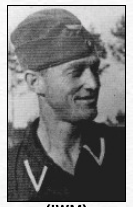
The German authorities were “apoplectic” on learning the scope of the Great Escape.. 2,279 knives, forks and spoons were used for digging. 90 complete bunk beds had disappeared, along with 635 mattresses. 52 twenty-man tables, 4,000 bed boards and an endless list of other objects. For the rest of the war, each bed was issued with only nine boards, and those were counted, regularly. The prisoners were gradually restored to normal routine, though the slightest infraction sent offenders to the cooler. Over the next twelve days, the camp was consumed with speculation on the outcome of the escape. They did not know that most of the escapees were caught within three days. Snow and cold made the going hard. Many had become lost on the way to Sagan Station. Roger “Big X” Bushell and his partner Bernard Scheidhauer, among the first few to leave the tunnel, successfully boarded a train at Sagan but were caught the next day in Saarbruken, waiting for a train to Alsace.
THE AFTERMATH
A Grossfahndung (nationwide alert) was declared.
Lindeiner‘s replacement, once the Luftwaffe resumed control of the camp, was Oberst (Colonel) Braune. On the morning of 6 April, he summoned Group Captain Massey, the senior British officer. Through an interpreter, Colonel Braune conveyed the somber news that forty-seven of those involved in the break-out had been “shot while trying to escape.” Massey was shocked. He repeatedly pressed Braune on how many of the escapees had only been wounded, Braune’s answer each time was : “None. and I am not permitted to give you any further information, except that their bodies and personal effects will be returned to you,”
A few days later, three more names were added to the roll call of the dead.
Senior officers from all Blocks in Stalag Luft Three were assembled at the camp theater and addressed by Braune’s Adjutant, Hauptman Pieber. “You must not think the Luftwaffe had anything to do with this … we do not wish to be associated … it is terrible.”
Pieber was unaware as he stood on the theater stage that beneath it prisoners had been concealing a large quantity of sand from the tunnels. The assembled officers were fully aware that a similar amount of sand lay underneath the tiered back rows on which they sat. It was an irony that amused POWs when German officers had attended theatrical performances. There was no pleasure in it now. The escape committee had accepted the possibility of one or two casualties if guards saw prisoners fleeing and shot at them. This was an acceptable risk . POWs were under orders to do nothing provocative, to surrender quietly if discovered. No one believed the German High Command would disregard the Geneva Convention regarding the punishment of escaped prisoners. A period of solitary confinement was ruled acceptable. Those like Roger Bushell with the strongest sense of moral outrage at Hitler’s crimes were prepared if necessary to make the ultimate sacrifice. Capture prevented Bushell and escape partner Scheidhauer, a Free French member of the RAF, from joining the resistance movement known as the Maquis. Bushell was committed to strike back at “the hun” till it finally killed him.
In the wider camp, many prisoners believed the reports to be false, manufactured by the Germans to deter any further escape attempts. The authorities did lend credence to that belief, such as shipping out the possessions of the fifty men, giving the impression that they were being held elsewhere. When three more names were added to the roll call of the dead, the tragic reality sank in. The aftermath was a grim time. Gestapo investigators regularly rifled through prisoners belonging. Everywhere prisoners and guards alike were on edge. Pieber even told the PoWs to “be very careful, you are in great danger; no more tricks.”
My father never spoke about how he dealt with this shocking turn of events. The sudden loss of so many friends with whom he had bonded in a common cause had an underlying effect. The trauma made my father emotionally guarded for the rest of his life.
RETRIBUTION
Three principal architects of Nazism, Hitler ( right) Himmler (center) and Goering (center left), seen here seen here in 1934 after they had seized power, and responsible subsequently for the death of millions, had a specific involvement in this particular war crime.

These men had a lot less to smile about by 1944. Standing beside Goering with Hitler and Himmler is Field Marshall Keitel, the highest ranking officer in the German Army. They were all together at the Wolf’s Lair, Hitler’s fortified HQ away from Berlin. when on the 25th April news came of the mass escape from Stalag Luft Three.
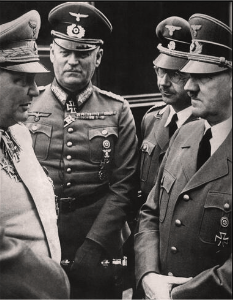
Hitler was furious and ordered every recaptured officer to be shot. Göering pointed out that a massacre might bring about reprisals against German pilots in Allied hands. Hitler agreed, but insisted “more than half” must die. Himmler and Keitel settled on 50, to be handed over to the Gestapo and shot, ostensibly while trying to escape. Keitel ordered their bodies to be cremated and their ashes sent back to Stalag Luft Three. Himmler gave the task of selecting the fifty escaped POWs to a key subordinate and dedicated Nazi- SS. Gruppenführer Arthur Nebe.

SS-Gruppenführer Arthur Nebe, a WW1 Iron Cross winner, had excellent Nazi credentials. After Gemany’s defeat, he joined Berlin’s detective bureau, the Kriminalpolizei, or Kripo. He joined the Nazi Party in 1931 and had a meteoric rise. By 1936 he had been awarded the overall command of Kripo, which became subordinate to the Gestapo. He was now mixing in the highest circles of the Third Reich.

At a meeting in Munich in November 1939, Nebe is seated second from the left, next to Himmler. Ever ambitious, Nebe volunteered in August 1941, to command Einsatzgruppe B, one of the main SS Death Squads. He ordered and sometimes supervised the public hangings of partizans, Jews, and itinerant Roma people, It estimated that Einsatzgruppe B was responsible for 40,000 executions during the war. Nebe pioneered the infamous Black Van mobile euthanasia chamber, utilizing carbon-monoxide from the vehicle’s exhaust to kill mentally ill children in Poland, part of the Reich’s program to rid Europe of ” useless eaters.”.

On the night of March 28th, Nebe received directly from Hitler the command known as the Sagan Order. He was to select 50 of the 70 recaptured prisoners to be executed. Nebe divided the records of the captured airmen into two piles. A witness, Dr. Hans Mertens provided details of Nebe’s selection process. Those to be shot were marked with a red cross and placed in one pile, those to be spared placed in the other. This took considerable time as Nebe deliberated over who should be in either pile. In a subsequent interview, Dr. Mertens described Nebe’s demeanor as he alternated between a veneer of compassion and relish at his power,
“I attributed Nebe’s excited and uncontrolled behaviour to the fact that he was aware of the monstrosity of the deed which he was about to carry out. There may have been six or eight perhaps even ten cards which I gave him. He threw several in front of me saying: ‘Have a look whether they have wives and children.’ After putting the cards which he had kept into two piles, he took my cards. I gave him briefly the personal particulars of these particular officers. I cannot remember the names of any. I remember however, that Nebe said in one case, ‘He’s for it.’ He put this card in one pile in front of him and looking at the picture of another officer said, ‘He’s so young, no.’ This card was put into another pile. On viewing another card he said, ‘Children, no’ and put it on the first stack.”
The cards of the condemned were then marked with a red X.

The execution list was relayed by confidential teleprinter to the various local Gestapo headquarters responsible for the captured POWs. After being interrogated, prisoners were told they would be returned to their prison camp. They were driven away, usually two at a time. Their Gestapo escorts would stop along a country road and invite the officers to relieve themselves. The prisoners were then shot at close range from behind. The bodies were left for retrieval, after which they were cremated and returned to Stalag Luft Three. The RAF conducted their own two year forensic investigation of all 50 murders after the war.for which this re-enactment photograph was staged.

Kirby- Green and Kidder, passing for French workers, had narrowly evaded discovery at Sagan railway station, but their luck did not hold. Nor did it for Ft.Lt. Bull, who stayed as lookout to help 40 men leave the tunnel before taking his turn. Sadly the fake Luftwaffe Sergeant uniform worn by the daring Pilot Officer Tobolsky ensured his execution.The Gestapo groups submitted almost identical reports: “the prisoners whilst relieving themselves, bolted for freedom and were shot whilst trying to escape.”
Those like Roger Bushell with the strongest sense of moral outrage were prepared if necessary to make the ultimate sacrifice. Capture prevented Bushell and escape partner Scheidhauer, a Free French member of the RAF, from joining the resistance movement known as the Maquis. Bushell was committed to strike back at “the hun” till it killed him. As the car stopped at the side of a road near what is now USAF Ramstein, Bushell surely must have anticipated his fate. In the moments before he and Scheidhauer were shot, I wonder what must have been going through his mind. Disappointment, obviously. His year long plan to disrupt the German war machine had been foiled within days. Men who followed his leadership were likely to die. Their lives must have weighed on his conscience. But given what is known about Roger Bushell, I doubt if he had real regrets. He had made his choice long ago.
Ultimately, of the 72 Gestapo men were identified as responsible, including Gestapo Chief of Moravia Hans Ziegler. He arranged the killing of Kirby-Green and Kidder. While awaiting execution, Ziegler committed suicide in the London Cage at Cockfosters in February 1948.

21 of the accused were executed, 17 were imprisoned, 11 committed suicide, seven were untraced of whom four were presumed dead, six were killed in wartime, five were arrested but for political reasons the charge was not brought to trial. Probably the Allies valued their potential contribution to post war German reconstruction more than conviction for their crimes.

Einsatzgruppe B Death Squad SS-Gruppenführer Nebe, the selector of the condemned, met an ironic fate. Believing Germany would lose the war and his crimes would catch up with him, Nebe became involved in the failed plot to kill Hitler, known as Operation Valkyrie. He fled, adopting a variety of disguises. But a tip-off from a scorned mistress ensured his arrest. In accordance with Hitler’s orders that the plotters should be “hanged like cattle,” he met his death by means of a piano-wire and meat hook, a method he had probably witnessed.
Nebe was a prime example of the ideology that the 50 murdered men had been fighting against. As the car pulled over to the side of a deserted road near what is now USAF Ramstein, Bushell surely must have anticipated, in the parlance of the times, that his number was up. He had been warned his next escape would be his last. Now men who followed his leadership were likely to die, which must have weighed on his conscience. When he and Scheidhauer were invited to relieve themselves, did he face a bullet in the back of the head with equanimity, or resignation. Doubtful, given his track record and force of personality.
I speculate that Bushell and Scheidhauer probably would have discussed two options; one to play along, then to bolt, the moment their captors let them out of the car, zigzagging to dodge bullets; or alternately to try to jump their captors , take their weapons and drive their vehicle to France.. Even in extremis, men hope for a reversal of fortune. We have learned from German records that Scheidhauer was the one who caused his and Bushell’s joint capture by reflexively responding to a question in English. Guilt at that error might have spurred him to atone, by being the one who attacks both guards, causing a distraction to help Bushell run to cover without getting shot. Bushell, for his part, was going to die as he lived, fighting.
As a screenwriter, I can’t help speculating, on the dynamics at play in this raw human moment. When death seems inevitable, how do you choose to die?. As one who has never served, I wonder how would I act in any of the situations World War Two generation faced?
We will never know the details of each POW’s execution. All the deaths were reported identically across multiple police jurisdictions with the same words: ” shot while trying to escape.” This is a facsimile of the official accounting list provided by the Senior British Officer in the North Compound.

As Flt. Lt. S. E. Douse, listed as still missing, was captured on April 6th, the document must date within 2 weeks of the escape. It was only after the urns containing the actual remains of the fifty men arrived at the camp two weeks later that all lingering doubts were dispelled.
Three escapers succeeded in reaching safety. Per Bergsland, anglicized as Rocky Rockland, as he had feared how the Nazis would treat a Norwegian who joined the RAF, along with Squadron Leader Jens Muller made it to neutral Sweden. Van Der Stock arrived in Gibraltar after an epic journey through Holland, Belgium, France and Spain. Later the Luftwaffe quietly allowed the prisoners to build a memorial in the local cemetery. It was designed by POW Wilton Todd ( shot down 15 Feb-44): Two of the stonemasons who carved the names were Dickie Head (shot down 24 Nov-43) and John Hartnell-Beavis ( shot down 25 Jul-1943 ) a former architect.

Urns containing ashes of the Fifty were originally buried there, but after the war were taken to the Old Garrison Cemetery at Poznan. Both monuments still remain today, but there were very few traces of the camp left when RAF veterans and POW survivors visited it 50 years later, though there was a local museum of camp exhibits. Paul Tobolski, son of Pilot Officer Tobolsky, who had the hutzpah to create a Luftwaffe uniform as his disguise, visited the memorial. He corrected a small error on his father’s initials, and liberated one of the tiles from Harry’s entrance. He had never known his father.


BACK IN ENGLAND
My mother knew nothing of the escape. All my father’s letters made no mention of anything other than he was doing well under prison camp circumstances.
“I wrote to Eric frequently and got worried when his letters were held up, fearing that he had escaped, and was on the run, or had been shot while attempting to escape.”
Her diary reflects a constant fear felt by the families of the 170,000 British prisoners of war. My father’s letters had naturally given no indication that he was involved in escape attempts. They would have attempted to reassure her that he was safe, and well treated, trying to minimize his wife’s anxiety for the rest of the war. But war inflicts lasting psychological damage on all it touches. My mother would suffer from bouts of anxiety and depression for the rest of her life. I wish I could have read what they wrote to each other, but sadly my parent’s wartime correspondence was lost. My mother told me that she would send news of family and friends, with reassuring messages about how she was coping, how Britain was resilient.

Recycling was embraced as much on the Home Front as it was in Stalag Luft Three. Nothing should be wasted.
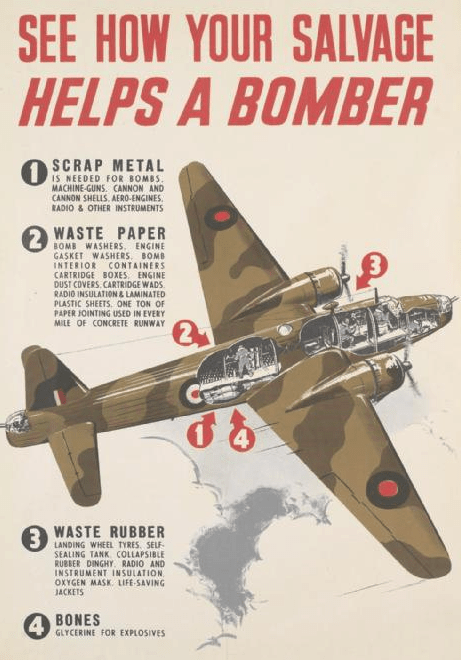
One of my mother’s letters would have told of the loss of her step brother Peter Medwin, from Fred Medwin’s first marriage. The divorce had alienated both his children, but he and his son had just become reconciled, before a senseless wartime accident. “The blackout” was introduced on 1 September 1939, two days before war was actually declared. 1,130 road deaths were recorded. as opposed to 544 in the same month the previous year. “The black out” remained in force for five years until September 1944, when regulations were relaxed to allow a ‘dim-out’.

By January 1942, one in five people had some form of injury as a direct result of the blackout. Late one night Peter Medwin got onto the wrong bus to return to the RAF base where he was stationed. Driven without lights due to blackout regulations, the bus crashed into a parked lorry. The occupants were incinerated. Fred Medwin never got over the loss of his only son. It was some comfort to him that when I was born, my parents chose Medwin as my middle name.
Writing letters to keep my father’s spirits up, my mother probably wrote little of rationing to a hungry man. She was allowed to send a 10 pound Red Cross food parcel to him every three months. Chocolate was a favorite item. Rationing kept chocolate in short supply but she generally able to include it. Among its obvious merits, chocolate was a useful in bribing guards.
My mother was lucky to be living with her parents. Her culinary training meant she she could make something tasty out of anything. Rationing was difficult for everybody in England. But they adapted.

Every citizen was issued with a booklet, to obtain supplies from a registered shopkeeper, who would stamp it accordingly.

At first, only bacon, butter, and sugar were rationed. But gradually, the list grew: the meat was rationed from 11 March 1940; cooking fats in July 1940, tea , jam and cheese were rationed by May 1941.

Allowances fluctuated throughout the war, but on average one adult’s weekly ration was 113g bacon and ham (about 4 thin slices), one shilling and ten pence worth of meat (about 227g minced beef), 57g butter, 57g cheese, 113g margarine, 113g cooking fat, 3 pints of milk, 227g sugar, 57g tea, and 1 egg.
Canned meat, fish, rice, condensed milk, breakfast cereals, biscuits and vegetables were available but in limited quantities on a points system.
Fresh vegetables and fruit were not rationed but supplies were limited. Many people responded to the government’s campaign, and grew their own vegetables.



.

Some types of imported fruit all but disappeared. Lemons and bananas became unobtainable for most of the war; oranges continued to be sold but greengrocers customarily reserved them for children and pregnant women, who could prove their status by producing their distinctively marked ration books.

Bread was not rationed until after the war ended, but the “national loaf” of wholemeal bread was replaced by the ordinary white variety, mushy, grey, and initially blamed for digestion problems. Ironically, over the years the national diet improved. Before the war Britain imported 75% of its food. By 1945, 75% of British food was home grown. My mother’s last year of school included culinary training from a Cordon Blue chef. I can attest she could make something tasty out of anything.

Inevitably there were ways of getting round regulations. Those that were caught were fined or jailed if they stole ration books.

However, there was a significant underground market in food for people with money. “Luxury” off-ration foodstuffs were being unfairly obtained by those who could afford to eat regularly in restaurants. In May 1942, an order was passed that meals served in hotels and restaurants must not cost over 5 shillings per customer, must not be of more than three courses, and at most only one course could contain meat, fish, or poultry. Today it’s hard to imagine this level of state regulation being accepted for the common good. But in wartime Britain, in my mother’s words, ” you just got on with it.”
My mother began hearing of the escape from cryptic messages in POW letters to other POW wives. The scale of the escape was “big”. References to casualties began to percolate. My mother was naturally frantic till a letter from my father confirmed he was alive.. Since his capture, her world was based upon the conviction that Eric would return home safe.
The British government had learned of 47 of the deaths after a routine visit to the camp by the Swiss authorities in May. Switzerland, as a neutral country, regularly reported on conditions in prison camps at the request of both sides in the conflict. British Military Intelligence contacted contacted sources within Germany to obtain more information.

This is how the British public first learned the news of the reprisal. when on June 23rd Foreign Secretary Anthony Eden addressed Parliament, promising that those responsible would be brought to “exemplary justice.” British intelligence sent a message through the illicit radio to senior officers at Stalag Luft Three that all escape attempts were to cease. The Germans also reinforced this with notices posted in the camp.

At a Stalag Luft Three, shock and anger within the British and American compounds settled into grief and bitter acceptance for all those that knew the murdered men. Interest in escape had been chilled. There was inevitably retrospective debate on the wisdom of the mass breakout after the previous commandant’s warning. There were those that felt that Bushell’s determination to ” make life hell for the hun” had caused the death of men who might have survived the war, but to speak of it felt like dishonoring the sacrifice. How my father felt about these issues I cannot say. I know he had a strong sense of duty to his country all his life. He was glad he “had a go”, twice, and glad he survived. Survival was now the priority as the promised invasion of Europe seemed imminent. For my father in prison camp and it meant a dogged continuation of the waiting game. For my mother my mother on the Home Front, it was a slow moving emotional rollercoaster, as she put it, “a constant seesaw of hopes raised, dashed and raised again.”
Over the next eleven months both my parents would have their spirits raised or dampened by news of the progress of the war. My mother like every one in England got daily updates from newspapers and BBC Radio. The illicit radio in Stalag Luft Three fed limited information into the camp, supported by up to date accounts from RAF and USAF Bomber Command POWs who were arriving in increasing numbers.
The next pivotal event began in the early hours of June 6th, D-Day, Operation Overlord, the first step in the planned liberation of Europe.

German reaction to the landings was slow and confused. The spell of bad weather which had made the decision to go so fraught for Allied commander Eisenhower also meant the Germans were caught off guard. Rommel was visiting his wife in Germany and many senior commanders were not at their posts. In addition, the Allied deception plan, Operation ‘Fortitude’, had convinced Hitler that Normandy would be a feint; the real invasion target was Calais. Military logic supported this view. British Intelligence reinforced it with deception strategies. Hitler was sufficiently convinced that Normandy was a feint, he delayed moving the 15th Army from Pas De Calais to Normandy till July. The only operational unit. 21st Panzer within striking distance of the beaches did not advance till mid afternoon on D-Day, allowing enough time for Allied forces to secure the Normandy beachhead.

The next day the German public would read these headlines. The invasion had been expected, and touted as opportunity for Germany to inflict a stinging defeat on the Allies. Propaganda insisted the invasion force would soon be thrown back into the sea. In fact by now most Germans realized Nazi victory against the combined might of America, Britain and Commonwealth countries, was an illusion . The German people’s focus was now on survival. Their hope was that Hitler’s much vaunted terror weapons would cause the Allies to negotiate acceptable peace terms.

Probably copies of German newspapers made their way into POW camps across Germany, The news raised morale in Stalag Luft Three. Home by Christmas seemed a possibility. It became my mother’s dream as the invasion spearhead penetrated deeper into France.

Hitler retaliated with vengeance weaponry – Vergeltungswaffen. Though Wunderwaffe, (wonder weapon) was term Nazi propaganda preferred. This was the V1, the Flying Bomb. Because aeronautical innovation is a strand of this memoir, I will briefly digress about the jet powered prototype for today’s Cruise missile. And the flying bombs of all kinds that fall on Ukraine every day.

The V1 was mass produced in underground factories with slave labor. In all some 60,000 people were deported to be the labor force. Possibly 12,000 died as a result of the brutal conditions.

Hitler intended ” pilotless planes” to renew the Blitz on London without loss of Luftwaffe aircrew. In 1943, multiple villages on the French and Dutch coasts were selected as launch sites.
.png)
RAF surveillance revealed the development of these sites in January 1944. Probably this sketch was shown to Churchill.

British Military Intelligence, MI-6 in particular, sifted through surveillance of the new Nazi weapons program. It confirmed information from their sources in Berlin: Hitler believed the Pas-de-Calais region, at 21 miles the closest landfall to the British coast, rather than Normandy, a six hour voyage, was the principal target of the Allied invasion. His V-1 rockets fired from that area would then rain down on the fleet as it approached. MI-6 offered Churchill Operation “Fortitude” to deflect attention from Normandy and reinforce Calais as the true target, Britain set up camps containing a “Ghost Army” in empty tents with dummy aircraft and tanks across the South East coastal region to be recorded by the Luftwaffe surveillance flights. An armada of decoy landing crafts, made of of painted canvases pulled over steel frames, were created around the mouth of the River Thames. Inflatable Sherman tanks were shifted to different locations under the cover of night. Rollers were used to simulate tank tracks left behind in their wake.

Another ruse in Operation Fortitude, was to employ 2nd. Lieutenant Clifton James, an Australian actor enlisted in the Army Pay Corps who was observed impersonating Field Marshall Bernard Montgomery in a Drama and Variety Group revue sketch. Far from a reprimand, James was promoted to 1st Lt. and immediately assigned to Montgomery’s staff to learn his speech and mannerisms. ( by Lt Colonel David Niven, no less, who left Hollywood to join Military Intelligence) James had lost a middle finger in the Battle of the Somme, so a prosthetic finger was installed. Details matter in spycraft. Matching Montgomery’s abstinence from tobacco and alcohol was less successful. After a crash course, on May 26th, Lt. James, playing Montgomery, was flown on Churchill’s private plane to British bases in Algiers, Cairo and Gibraltar to catch the attention of local spies. German Intelligence would surmise that no attack across the English Channel could be imminent with the prominent Allied general apparently scouting the Mediterranean. Luckily German Intelligence were unaware of a drunken wander “General Montgomery” took through the Gibraltar streets before officers spirited him out of sight. This is the actual Lt. James after recruitment into Project Fortitude.

His story would one day be filmed as ” I Was Monty’s Double”, with Clifton James playing both roles. James was a pretty good match.


In the weeks leading up D-Day, the deception continued. The Allies stepped up their aerial attacks on Pas de Calais to simulate a prelude to invasion. Then as D-Day began. Allied aircraft flying toward Pas de Calais dropped clouds of aluminum strips. These caused false radar readings in Calais indicating that a large fleet was approaching. The RAF dropped hundreds of dummy paratroopers, wired to simulate the sounds of rifle fire and grenades when they hit the ground. British commandos also parachuted in, amid the dummies, and operated “phonographs” to broadcast the sounds of soldiers’ voices. British Military Intelligence were more effective at using deception and decoys than their Nazi counterparts. Future James Bond author Ian Fleming was part of the Special Operations Executive. The spy gadgetry of Bond had its origin in his department.
I have segued from aeronautical innovation to spy craft, revealing a tangential fascination of mine. Also, when reflecting on an era, one digression tends to lead to another. But there is a connection between them. MI-6 provided deception countermeasures against both the V-1 and V-2 which took time. The V 1 was launched through a combination of its jet engine and a catapult ramp. The Imperial War Museum built this replica.



The V1, could fly up to 160 miles, falling from the sky when its fuel supply ran out, detonating 1800 pounds of TNT on impact. The amount of fuel loaded was calculated by the distance between the launch site and London or South East coastal cities. The attacks began on June 13th.

The first V-1 hit Clapham in South London on June 13th, causing casualties and dismay that the air defense system could be evaded. Mi-6 sent disinformation about V-1 falling short of London back through its double agents, causing some rockets to overshoot populated areas. At peak, more than one hundred V-1 a day were fired at Southeast England, 9,521 in total, before the launch sites were over run by Allied troops. The V-1 attacks killed 6,184 people and injured at least another 18,000. By comparison, in the eight months of the 1940 Blitz on London, 43,000 civilians were killed.

The V-1’s pulse jet engine made a buzzing sound, giving rise to the terms buzz bombs or doodlebugs. My mother recalled that ominous moment of silence.
“I can still recall the noise the doodlebugs made. If the engine cut out above you on a cloudy day, you would pray that it will not come straight down, but drift on for a few minutes; you only knew for sure when you heard the crash or explosion, and you breathed again.”
No doubt RAF POWs heard about the doodlebugs in mail from their wives. Pilots, my father among them, would have debated how to combat a low altitude pilotless plane that cruised faster than most British fighters. As Chief Flying Instructor in 1940 at Central Flying School, my father would have been familiar with the capabilities of all the latest fighters, and would have given refresher courses to many of the pilots that were now his fellow POWs. BBC broadcasts on the camp’s illicit radio would have provided more details. A major topic among Stalag Luft Three flyers that July would have been doodlebugs: how to destroy them in the air, minimizing damage, and do so from a sufficient distance, to avoid being damaged by the blast of the explosion.
The RAF were quick to respond and adapt. Spitfires and Hurricanes were too slow to catch a V-1, which could average 340 mph, unless they had a height advantage, allowing them to gain speed by diving on their target. The only aircraft with the low-altitude speed to be effective against the V-1 was the Hawker Tempest.

These 1944 pictures show the size of the engine and the 12 foot 9 inch diameter propeller that enabled the Tempest to reach a top speed of 442 miles per hour. A post-D-Day New Zealand Squadron celebrates their Tempest.

Closely guided by coastal radar installations, the Tempests located incoming targets and destroy them with 20mm cannon fire. Although only 30 Tempests were available at the onset of the attacks, the Hawker Tempest squadrons accounted for 638 of 1,846 RAF kills of the flying bombs.
Spitfire pilots with aerobatic ability tried Wing Tipping. Here is an enlargement from an actual photograph of a Spitfire in the attempt.

This involved harnessing the airflow that runs over a plane’s wing. The intercepting pilot would dive down, reaching the same speed as the buzz bomb, then manoeuver to fly directly alongside. The pilot slowly slid his wing tip a few feet under the V-! wing. He then carefully adjusted height to bring the airflow running over his wing to within 6 inches of the lower surface of the V-1’s wing. Correctly executed, this manoeuvre tipped the V-1’s wing upwards, over-riding its internal gyroscope, pitching the V-1 into an out-of-control dive. At least sixteen V-1s were destroyed this way, the first by a P-51 piloted by USAF Major R. E. Turner of 365th Fighter Squadron on 18 June.
The V-1 attacks had no effect on the advance across Normandy. Montgomery was able to break out from Caen and the race to Paris was on.

My mother would have read this announcement. POWs in Stalag Luft Three would have heard about it it within days. Anti Nazi guards often provided information.


Responding on September 8th 1944, Germany launched its new flying bomb – the V-2. The first hit the newly liberated city of Paris, the second fell on London.

When launched from a mobile pad, the V-2’s enhanced jet engine burned for up to 70 seconds, propelling the rocket to a maximum height of 50 miles. It was aimed at the dead center of London.

Four seconds after launch the V-2 tilted to an angle of 47 degrees. When the engine cut off, the rocket glided the rest of the way across the North Sea in a parabolic curve On its downward trajectory the V-2 reached supersonic speed. For its victims, there was no warning.

This V-2 struck Teniers Square in Antwerp, as a British convoy passed through, killing 126 people.

Hitler was convinced that ” wonder weapons”, including the atomic bomb his scientists had promised, would bring a swift end to the war. Luckily his scientists took the wrong research path of “heavy water”, and reached a dead end. The attacks from V-2s resulted in the deaths of an estimated 9,000 civilians and military personnel. More than 3000 V-2 rockets were fired , the last on on March 27 1945. An estimated 2,754 civilians were killed in London by V-2 attacks with another 6,523 injured, which is two people killed per V-2 rocket.
The Government, worried about potential panic gave the reasons for the damage as gas explosions. This prompted cynical Londoners to respond “Have you heard about Hitler’s latest secret weapon – the flying gas main ?”
But there was no effective air or ground defense against such an unpredictable weapon. British Intelligence learned that the V-2 had one fatal flaw. The Germans had decided not to use radio guidance to direct it to its targets, for fear the signal might be jammed. Instead, the missile was purely ballistic.
The RAF exploited this weakness, using their latest secret radar vans capable of glimpsing the trajectory of the V-2s a few seconds before they passed out of range. Working with nothing more sophisticated than their slide rules, Allied teams determined the point of the missiles impact on London. From that they would calculate the origin of the curve. If they could accomplish this within six minutes, Fighter Command would have time to relay the map co-ordinates to Spitfire pilots operating from RAF Coltishall in Norfolk, who could be over the Dutch coast within half an hour, just enough time to bomb the launch sites before the Germans withdrew.
British double agents like Eddie Chapman or ZigZag fed misinformation to the Germans suggesting that the V2s were overshooting London, causing some rockets to be mistakenly directed east of the London into the fields of Kent and Essex. The entire tonnage of high explosive delivered by the V2 over seven months, 3,000 tons, could be dropped in a single raid by British heavy bombers. The V2 was expensive, resource intensive and had little strategic value. Few weapons better exemplify Hitler’s fixation with the wonder weapon, a magic bullet for a war he had already lost.
My mother had no personal experience of the V-2, because most rockets overshot the part of South England where she was living. The progress Allied forces were making helped a sense of optimism. To end the war by Christmas was within reach if a bold move proposed by Montgomery was successful: a straight push over the lower Rhine rivers. US Airborne troops were dropped to secure the three bridges ahead of the British line of advance. Operation Market Garden was a hastily developed plan. Its objective was to create a 64 mile salient into German territory. Success depended on Murphy’s Law being absent without leave. .

Murphy’s law. Optimistic planning, weather, missed opportunities. Intelligence failure .Spy.
41,000 dropped in by parachute or glider to capture nine bridges ahead of the Army advance .100,000 seasoned German troops were in the area.

It was the largest airborne operation of the war up to that point.


Armored brigades captured two Dutch cities and overran a few V-2 launching sites. It failed in its most important objective: securing the bridge over the Rhine at Arnhem. after suffering 8,000 dead, missing, and captured out of a complement of 12,000 men.

Prisoners Arnhem would soon start arriving at Stalag Luft Three.

It was a setback for all those hoping the war would end by Christmas. In December Hitler launched his his last desperate counter attack known as Battle of the Bulge. The influx of American POWs across multiple camps including Stalag Luft Three must have been dismaying to all those who months before felt so close to freedom.

By December 30th POWs would learn from BBC radio broadcasts that the attack had stalled. However, its failure precipitated an event that ensured their final months of captivity would be their hardest.


1945
Tunneling had begun again in November began when prisoners heard rumors that Hitler was planning to have all prisoners of war executed if the war continued to go badly.
Evidence was given by an SS general at the Nuremberg war crimes trial that Hitler had considered threatening to execute 35,000 POW‘s, unless the allies agreed to a peace deal. SS chief Heinrich Himler made parallel hostage taking plans, centered on collecting prisoners on the Baltic coast region where he had set up a new headquarters. The Allied bombing of cities, particularly Dresden, had caused deep resentment towards RAF and USAF captured airmen. Many POWs wondered if they might be killed in revenge . As a result, a new tunnel at Stalag Luft Three was dug named George, after the Britain’s current King George, starting at the rear end of the camp theatre. It ran towards the section of the camp where the guards were housed, rather than towards the wooded area outside the wire. Some have speculated that perhaps the prisoners were planning to break into the guard barracks to steal weapons either to fight their way out or defend themselves from a massacre should Hitler order it . Stalag Luft Three was excavated in 2011, confirming the existence of the ultra secret tunnel named George. Among materials recovered was a clandestine radio crafted out of a biscuit box and other materials scavenged from the camp. It probably bore my father’s fingerprints.

THE LONG MARCH
At the end of January 1945, Russian forces had now advanced to within 15 miles of Stalag Luft Three. Liberation seemed only days away. But on January 27th, the camp commandant received orders from Berlin. Hitler had ordered the immediate evacuation of the camp. All six compounds were instructed to march that very night. You can imagine the mixed emotions of the POWs, as they hurriedly collected extra clothes, food rations, potential escape aids like a map and compass. My father was obliged to leave behind the secret radio he had been in charge of hiding. The US personnel in the south compound were the first to leave at 9:20 pm followed by RAF contingents at 1 am. Each man was given a Red Cross food parcel. In all, 10,000 prisoners marched through the gates of Stalag Luft Three throughout the night and the following morning. into subzero temperatures, a thick covering of snow, and occasional blizzards. It was one of the coldest winters in memory. The column of POWs stretched for 3 miles.

Not only were 10,000 men force-marched to new prison camps in distant areas, but a flood of German refugees fleeing the Russian advance were clogging the snow swept roads. My father was always brief when asked about his experiences in the last months of the war, which was, in essence, ” Cold, hungry, and scared a lot of the time”, with little accompanying detail. He never mentioned the Long March, as such; just another prison camp posting that eventually took him to Stalag 3 A at Luckenwalde. I get a sense of what he experienced from on-line posts of other RAF veterans of the Long March.
Flt. Lt. Geoffrey Keen wrote in his diary after they had marched for 21 miles :
“In bitter weather and blowing blizzard 700 of us were pushed in a barn, bare of straw, some of the men in very bad condition. Bitterly cold.
29.1.45 Set off again at 8.30am still blowing a blizzard, bitterly cold, passed through Preibus at 11.45am. Many falling back, some very exhausted, arrived at Muskau at 7.00pm, had continued a blizzard all day. Most of the men exhausted. Spent three days in a brick factory and part of the last day at Count Von Arnim’s riding stable. Covered another 24 kilometers.
1-2-45 Left Muskau at 10pm. Thaw had set in and roads in bad state. Had to leave sledge and carry pack on back. Marched 19 kilometers, worst march of the journey, feeling very exhausted. Feet in quite good condition, large number of sick men.
Several veterans made sketches.


At Spremberg railway station, the POWs were loaded into 50 cattle trucks, 40 men per wagon, with only one bucket between them for sanitary purposes. The journey took over 40 hours. Flt. Lt. Keen concludes:
“Hell of a journey. Marched 3 kilometers to the new camp in pouring rain. Stood outside gate for four hour and then searched. Thirteen of us placed in an empty room with wet straw to sleep on. Feeling pretty done in but glad to fall down and sleep anywhere. Had marched 90 kilometers and done 300 in the cattle truck. Majority sick, some in very bad state.”
According to Robert Schirmer, a Red Cross delegate in Germany, 80% of the POWs on the northern line of march were suffering from dysentery by the time they reached their designated Stalag.. Sufferers had the indignity of soiling themselves whilst having to continue to march. At minus 13 degrees fahrenheit, it was march or die. Typhus, acquired from body lice, was a risk for all POWs. Like dysentery, it spread through overnight shelter previously occupied by infected groups. In these conditions the night held little comfort for those who had marched in wet boots.for 12 hours. Whether to remove them at night was an issue. Trench foot could result from prolonged exposure to moisture, an affliction of infantry soldiers in WW1. If a POW removed his boots, he might not get his swollen feet back into his boots in the morning. He could get frostbite overnight. The boots could freeze or be stolen. A few sick men froze to death in their sleep. Others vanished without trace. A few were shot trying to escape. Some succeeded in reaching advancing Allied lines.
As a senior officer within his section af the march, my father’s duties would have focused no longer on escape, but on the welfare of his group. The key to psychologically manage prison camp life was to remain an actively engaged serving officer. On the March, I imagine he would have been involved in the daily management of shelter and food, and negotiations with German authorities along the way. The fog of war took its toll. One marching column of POWs was mistaken for German troops by RAF Typhoons, despite clear skies and Red Cross insignia being displayed. They opened fire, causing multiple casualties. The German guards agreed to POW requests that further marching would be done by night. An estimated 2200 British and Commonwealth POWs died on the march. The residents of some villages, bitter at continuous Allied bombing, threw stones at the passing column. Others offered water and hot drinks. One woman, bearing coffee, explained her empathy. Her husband was a POW in England. The Sagan March was a miserable, psychologically traumatizing experience for the POWs. But there was something about this generation of young men that kept them putting one foot in front of the other.
For two months. POWs endured the uncertainty about whether any German General would carry out Hitler’s orders to shoot 30.000 POWs. or they would become human shields for Himmler, who hoped to inherit leadership of the Reich from Hitler, now isolated in his Berlin bunker. My father along with other RAF POWs ended their march at Stalag 3 A Luckenwalde. Without access toBBC broadcasts, the POWs would have had no reliable news of Allied progress.


Over the next months Russian forces pushed ever closer. The Luckenwalde POW newspaper printed this front page on the day of the camp’s liberation.

“Russkie come… ” had been used up till then as a taunt to the guards By that morning the guards had already fled, and the POWs, my father among them. welcomed the Russian liberators. Less happy were three Russian generals captured in 1942 during Germany’s Operation Barbarossa. Rather than receiving a heroes welcome on their return to Mother Russia, they were shot on Stalin’s orders for failing their missions..
A convoy of 50 trucks soon arrived loaded with food, clothes and medical supplies for the prisoners. This was accompanied by a flood of displaced persons men and women, fleeing from the conflict zone. The Russians quartered them in them in the camp. Dysentary was rife. Tented latrines were dug around the camp, providing benches with a dozen holes located above a reeking pit. . A rare recollection from my father was of a moment when he was sitting alone in one outdoor latrine, A large middle aged woman entered, pulling up her skirt, and sat on the hole beside him. She chattered away as if this was a normal encounter in a language that sounded like Polish. He remembered with amusement his own discomfiture, experiencing gender free sanitation for the first time. It was an indication of how much the world was about to change.
The liberation process was a little slower than at other camps owing to the diplomatic protocols involved with my father’s camp now being in Russian territory. Some prisoners became impatient, and tried hitchhiking on their own, or joining the Russian advance towards Berlin. Two RAF crew who chose this path were never seen again.

My mother received a telegram saying my father was in Stalag 3 A Luckenwalde, awaiting release by the Russians, and would soon be flown back to England. A week later her stepfather received a message that Wing Commander E. T. Smith would do all he could to arrive that night. Finally after four years, this was the day she had prayed for. Her boss told her to go home and take care of her husband. He would find a new canteen manager. But not one who knew as much about tasty food as she did. My mother tidied the little flat where she lived over her parents’ garage, and got in all the decent food that rationing would allow. Like the wives of all returning POWs, she listened for the sound of each approaching car.
“At about midnight a car stopped outside. My heart stopped too. I peeped out from behind the blackout curtains. It was a local taxi. I rushed to the door, putting the light out on the way, even at that moment, being cautious of blackout restrictions, it was Eric. We hugged and kissed and wept together in the dark.”
They woke up the family. Fred Medwin opened the bottle of champagne he had been saving till Eric’s return.. The war had cost his only son. His stepdaughter’s husband would be a comfort to him for the remainder of his life.
“After a lot of excited conversation the family went back to bed and Eric and I back to the little flat across the garden. I asked him if there was anything he wanted to eat? I was able to give him two poached eggs on toast. They were the first he had since the day he was shot down over France.”
Winston Churchill declared Victory in Europe Day on May 8th 1945.


Before continuing my father’s journey, it is worth viewing World War Two from a global perspective. Wikipedia provides a succinct summary of the deadliest conflict in human history.. An estimated total of 70–85 million people perished, or about 3% of the estimated global population of 2.3 billion in 1940.[1] Deaths directly caused by the war (including military and civilian fatalities) are estimated at 50–56 million, with an additional estimated 19–28 million deaths from war-related disease and famine. Civilian deaths totaled 50–55 million. Military deaths from all causes totaled 21–25 million, including deaths in captivity of about 5 million prisoners of war. More than half of the total number of casualties are accounted for by the dead of the Republic of China and of the Soviet Union. More than half – a staggering fact not widely known. The following tables give a detailed country-by-country count of human losses.

Such casualties are only sustainable if the will to fight can be maintained. The propaganda war has always interested me. It provides cultural texture to a study of events. So before resuming my father’s journey, here is a little digression into propaganda art, focussing mainly on the influence of Josef Goebbels, Reich Minister of Propaganda. Nothing was published without his approval. This is not some fetish for tangential Nazi memorabilia. I’m interested in deconstructing the hidden persuaders buried in Art. Goebbels was a master of image making, and his techniques influenced Madison Avenue thereafter.

Probably from the 1936 Referendum. The caption: “Check the war-mongers of the world. Every vote for the Führer!” Courtesy of Dr. Robert D. Brooks.

The overweening grandiosity of Nazi art speaks volumes.

Underpinning the war on land, sea, and air was the battle for hearts and minds. Each side created propaganda campaigns to define the enemy, and promote behavior on the home front beneficial to their war objectives. Here’s how Hitler defined Germany’s enemy before the war.
 .
.
The translated caption reads: “Bolshevism without a mask”. It was displayed in late 1937 as part of a large anti-Bolshevik exhibition at the Reichstag in Berlin . The victims wear simple white tunics, representing their ‘innocence’. The perpetrator’s face is purposefully designed to resemble an ape, teeth bared in a grin at the slaughter before him, a barbarian relishing the destruction of civilization.. The color scheme broadens the message. The yellow satchel and Red Star allude to the Soviet Union’s flag, thus targeting not only Bolsheviks but the whole country of Russia. Propaganda is most effective in a society where fear and uncertainty have germinated.
But Nazi propaganda against the Soviet Union was interrupted for a period of a few years, beginning in August 1939, due to the signing of the Molotov–Ribbentrop Pact (Treaty of Non-Aggression) between Germany and the Soviet Union. To prevent a two front war, Hitler signed the treaty a few days before the invasion of Poland in the beginning of September 1939. In an Orwellian switch, Britain then became the new German enemy.

When France fell in 1940, following Britain’s humiliating evacuation from Dunkirk, the powerful Nazi fist is seen squashing Jewish bankers and a corpulent Churchill.

This poster, using the classic racist depiction of a Jew wearing a British flag, was intended for Flemish speaking Belgians, urging them to join the SS Langemarck Division. This prompts the question: Were Flemish Belgians more anti semitic than other Belgians? The caption in red says: “Our answer: Pick up your arms and fight!”

When Nazi forces attacked Russia, they capitalized on anti Russian resentment in Ukraine, which Stalin had brutalized and starved in the previous decade. With advertising in the Ukranian language, they attempted to recruit Ukrainian brigades to fight their former oppressor.

Using the dragon as a traditional symbol of evil, Waffen SS Brigades stationed in Brussels offered similar inducement to enlist. This poster was distributed in occupied Europe and satellite countries from 1942 onwards. It was part of the Nazi attempt to persuade occupied Europe that it was part of a common European crusade against Bolshevism.

As war intensified in North Africa, the Atlantic, and in the skies over Britain throughout 1940, the security of sensitive information became one of the government’s many public education campaigns. This one targeted the danger to naval convoys and RAF missions in public places where enemy agents or sympathizers could be listening.

British propaganda art used simple cause and effect messages, citing Pub talk and gossiping women as the chief offenders.

Social attitudes embedded in propaganda are interesting to deconstruct. This is directed at the the average British soldier.

German propaganda, under Goebbels, used more sophisticated graphic arts techniques to reflect the clandestine enemy.

There is creative use of light and shadow; the curvature of the listening waiter’s body, the proffered cup and saucer metaphorically acting as a microphone. Less subtlety was required by 1943 in this poster advocating silence.

The caption: “Shame on you, chatterer! The enemy is listening. Silence is your duty.” Why do I imagine a yappy Daffy Duck in Leibenhosen. For information, on the war, Germans were encouraged to listen to the radio.

Foreign radio was banned. By 1944, people were executed for listing to enemy radio stations. In this poster, a sinister Bolshevic broadcasts from London, Moscow, and other enemy states, while a German listens in the darkness, trying to conceal his crime.

This German Blackout poster connects exposed interior lights with Death from Above.

The text translates as: “The enemy sees your light! Black out!”


The British bombing campaign was reflected differently by Germany. Children were encouraged by the holiday image to be evacuated from major cities to avoid experiencing the “terror from the skies” that London experienced in 1940..


As war disrupted German food supplies, an Anti-hoarding campaign was started.
 “Hoarder, be ashamed of yourself.” The German term for a hoarder is Hamster.
“Hoarder, be ashamed of yourself.” The German term for a hoarder is Hamster.
By 1945, German propaganda had lost any sense of irony. This defiant statement was effective in recruiting the Hitler Youth in the defense of the last remaining cities.

POST WAR
My parents had been been separated for twice as long as they had been together. The process of his rehabilitation began. If my father was a quiet man before the war, he was a quieter man on his return to an England wracked by bereavement. 450,700 total civilian and military deaths. Like many POWs he experienced survivor guilt. He could sense the unspoken stigma applied to those ” who were lucky enough to sit out the war in a cheap German hotel…” as the saying went. When my mother took him shopping for the first time, and she waved at a friend across the street, he would hide in the nearest shop rather than be introduced. As he was owed weeks of leave, my mother took him to the Isle of Wight, where they joined a club as visitors.
“I think it did Eric good. He was meeting people who had not previously known him and therefore was unlikely to ask questions. All he wanted to do at that time was blot out the past after losing those precious years together. Within two months I knew I was going to have a baby. “
By then, my father had begun his flying refresher course at that time. They had moved in to furnished rooms in a house in the country, Accommodation was at a premium due to the volume of returning service personnel. They shared the kitchen and bathroom with the owner, plus another Air Force family, and several cats and dogs.
” The kitchen was pandemonium. Three wives all cooking at the same time. Kids screaming, animals under your feet, was not conducive to a happy pregnancy, but one we were stuck with as rented houses were hard to find.”
The England my father came home to had a different flavor to the one he left in June 1941. The July 1945 general election defeat of Churchill’s conservative party must have come as a complete shock to my father. He had been in charge of protecting the Stalag Luft 3 illicit radio, from which broadcasts Churchill’s BBC Radio speeches, relayed to POWs providing their sole window on the war. POWs loved Churchill. He was their champion, their beacon of hope for liberation.So they must have wondered why the British voter had been so ungrateful to the man who pulled the nation together in its darkest hour.
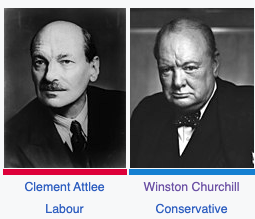
The Conservatives ran a complacent campaign, riding on Churchill’s Victory in Europe. Leave it to us, they said. Stay the course. They ignored the clear demand for change as laid out in their own 1943 Beveridge Report, which called for nationalized healthcare, expansion of state funded education, and a new housing policy. The report was published, and became a best-seller. Yet Churchill feared the consequences of rapid social change. He saw Socialism as the first step towards Communism. A 1943 poster, created by the Army Bureau of Current Affairs to boost morale, suggested that a British victory would lead to positive benefits like slum clearance. 
Churchill considered the poster “a disgraceful libel on the conditions prevailing in Great Britain before the war” and ordered it suppressed. But the British working class were only too aware of their poor conditions then, now exacerbated by five years of war. The Conservatives held power for all of the interwar period, and inheriting blame for the era’s mistakes: appeasement, inflation, the Great Depression. In one opinion poll, 41% of respondents considered housing to be the most important issue that faced the country. Consequently Labor won a landslide victory, and Britain’s future welfare state was born. It faced a war ravaged economy.
Notes for my father‘s war on Churchill. Churchill has Churchill was called a Warhawk a Warmonger when he warned of the threat of Hitler and the threat of Stalin. Both times he was criticized for being a alarmist and prejudiced, but he was right on both counts. Churchill was wrong about colonialism and the need to preserve the British empire But he acceded to the force of destiny. I guess with as much good grace as he could in the last in the five years when he became Prime Minister again between 1950 and 1955. There are many things you can criticize Churchill for. He authorized the use of mustard gas on insurgents in Iraq in 1925. it was would be considered a war crime but not in the 19th century mindset of political leaders in the early early 20th century, typically after the creation of the mustard gas in World War I, but so there is there are many things you could criticize Churchill for, but in fact he was deep down in a liberal progressive with an empire conservative crust, but he his heart in many respects was in the right place. He wanted to elevate the poorest amongst amongst the British people , so this should be considered before people tear down statues of Churchill. His virtues the good he did for the world should be measured against the evil that he could be accused of. It’s the cancel culture has to be put into perspective. Perhaps statures of Cs, maybe the statues it should be put in the museum and what they perpetrated and in service of provide a lesson for people is to know things in the past that should not be repeated.
As part of the demobilisation of the Royal Air Force, the new Under Secretary of State for Air, John Strachey, announced that 742,000 of the RAF’s personnel strength of 1,100,000 would be released from service on 30 June 1946. My father was not among the retrenched. I was born on June 1st 1946 at a nursing home in Maidenhead , Berkshire and was soon installed in married quarters at my father’s next posting. Retraining on the Spitfire and Hurricane that he knew rekindled his love of flying. He moved on to learning the characteristics of the new jet aircraft.
JET FLIGHT
Air Commodore Frank Whittle, an English engineer, inventor and RAF Officer is credited with having invented the turbojet engine, seen here adjusting his slide rule in 1943.

His story reflects a characteristic common to the greatest generation – determination.
Like my father, Frank Whittle yearned to fly. He applied to the RAF at age 16 to be a pilot. A mathematical genius, standing only five feet tall and light in build, he was rejected on physical grounds twice before six months of special diet and exercise added three inches to his height and chest, yet he was rejected again. Reapplying under an assumed name and was accepted to be trained as an aircraft mechanic. His intuitive grasp of aeronautics impressed his commanding officer, who had Whittle re assigned to pilot training at RAF Cranwell, where he was described as an “exceptional to above average” pilot. However, his flight logbook also showed numerous red ink warnings about showboating and overconfidence. Graduating at the age of 21.Pilot Officer Whittle won the Andy Fellowes Memorial Prize for Aeronautical Sciences for his thesis – “Future Developments in Aircraft Design”. It contained his early concept of an afterburner to enhance speed. He continued to research and promote his ideas on jet propulsion when he was posted to the Marine Aircraft Experimental Establishment as an armament officer and test pilot of seaplanes. Perhaps when my father first flew a Walrus seaplane. he took instruction from Whittle. Both men were at that time flight instructors at RAF Cranwell, and collected planes for their logbooks. Whittle logged some 20 different types of floatplanes, flying boats, and amphibians, and was described as an “exceptional to above average” pilot. However, his flight logbook also showed numerous red ink warnings about showboating and overconfidence. He was he was disqualified from the end-of-term flying contest. But his ideas attracted Air Ministry attention.
Whittle expressed his concept with superb conciseness. Here an extract from his pitch. “Reciprocating engines are exhausted. They have hundreds of parts jerking to and fro, and they cannot be made more powerful without becoming too complicated. The engine of the future must produce 2,000 hp with one moving part: a spinning turbine and compressor.” By 1937 he created a successful prototype jet engine which he developed with with tireless energy, battling funding and bureaucratic delays. He was hospitalized for nervous exhaustion twice in the process. But eventually British Jet Fighters entered combat in 1944. Over his lifetime he received multiple honors and awards. Knight Commander of the Order of the British Empire, Companion of the Order of the Bath, Commander of the Legion of Merit (United States) to name but three. In the BBC poll of the 100 Greatest Britons, Frank Whittle was ranked number 42.


The engine that powered propellers to drag the plane through the air was replaced by a jet fueled engine that that thrust the plane forward at greater speed.. During the war, both sides had raced to make a prototype operational. The Nazis had a jet powered fighter bomber in the air by mid 1944, the ME 262 Sturmvogel (Storm Bird}  .
.
Designed as a ground attack/ fighter-bomber, it could fly almost a hundred miles an hour faster that the Spitfire. More heavily armed than any Allied aircraft, the ME 262’s four 30 mm cannon in the nose could fire 650 rounds a minute. Due to supply chain shortages, Allied bombing of factories and airfields, the Luftwaffe never had more than 200 jets operational at any one time. But they were effective attacking mass formations of bombers from the rear. From the first official kill of an RAF reconnaissance Mosquito over Munich in November 1944, it is thought that as many as 420 Allied aircraft, could have been shot down by the world’s first jet fighter unit.

This was the first Me 262 to come into Allied hands when its German test pilot defected on 31 March 1945. The aircraft was then shipped to the United States for testing. The first jet put into service by the USAF was the Lockheed P.80 Shooting Star initially for reconnaissance.


Delivery delays prevented the Shooting Star being tested before combat ended. In the Korean war it was outmatched by the MIG 15, and flew mainly ground attack missions.

The subsequent F-86 was the first American aircraft to take advantage of flight research data seized from the German aerodynamicists at the end of the war. It showed that a thin, swept wing could greatly reduce drag. But the Saber would generally be outfought by the Russian MIG 15 in the Korean War.This Saber on display at a British Air Show in 2008 was still operational..

The RAF started development on its jet fighter in 1941..

On March 3, 1943. the Gloster Meteor was wheeled out for its test flight. Modifications continued will July 1944 when the RAF accepted the first operational Meteors into service, now packing six 20mm cannon in the nose. The technology was so guarded that the aircraft were forbidden to fly over enemy lines for risk of the technology falling into Nazi hands. In fact, the Meteor’s very first kill was against the V1 flying bomb on its way to London. When the Meteor’s guns jammed, the pilot executed the same wing-tipping maneuver on doodlebugs, pictured earlier, by a Spitfire.

The Gloster Meteor achieved the world air speed record in 1946, flying at just over 606 miles an hour. Aircraft technology was closing in on Mach 1; the speed of sound – 1,116.5 feet per second.

The Meteor was also adapted for deck landings.

On the downside, a total of 890 Gloster Meteors were lost in RAF service (145 of these crashes occurring in 1953 alone), resulting in the deaths of some 450 pilots.
The next technological advance was the Vampire, where the weight and drag of two wing mounted engines were replaces by a single jet engine in the tail. This is a preserved de Havilland DH.115 Vampire trainer, bearing Royal New Zealand Air Force Force markings.

Initially named the ‘Spider Crab’, the Vampire’s design was considered experimental in its unorthodox arrangement of twin rear booms mounted behind a moulded, egg-shaped wood / aluminum fuselage. But its one single engine had the power to exceed 500 mph and its distinctive shape made it instantly recognizable in the air and from the ground.
A number of DH100 Vampires were also modified for shipboard use. Here Captain Eric ‘Winkle’ Brown is completing the first successful landing and take-off of a jet fighter from the Carrier HMS Ocean.

The cockpit of the Vampire. A complex set of variables to keep an eye on.

3268 Vampires were manufactured, proving to be a strong export to other Air Forces. But Vampires suffered 411 fatalities. It was an inevitable byproduct of the rapid introduction of technological change. My father continued to try out every new plane that came his way.
As the once senior flight instructor at RAF Cranwell, Wing Commander E T Smith was at a career crossroad. A resumption of flight instruction could have been an option. But my father said that jet powered flight required much more dependance on instrumentation than the planes he had flown for the ten years that preceded his capture. The technology required in high speed flight had diminished for him that sense of a direct tactile relationship with the ground. He enjoyed the speed and maneuverability of the Vampire, but instrument flying was simply less fun. But my father was not reassigned to his pre-war speciality. The RAF had other plans for him.
POST WAR SITUATION
The newly elected labor government of Clement Attley had a myriad of problems to face. Before the war, Britain maintained colonies all over the world, providing valuable raw materials, manpower and strategic bases. By 1945, however, colonies were an expensive liability. There was a sense of inevitability of decolonisation at the end of the war; Britain was exhausted by it and the empire had lost much of its remaining legitimacy in South and South East Asia. The support for nationalism had increased dramatically across the region throughout this period.The United States’ rising global influence and its opposition to imperialism made colonialism less politically viable, while Japan’s wartime victories had destroyed Britain’s imperial prestige. The RAF would continue to be used to enforce boundaries and discourage insurgency .The disintegration of Britain’s empire would transform global politics over the next half century..
After the defeat of Japan, Britain had to re-establish contol over its recaptured colonies and those of other European countries, like Holland. Britain had 4000 mainly Indian Army troops in Dutch Indonesia, protecting civilians till Dutch troops could be trained and equipped to replace them. They faced 20,000 Indonesian Republican Army troops, equipped by the Japanese, and a civilian population no longer loyal to the Dutch Empire, who believed incorrectly the British troops had arrived not as caretakers, but to restore Dutch rule. It did not take long before the gloves were off in the fight for self determination.

This is the burnt out car of Brigadier Mallaby on the spot where he was killed on 30 October 1946. Hundreds of Indian Army troops died in the ensuing attacks, before order was restored..
The political challenges facing Britain’s armed forces in every corner of the empire, often impacting the RAF. On February 22, the Jewish insurgency group the Irgun destroyed 14 planes at 5 RAF stations in Palestine as part of its campaign to end the British mandate. 7 Spitfires, 2 Avro Ansons, 6 Handley Page Halifax VIIs, went up in smoke. 5 Halifax IXs were subsequently written off as” beyond economic repair.” Britain was reaping the harvest of promising Palestine to both the Jews and the Arabs during World War 1. The RAF suffered no casualties on this occasion. But on July 22nd, The Irgun bombed the King David Hotel. the headquarters of British forces in Palestine. 91 occupants were killed, 45 injured; 28 of the casualties were British.

Here British paratroopers enforce curfew in Tel Aviv.
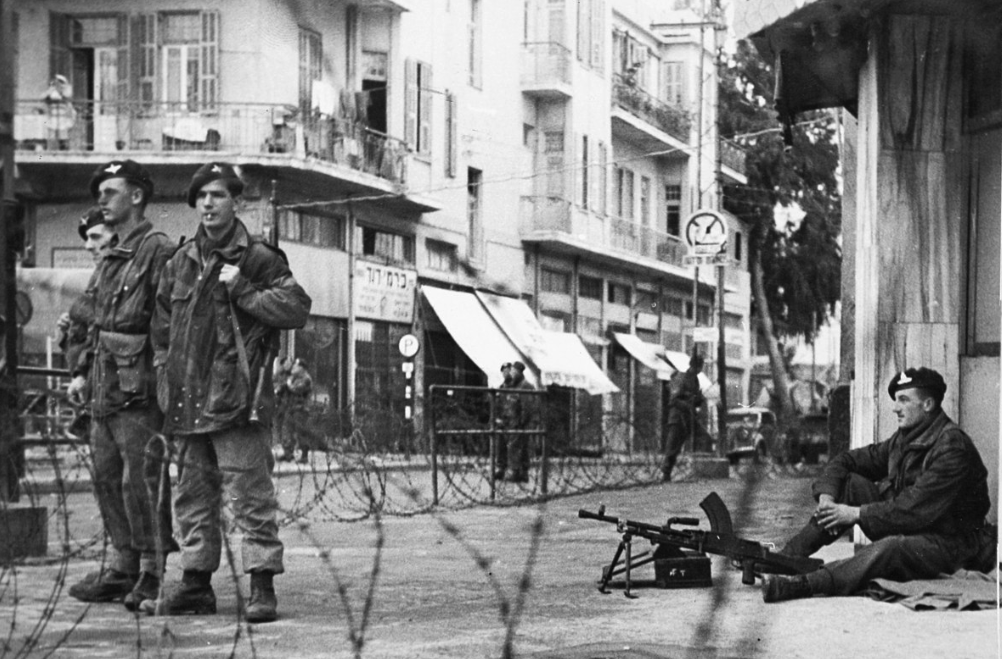
Even after Britain’s mandate ended and the UN established the State of Israel, Britain’s problems in the region multiplied, when Arab nations including Egypt declared war on Israel. Britain, as guarantor of Egypt’s security, was caught in a bind, struggling to maintain neutrality in the conflict. I highlight the following incident because it reflects the challenges that RAF pilots faced under peace time rules of engagement in a contested region, when Egypt complained to the UN that Jewish aircraft were conducting “incursions” into its territory in violation of UN rules.
The consequent RAF reconnaissance at UN request resulted in the loss of aircraft, which was debated in the House of Lords. shows in this extract from the House of Lords:
“R.A.F. aircraft from the Canal zone, on reconnaissances inside the Egyptian Frontier were attacked by Jewish fighters and the four Spitfires failed to return from the mission. A few hours later, a further air reconnaissance force, despatched to obtain information as to the fate of the missing Spitfires, was also attacked by Jewish aircraft and one Tempest has been reported missing.
The pilot who was the leader of the Spitfires reported he was attacked 15 miles inside Egyptian territory and compelled to bale out. He was wounded and was picked up by a Bedouin near Bir Gabr Amir approximately 15 miles West of Rafah.
The Battle of Britain had educated politicians about the realities of aerial combat, as seen here in this speech:
My Lords, let me, in support of this, give another argument which will I think be endorsed by experienced air officers. As I understand from statements that I have read, the pilots were instructed that they were not to fire unless they were attacked. I submit that that is really an impossible order to give to a pilot, unless he is supported by a very strong deterrent force. It is not like a battle at sea where, though the first salvo may be pretty serious, it is not necessarily fatal. Still less is it like an engagement on land, where one gun starts firing. With fast modern aircraft, air combat is a matter of seconds. The first burst of fire, accurately directed, is decisive, and there is no justification for subjecting our airmen to such a risk unless the circumstances are absolutely unavoidable. The Government ought surely to have directed that this operation should be conducted by a force of aircraft so strong as to deter any aggressive attack—or at any rate to ensure that if such an attack did take place it would be overwhelmingly defeated. Our aircraft have now been instructed to regard as hostile any Jewish aircraft encountered over Egyptian territory.”
The fighter pilots that shot down those RAF planes were probably Polish Jewish pilots trained by the RAF, while Arab air forces recruited former Luftwaffe pilots as mercenaries. The ironies of war and peace.
Clearly decolonization in India, Africa, and Palestine was a messy process. Further complicated by the Cold War was setting in. Smooth liaison between the military and the the foreign office was essential.
My father had been disappointed the previous year when his old 1941 squadron, of which he was the senior survivor, was chosen to participate in celebratory flyovers in America, and yet he was denied the opportunity to lead it. A victory parade led by a former prisoner of war did not fit the desired PR image. But his next command appointment indicated the RAF still had confidence in him. It is probable that his activities on escape committees at each of his POW camps was a factor in the RAF’s choice.
The RAF looked for base commanders with colonial posting experience where liaison with the Foreign Office was always tight. During my father’s India service, he would have mingled socially at the base with the British political officers assigned to the region, absorbing the larger picture of how things were done at the diplomatic level.. In Stalag Luft 3, while he protected the camp’s illicit radio, he would have communicated directly with MI. 9, on the progress of escapes. Subsequent to his release he signed the official secrets act. In 1948, Wing Commander E.T. Smith was given command of RAF Odiham in Hampshire.
RAF ODIHAM
Odiham, where I grew up, has a storied history.

The small Hampshire village was the site of King John’s Hunting Lodge where he rested before signing the Magna Carta in 1215.


King John then spent the next year trying to slaughter all the barons who made him sign, before dying from a “surfeit of lampreys. ” A tyrant felled by his own greed. Works for me. Odiham has many tangential connections British military history. It housed a prison camp for French officers taken during the Napoleonic Wars. Some were buried at the Norman era church where I often walked as a child..

Odiham is rich in British history.

The High Street has changed little over the last 78 years.

After aircraft operations began in 1925, Odiham became a permanent airfield in 1937. During the war, USAF Mustangs and Hawker Typhoons were flown from the base. After the Allied invasion of Europe, the airfield also housed a Prisoner of War camp for captured Germans, before being retooled as a jet aircraft base..Whether my father was aware of that irony when he became CO of RAF Odiham I do not know. He never talked much about his RAF life, because neither he nor my mother wanted me to follow in his footsteps. What I have learned comes mainly from official records and my mother’s memoir. A sense of his responsibilities can be found in the RAF Odiham Report Logs that bore his signature, here listing station personnel strength in July 1948.

RAF Odiham was an important Home Counties base, servicing bases in Europe and the Middle East. An hour by train to the Air Ministry in London., 8 miles from the RAF Research Establishment in Farnborough, RAF Odiham was convenient for Air Ministry hierarchy. As commanding officer, he had to host quite a few important visitors such as Air Marshall Sir James Robb,, C.B.E, D.S.O. D.P.C., A.F.C., Vice Chief of the Air Staff. An equally impressive set of medals were worn by Air Marshall Sir Willian Elliot, K.B.B., C.B., D.P.C., Air Officer Commanding in Chief Fighter Command, Air Vice Marshal S.P. Vincent, C.B., D.P.C. A.F.C., arrived at RAF Odiham the same day. They were escorted around by my father, who had no WW2 decorations.
The Cold War was gearing up. Training operations for the new fighter bombers made July 1948 a busy month for RAF Odiham. On 6th July the School of Land/Air Warfare held a demonstration entitled “The Battalion in the Attack”. My father’s report:
“The air support for this exercise was provided by 4 Vampires from this Station.This consisted of shooting up ground targets before the actual attack commenced. The timing and accuracy of the 4 Vampires resulted in a congratulatory signal being received from the Commandant of the School of Land/Air warfare.”
Mentioned in dispatches. Always welcome. Public air displays were part of the government’s post war morale building program. On วันใน 10th. the Gatwick Air Display took place and 6 Meteors and 6 Vampires took part in a high speed fly past over the airport.
“the weather was very bad and visibility poor, and only one run was made over the airport instead of the two arranged.”
On 21st July two pilots of No. 247 Squadron flew to Tangmere and gave a demonstration of the manoeuverability of the Vampire to the Chief of the Cuban Armed Forces. On Sunday 25th, a Royal Observer Corps Exercise was held.
“Odiham’s role consisted of providing as many Vampires as possible to fly along five different Cross Country Routes. The exercise commenced at 10,00 hours and continued until 16,00 hours, The Vampires from the station flew 35 sorties resulting in 29.15 hours flying.”
In a number of the reports, my father singled out different departments for public commendation
All credit must go to the ground staff for their extremely efficient turning round of the aircraft.”
The skies in the peace time jet age were not without traditional dangers.
On 4 July 1948 an Avro York collided with a Scandinavian Airlines DC 6 on approach to RAF Northolt, killing all 39 on board.
On 18 September two de Havilland Mosquitos crashed at separate air shows lost control during an aerobatic display. Both crews were killed plus ten on the ground.
As base commander, he had to keep everything running smoothly,. RAF Odiham was the first RAF Base to implement the new provisions of the General Education Scheme, the government’s plan to help the large numbers of service personnel adapt to civilian life and employment in a changing world.


I derive some amusement from the patronizing language in official EVT literature.
“The women of the WAAF, returning for the most part to the home, were given additional tuition in housecraft, dressmaking and embroidery. ”
But the women of England would soon become an important part of Britain’s workforce . The pursuit of hobbies such as art and music appreciation were part of the EVT program. RAF Odiham had its own amateur theatrical group that put on plays . My mother took part in several, seen here, second on the left, playing a a character in an Agatha Christie’s Ten Little Indians as a WAAF.

There were many visitors to RAF Odiham in July 1948. The most important was the visit of the Shah of Persia (subsequently Iran) My father had to co-ordinate his flight from Malta. RAF language, methodical and precise.
“Although the Shah of Persia visited the Station on 21st July he arrived in the country the previous day. He had flown from Malta to Northolt in York, and was escorted from the English Channel to Northolt by two sections of Vampires from this Station.”
Before the Shah of Persia arrived at RAF Odiham, my father had been briefed on the diplomatic and political complexities attached to his visit , which are reflected in the following correspondence.



How differently Iran’s relations with the West might have turned out if this idealistic man had been successful in his aspirations for the ordinary people of Iran, but he was thwarted by his own intransigent ruling class and the interference of foreign oil companies. In the briefing my father received, background and advice was given on “delicate topics”.




My father’s report on the day read matter of factly as follows:
“On 21 July, the Shah of Persia visited the station arrived at 12:00 and inspected the guard of honor. The RAF central band played the Persian national anthem .number 72 and 247 squadron had the aircraft lined up with pilots and ground crews standing by and they were inspected by the Shah.”
My father, on the left, escorts the Shah and AOC Fighter Command to the planes.

“After the inspection Shah was shown the control of both a Vampire and a Meteor aircraft, and then started up a Vampire himself. His majesty showed a great interest in the aircraft, and it should be noted that he himself is a pilot of considerable experience.”
My father told me that he offered the Shah a test flight in the Vampire, the RAF’s latest jet, but he politely declined saying ” I have Generals for that.”
The RAF Odiham visit was primarily a photo op for the Shah. He was due back in London to lobby government departments for Iranian interests and to spend two days at Buckingham Palace with King George, who himself had been a flyer. But he found the time to try out his first jet on a visit to an aircraft factory in Bristol, Shah Reza Pavlavi boarded a Gloster Meteor, as seen at 11 minutes into this newsreel on Utube.
He took over the controls at one point and reached speeds of 480 miles per hour. He then took a short flight in the latest helicopter. In their short acquaintance, I wonder if they discussed their mutual love of flying new planes. As a result of the Shah’s visit, the Iranian Air Force and the national airline bought a number of British aircraft.
“At 13:00 there was a formal lunch in the office as mess .before which several offices were individually introduced to the Shah. After lunch number 72 squadron gave a short address. “The Air Attache’s from the United States, France, Switzerland, Holland, , Denmark, Norway, Sweden, Belgium, The Argentine, Chile , Brazil, Czecho-Slovakia and Italy. BBC sound and Television recordings were taken, and many Foreign press representatives were present for the event. A reception at which tea was provided was held in number one hanger. American Airmen remained in Odiham till Sunday, July 25 when they took off for the US occupied zone of Germany.”
After the Shah left at 16.00, a flight of P 80 Shooting Stars landed. Here my father talks with their USAF commander Lt. Colonel David Schilling. It was quite a day. For the rest of his RAF service, my father was able to sample flights on a variety of USAF planes. Eventually he was made an honorary colonel in a private club known as the Confederate Air Force.

CASTEL BENITO

In October 1949, my father was posted to Libya, to command the RAF station at Castel Benito, so named after former Italian dictator Benito Mussolini. Libya had been an Italian colony till Allied forces took over in 1943. The base had a colorful history. The Tripoli Castel Benito airport was created by the Italian Air Force in 1934, 20 miles south of Tripoli. ““`It housed their first parachute school, and provided air support to Mussolini’s conquest of Abyssinia. The military airport was enlarged by Regia Aeronautica as one of its permanent stations in North Africa to accommodate civilian flights for 30 passengers to Rome and a Postal Service to Africa, Asia, and South America.
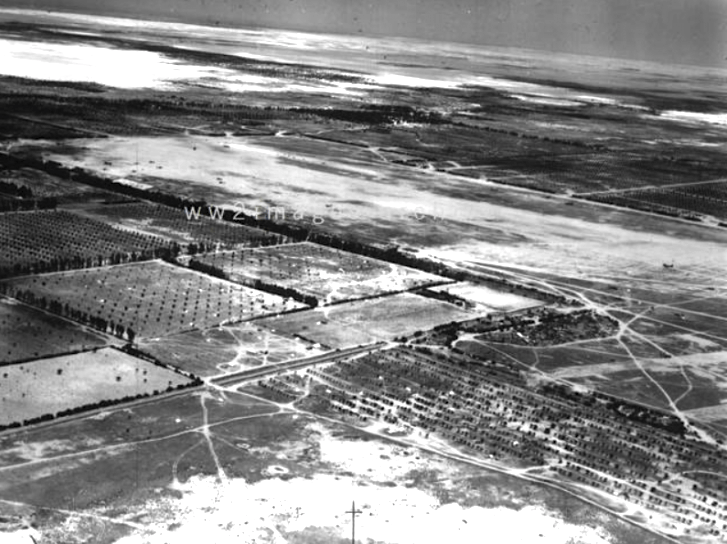
When the allies invaded, the airfield was bombed multiple times. A shot from the bombardier’s camera captured the payload in mid descent.

The Allied air forces found a regular shaped landing ground, surrounded by avenues of eucalyptus trees and olive grows. The neat white buildings of the permanent quarters were laid out like a garden city with swimming pools and a watchtower as well as well equipped hangers. When the made a last minute attempt to disable the landing ground by plowing it up, RAF fighters forced them to abandon their work in a hail of bullets, and bombed the aircraft hangers.

Somehow, 200 aircraft, many in good condition were left behind by the enemy, along with undamaged housing. Thus RAF Castel Benito became an important hub for traffic beyond the Mediterranean in a region now fraught with political tension. Post war, Britain had no wish to inherit another colonial responsibility, on top of those now clamoring for self determination. So Britain worked with the newly formed United Nations to establish a legitimate government with broad support within Libya.

Muhammad Idris, a political and religious leader from the dominant Senussi clan was the logical choice. The Senussis had provided vital support to Montgomery’s Eighth Army. Idris wanted good relations and therefore economic development from the West. Britain’s strategy involved expanding the RAF presence at its outpost in Libya, while negotiating a program of withdrawal that protected British interests in the region.This letter
This declassified US document (711. 56373/11–1550) reflects British intentions and the complexity of the task.
The Director of the Office of African Affairs (Bourgerie) to the First Secretary of the Embassy in the United Kingdom (Palmer)
TOP SECRET
Dear Joe: Our reply to your letters of October 23 and November 151 concerning Wheelus Field has been withheld pending the despatch of Secretary Acheson’s letter of December 5 to Secretary Marshall2 on this subject. A copy of the Secretary’s letter is enclosed for your information.
The possibility of the Air Force wanting to use Castel Benito has been decided in the affirmative and hence our top secret telegram No. 2884 of December 4 to you.3 We await the British reaction with interest. We realize that the situation at Castel Benito may be complicated (as compared to Wheelus Field) by the presence of RAF and/or civil aircraft with whom USAF would become co-users of the field. Air Force has raised no objection to co-usage, so it apparently does not consider the presence of these elements as a bar to obtaining its requirements at Castel Benito. We’ve heard rumors to the effect that certain civil air lines may cease operations at Castel Benito.
In our letter to Secretary Marshall we tried to present impartially the two possible methods of obtaining base rights at Wheelus from the Libyans. George McGhee wants to receive the Defense Department’s views on this subject and you may rest assured that the views reported in your letters will be considered thoroughly in making a decision on this subject. Incidentally, Roger Allen was in town a few days ago and we took occasion to ask him whether the Emir will be in a position by January 1, 1951 or February 1951 to talk business with the British or ourselves on this question of our strategic requirements. Roger said he was recommending to the British Foreign Office that an approach to the Emir should await such time as the permanent Libyan Government is in operation under a final constitution. He feels that security is such in Libya that even the most guarded approach to the Emir would be known too widely in a short time, and that such knowledge of British and/or American negotiations in Libya would have an adverse effect at the next session of the UN, particularly since the establishment of the Libyan state will still be in process. Of course he advocates being prepared with drafts of agreements to be negotiated whenever the UN launches the Libyan state. We were impressed by his views in this regard. Apparently the time for negotiating base rights is not as imminent as we had thought.
In any event we can’t get too excited about details of procedure so long as we’re still groping for an answer to the basic question of how the new Libyan Government’s operations are to be financed while it is getting strength in its legs. It was the consensus of a recent meeting within NEA that we must have more exact knowledge of Libya’s financial position, broken down as between Tripolitania, Cyrenaica and the Fezzan, before we can know the scope of the operation which we and the British may have to finance. In this connection we will also have to find out how much the Air Force is prepared to pay in the future for rental of its facilities in Libya, what their estimated dollar expenditures in Libya are expected to be in 1951, 1952, etc. This is a real project involving concentrated study and we wonder how best to go about it. Any suggestions you may have would be appreciated. We should acquire this knowledge without delay, so that we will be prepared to proceed intelligently with negotiations whenever that becomes possible.
Our reaction in NEA regarding inclusion of Libya in NATO is the same as yours. If you think the Foreign Office is serious about it, we will urgently explore it with other Bureaus of the Department and with the Defense Department.
Sincerely yours,
My father was probably chosen to command RAF Castel Benito because of his experience interacting with civilian and military authorities during his India posting. MI.6 would certainly have been aware of his intelligence duties in both Offlag V1.B and Stalag Luft 3 camps. One endless duty of the commanding officer is paperwork, Here is his signature on the November 1949 Operations Record Book, recording his arrival at Castel Benito.

December station log reflects business as usual. 26 thousand pounds of freight in, 20,000 out. Mail and food supplies would have accounted for much of the 6000 pounds retained. I’m curious about ” loss of tea”. A serious enough loss to merit a Court of Inquiry? Pilferage or a fire? Were the teapots of RAF Castel Benito suddenly empty a month before Christmas? Quickly corrected no doubt.


In Libya, from age 3 to 5, I lived the consummate British child’s colonial experience. I have flashes of memory from those years: a snake which had crawled up the vines through my nursery window was chopped into pieces with a spade before my eyes; another member of the Libyan staff, kept a scorpion in a matchbox, and as a party trick would entice it to crawl up his bare arm and back into confinement in front of anxious but delighted guests; I recall being head butted by a neighbor’s pet ram and knocked to the ground. I remember my parents eating couscous with an Arab sheikh on a carpet spread under the trees of an orange grove, a member of his entourage placing me on his lap onto a saddle atop a stallion for a gentle circuit of the grove. On this occasion, the sheikh presented my father with an Italian-made roulette set, which I still possess. Before we departed from Libya, I had begun to speak English with an Italian intonation, because of the number of hours I spent with my Italian nanny, Sandra. These memories are not unlike those J.R.R. Tolkien reported of his earliest years in Bloemfontein, South Africa over half a century earlier, nor, I suspect, of countless thousands of British children abroad. The contrast between the colonial and subsequent British experience was inherently dramatic, I think, setting off a rich imaginative life.

One day, my parents had taken me to the top of the Gharyān Plateau, which had a spectacular view of the desert around Benghazi, where battles had raged just five years before. Another awesome sight followed at an abandoned Eighth Army barracks, the Gharyan Lady, painted in engine oil across a 30 foot white wall by American volunteer ambulance driver Cliff Saber.

Initially, Saber painted a nude to amuse his mates. He worked without scaffolding, rotating platforms of army crates, painting six inches from the wall. But standing back to inspect his handiwork, he found that the top outline of her body coincided with the coastal line of North Africa. He decided to turn it into a humorous morale boosting mural celebrating the endurance of the Allied forces.

Saber explained in his memoir: “I marked her off as the Middle East from Tripoli (Lebanon) to Tripoli (Libya) and named parts of her body for nonexistent wadis, the Arabic word for a well: Wadi you hiding? Wadi you doing? Wadi you say? Wadi you know?”

“It makes no claim to being a complete history of the whole desert campaign in North Africa, although it can be used as a reference. Its purpose is to depict the everyday life of Montgomery’s Eighth Army.”
This mural was still in existence in 2013.

I was too young to understand the importance of what had happened below the Gharyan plateau. If the Afrika Korps under Rommel had been able to push through and seize Cairo and the Suez Canal, thereby forcing British oil supplies to take the longer route round Africa, the war would have been seriously prolonged. I have always been fascinated by World War Two, where the issues of right and wrong seemed so clear cut. It was a privilege to remake the Humphrey Bogart WW2 Classic “Sahara” with James Belushi, which premiered on Showtime on 1995 anniversary of the end of WW2 . Here’s a frame from the Messerschmidt strafing the tank.

World War Two was over. The Cold War was beginning.
Extracts from Castel Benito’s log reflect the range of a commanding officer’s responsibilities on a foreign base in the post war period. Soon after he assumed command, my father had to fly back to RAF Odiham for the inquiry into a fatal Vampire crash, or in phlegmatic RAF parlance “ Written off” (damaged beyond repair), that happened 15 February 1949 when my father had been the commanding officer. After a review of available information, this was inquiry’s equally phlegmatic conclusion as to the cause of the accident.
“The aircraft made a low-level high-speed run across the airfield at RAF Odiham, near Basingstoke, Hampshire, and then made a steep climbing roll, entering low cloud at 700 feet agl. The pilot then lost control of the aircraft in the low cloud, and made a very tight turn, resulting in a high-speed stall, with no available altitude in which to recover.”
Pilot error. The hazards of low level aerobatics continued into the jet age. Dealing with fatalities was a CO’s duty. Here’s how he reported the sad death of a Sergeant Anderson in the station log in typically understated terms. But his response was to create a special wake.
“Sergeant Anderson was killed in a motorcycle accident in Tripoli on the night of February 7 during one of the worst storms on record. His wife was living in the married quarters, and was a few weeks away from giving birth. He was buried in the Tripoli cemetery with full military honors. The Royal Artillery Mounted Band arrived unmounted and gave a splendid performance in the station cinema.”
The death of an expectant father had depressed the ex-pat community. Observance of ritual provided some catharsis, and strengthened morale.
Occasionally my father had to preside over disciplinary matters.
“A District Court Martial was held against Gunner 9 Lawrence of 651 Squadron for assault and battery. The sentence was 168 days detention, subject to confirmation.”
RAF Castel Benito was a busy military airport. The volume of freight, mail, passengers in/out is reflected in this December 1949 log:
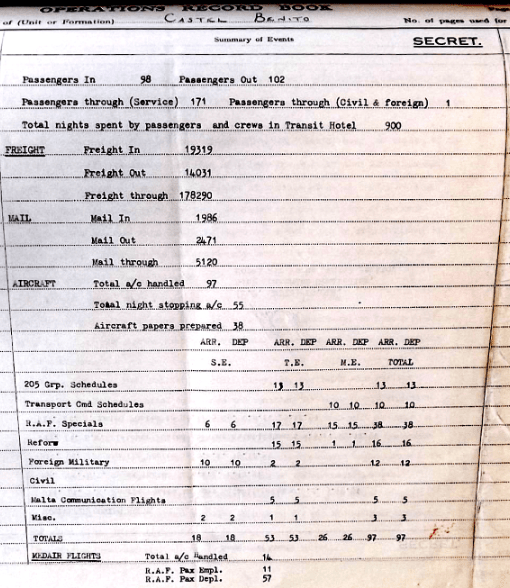
An immediate responsibility once he assumed command was the protection of the base in an environment that was growing increasingly tense. The end of World War Two had unleashed long buried but ever smoldering resentments. Severe anti-Jewish violence erupted in Libya During two days in November 1945, more than 140 Jews, including 36 children, were killed and hundreds injured in a pogrom. Nine synagogues were destroyed, and over 1,000 Jewish properties were plundered in Tripoli alone. Anti-Jewish riots increased after the founding of the State of Israel in 1948. Britain’s tacit support of Israel fueled local protests against the British Mandate in Libya. My father supported the creation of a homeland for Jews, despite his father being a strongly anti semitic, whose will proscribed disinheritance for any son who married a Jew. Anti semitism never took root in my father. The RAF exposed him to a cross section of races and religious denominations. He learned much about the Holocaust in prison camp. It should be noted that During World War II, some 20,000 Jews, 6 percent of the country’s overall Jewish population, served in Britain’s Royal Air Force , of whom 900 gave their lives. The proportion of Jews among those who fought in the Battle of Britain was twice Jews’ proportion in the total population. There was support for Israel within RAF rank and file. British army units were mainly responsible for the protection of Jewish interests in Tripoli, which more than other Libyan cities, was a hotbed of anti Mandate and anti Western sentiment, while it was the RAF’s responsibility to protect the base and adjacent Castel Benito village. What no commander could allow to happen was a repetition of the incident in Palestine in 1947 when extremists were able to infiltrate an RAF base and destroy multiple aircraft. In conjunction with Army units, the RAF initiated regular defense of airfield training.

Castel Benito was ideal for live fire training on the latest fighters. But co-ordinating the RAF side with Royal Army units and Libyan civil authorities was sometimes difficult, prompting as close as my father’s official words came to a terse comment.

Exercises continued yearly. His log for Feb 7th 1951: ” CO returned from Desevoir and gave officers an “illuminating lecture ” on the defense of airfield exercise he had just witnessed three days earlier.” Illuminating. A rare self compliment. Indeed, my father explained things well.

While Britain maintained control over the Libyan desert, it was a good opportunity to test new long range communication equipment in co-operation with the USAF. The tests were part of the US Matador program which officially began in 1952 and ultimately produced the prototype cruise missile. It was slated as a desert rescue exercise. Army units placed transponders in remote areas. The station’s only Avro Anson , the RAF’s reconnaissance workhorse, then flew circuits sending signals to the transponders at various distances, with varying success, as noted here. Do I detect a dry turn of phrase when a test ruling the new equipment “inefficient” and requiring “redesign” is described as “moderately successful”?

The Avro Anson was ideal for this kind of mission.It began life in the mid-1930s as a coastal reconnaissance aircraft, which my father flew early in its service, and tutored pilots for it at, so it would not surprise me his if he accompanied one or more of these test flights, and at some point piloted the plane himself. Although an advanced design when first introduced, rapid improvements in aircraft performance meant that the Anson was outclassed as a multi role fighter bomber. The Avro Anson was slow, cold and noisy and yet “Faithful Annie” is remembered with affection by most of Royal Air Force-trained multi-engined aircrew of World War Two.

After WW2, the Anson’ts role in the Mediterranean was mainly surveillance photography. When my father took a flight over Libya in the “station Anson”, this is what the interior looked like for the crew.

VISITORS
Castel Benito was a busy staging post for the RAF. More than 16,000 pounds of freight arrived. 8 Vampires flew in for a night stop on the 18th and again on the 19th.; an event that was uncommon, hence my father’s confirmation in the log. Where had they been, and on what mission? Where had they been for 24 hours, and on what mission? Was it RAF Aden? An examination of RAF files from this period would give some insight into British foreign policy as it dealt with its colonial entanglements. My mother regularly had to entertain important visitors and their wives, including the Air Chief Marshall Sir Leslie Hollinghurst, the boss of my father’s boss Air Vice Marshall D’Aeth.
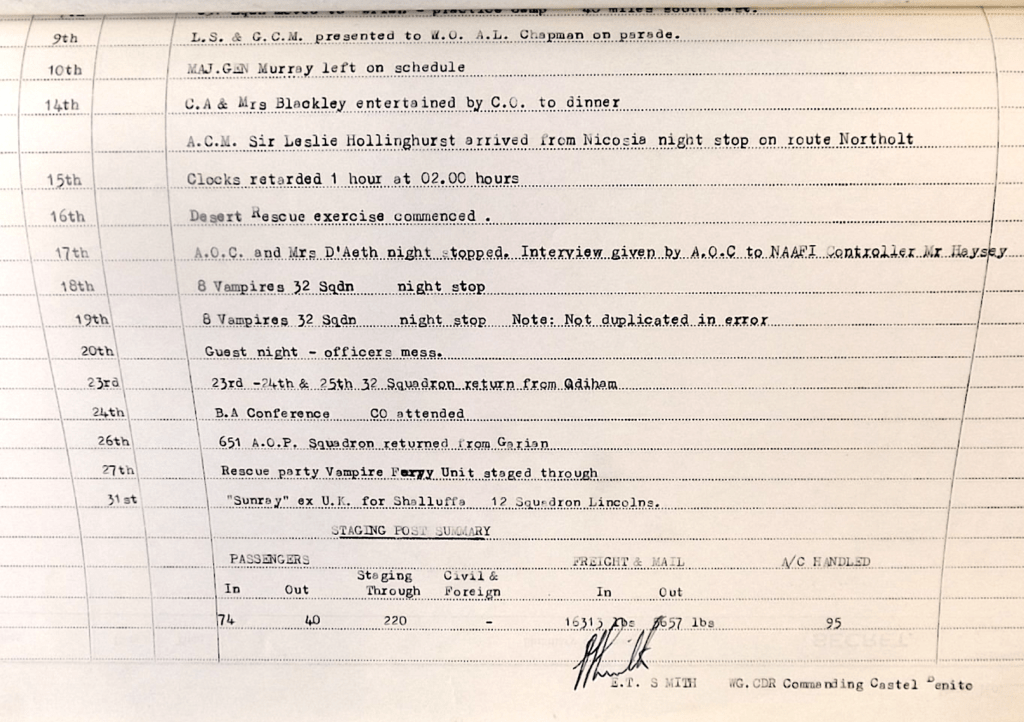
The United States Secretary of State for Air, Mr. Findleter paused at the airfield for three hours.

“ Officer Commanding Castel Benito granted interview” . I wonder what they talked about.
One notable visitor was a hero of aviation. Sir Frank Whittle, seen below wielding a slide rule early in his career, was the pioneer of the jet engine. Now Air Commodore Sir Frank Whittle ( retired) he toured RAF bases presenting the film “Jets”. My father attended his lectures both at the station and the all forces cinema in Tripoli.

They must have met at RAF Cranwell in 1932, where they both spent time as pilot instructors. Whittle probably shared his ideas about jet propulsion , a subject on which he was passionate. His tenacious research bore fruit. Whittle was a brilliant workaholic, putting in frequent 18 hour days. This caused nervous exhaustion on two occasions, ultimately forcing his resignation,. Another blow followed. In 1943 the Air Ministry’ made a decision that deprived him of much of his copyright share when the Ministry took over the project. However the new Attlee government corrected this injustice and had just made an ex-gratia payment of a hundred thousand pounds to Whittle for services to the nation. His visit to Castel Benito was part of a multi base WW2 victory lap for Englandand would have been gratifying to Whittle. As men who loved to fly, my father and Whittle must have had interesting conversations in our house during his visit. I was no doubt briefly presented for visitors when appropriate but I remember little beyond what interested a child; scorpions, snakes, the pet ram next door, and the turkey we were given to fatten up for Christmas dinner, but we did not eat, leaving is fate two years later to our successors. Sir Frank Whittle’ s contribution to aviation is memorialized near RAF Farnborough.

Prior to Whittle’s visit that month, my parents had entertained the officers of the Canadian Imperial Defense College.

At the Royal Palace in Tripoli, my father met the Libyan King designate Emir Senussi, An official picture includes him watching as his superiors shake hands with Senussi. I’m trying to read the expression on his face. as his boss, Air Vice Marshall D’Aeth, speaks to Senussi.

RAF operations in the Mediterranean were under the overall command of Air Vice Marshall D’Aeth. Those who pronounced his name “ De Ath” were corrected to pronounce it “ Deeth”. My mother referred to him privately as Air Vice Marshall Death. On a number of visits he would stay over at our house.
“On 27 May 1950, Air Officer Commanding D’Aeth and wife visited for overnight stay at the base commander’s quarters.”
With a shaded atrium, it was probably the best appointed married housing quarters on the base. Entertaining my father’s boss and other visiting dignitaries was nonetheless a stressful responsibility for my mother. With her culinary expertise, she able to provide guests with a taste of food back home, better than the officer’s mess at least.

She had learn to bake pastry at her finishing school in Belgium. A tasty speciality of hers was vol-au-von; round bit-sized mini pastries full of baked chicken and vegetables. She became an accomplished hostess, which I observed at social gatherings as I grew up. She told me she always had to remember to be deferential to wives of visiting officers senior to her husband. They acquired their sense of rank by osmosis, perhaps; an irritation to my mother, who had experienced social inferiority during much of her childhood. She made a special effort to engage with the wives of junior officers on the base, many of whom were homesick. As the base commander’s wife, she was equally on duty. I got the feeling that my mother and Mrs. D’Aeth and did not connect.
As a transit base, Castel Benito, hosted countless visiting RAF and civil service brass, It was like a tiny international airport. 220 staging through that month. 8 Vampires had overnight stops on consecutive nights. The clarifying note could indicate a mission rather than part of the Desert Rescue exercise.

The US Under Secretary for Air transited through. Station log listed my father as having “an audience”. I wonder what they talked about. Flying enthusiasts talking about their favorite toys, and international affairs perhaps.
On Feb 6th Field Marshall Montgomery visited. The hero of El Alamein inspected the RAF guard of honor. I recall my father commenting years later when we were watching a BBC documentary series on Monty’s victories that he had found Monty “ a little haughty”. Perhaps triggered by desert memories.
Two members of the Royal Family visited RAF Castel Benito.

It seems I was present at the brief visit of the future Queen, but I don’t remember. I did make an appearance at another social junction that was apparently memorable. My parents told me with some amusement of the night when 14 officers and civilians from the Canadian Imperial Defense College came to our house. Awoken by the sound of a party, I came out of my room. The guests turned and looked at the 5 year old and conversation stopped. I uttered something I must have overheard my father say, something that became a family catchphrase, perhaps earlier that day in my mother’s presence while reviewing incoming bills. “The Smiths are going down the bloody drain.” He was probably reacting to costs incurred back in the UK.
On the 9th of April 1951 he attended a Royal Air Force Ball in Malta given in honor of the visiting Princess Elizabeth. She would become Queen the following February upon the death of her father, King George VI.

All twelve attending officers were given one dance each with the Princess. In my father’s case, it was a foxtrot. He recounted that the future Queen was charming and seemed genuinely interested in him, his Australian background, what RAF life was like. Princess Elizabeth herself had served in the Women’s Auxiliary Territorial service as a mechanic and truck driver during the war, and her new husband Prince Philip was a Navy man.
After the dance, Princess Elizabeth sat down with my father, and ordered a glass of Orangeade. When the waiter put the glass down, he spilled a little. My father had been taught always to carry a spare clean handkerchief to a social gathering. He was able immediately to pull it out and mop up the little puddle, softening the embarrassment of the waiter and getting a smile from the Princess. The future Queen continued to ask questions till it was time to dance and converse with the next officer. I have sympathy for the Royal Family. Being on duty, under the microscope, all day, every day, for life, is a taxing job. The Netflix series The Crown is illuminating. The royal diadem is really an iron vise.
My mother recalls joining a group of wives in conversation with Lord Mountbatten, which in fact meant listening to his stories, and entertaining stories they were apparently. He was a charming and witty man, she said. She told me she topped up Mountbatten’s whiskey and soda.
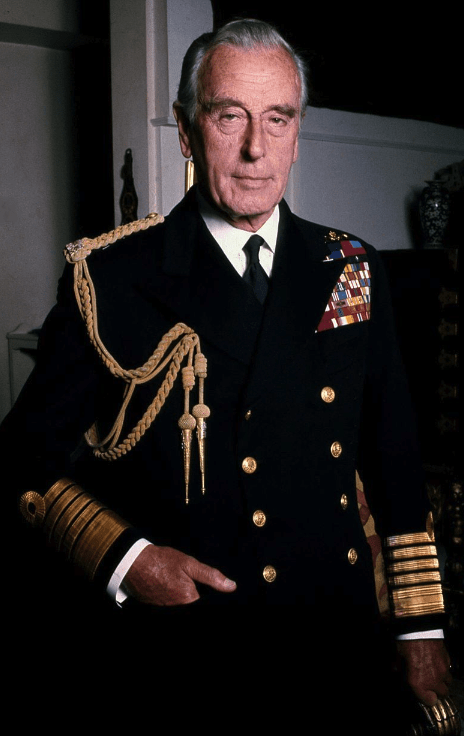
After the Royal visit, the station was focussed on conducting its business in Libya with minimal local impact. Agitation against the British mandate rose during September 1951 resulting in a strike at the telephone exchange.

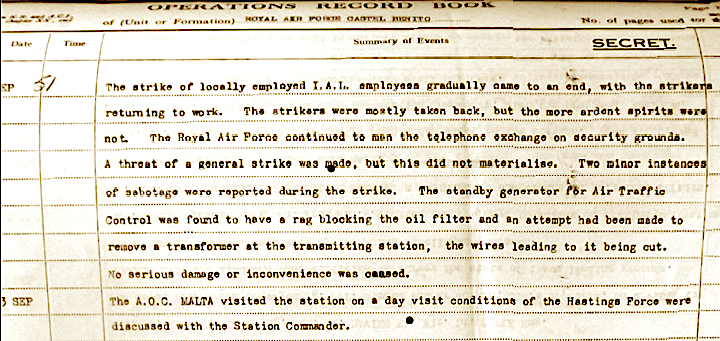
December 1951’s log reflects reaction to increasing Cold War tensions: the question of air raid shelters. 11 Spitfires staged through to strengthen an RAF base in the Far East. There were more political briefings.
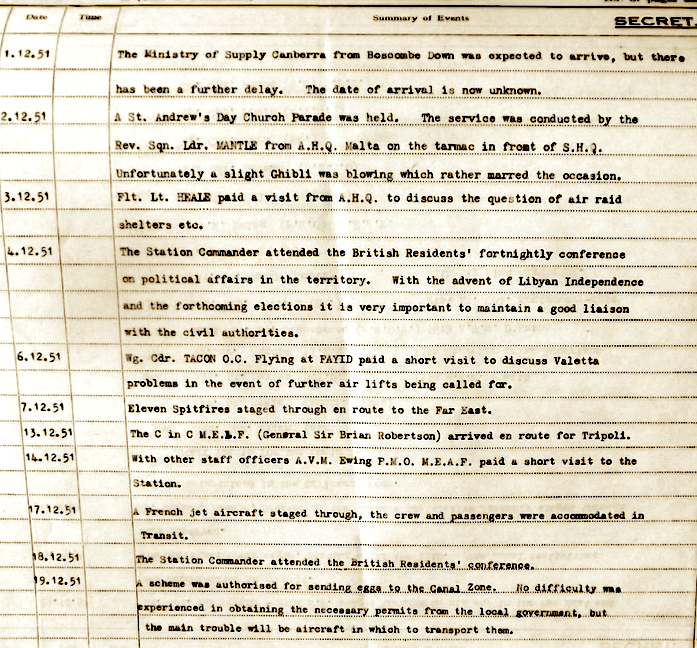
” Valetta problems” referred to the RAF Vickers Valetta C1 transport plane which had become accident prone. In July, A Valetta took off from Lineham in the UK when an engine caught fire. The pilot attempted to return to the airport, but the propeller of the working engine was feathered. The aircraft flew into the ground.
Three crew members and seven trainees on board. There would be 164 fatalities before the Valetta completed its service in 1964. How the ongoing safety investigation since the previous July had impacted on the availability of Valetta C 1s for forthcoming airlift duty was the purpose of Wing Commander Tacon’s visit.
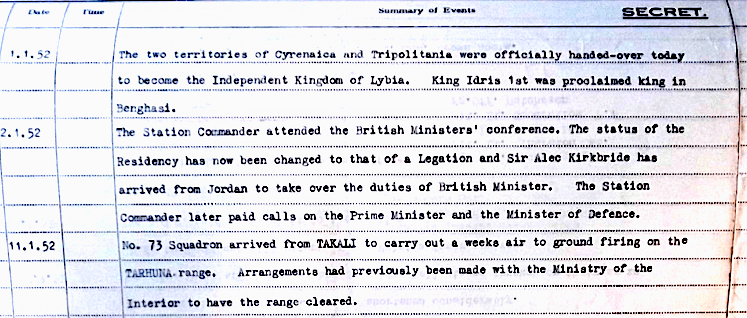
On December 24th 1951, Prince Muhammad Idris bin Muhammad al-Mahdi al Senussi became King Idris of the United Kingdom of Libya, a federal monarchy uniting the previous semi autonomous states under British and French control. Order had to be maintained in a politically volatile climate, and achieved without incident, so that Britain and France could make a smooth exit, and keep Libya pro western; till the Suez crisis, that is. The coronation enabled a date to be set for elections across the new country.

The first few months of 1952 were a critical time in my father’s posting. . A dusk till dawn curfew was imposed on Tripoli. Armed patrols were strengthened. My mother told me that when the mayor of Tripoli made an official visit. our house was surrounded by a ring of security guards. An explosive had been thrown at the mayor the week before, luckily without success.

On February 7th, unexpected news was received from London. The extent of the King’s cancer had not been fully understood by the Palace. It had been considered safe for the heir to the throne Princess Elizabeth to leave the country for an African tour with her husband Prince Philip.
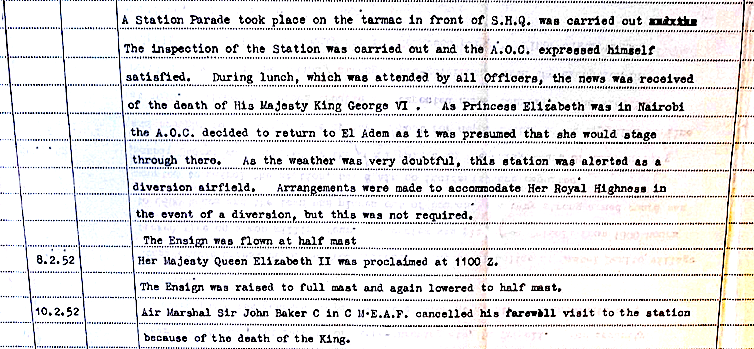
Perhaps the news of British Monarchial change inflamed anti-mandate passions further. There were demonstrations in Tripoli. My father ordered armed patrols to circle the base at night. The day after the election results were announced, a mob assembled in Castel Benito village adjacent to the base and attacked the Libyan police officers on duty, who opened fire, killing four.
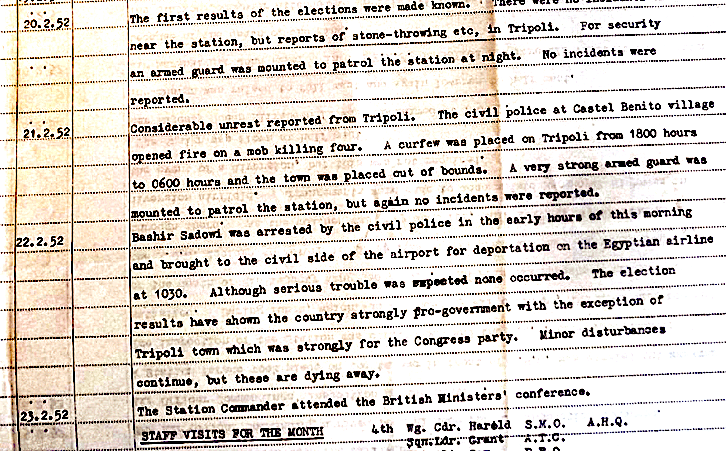
By early March, Tripoli and Castel Benito returned to calm. Tensions had given way to a spirit of optimism for the new country under a traditional leader. My father hosted the French minister to the Libyan government, and the United States Consul General for whom he held a reception on March 25, 52. Security seemed sufficient for the latest Canberra bomber to arrive for ejector seat trials.

Despite being designed as a medium range jet bomber, the Canberra quickly became a key platform in the UK’s intelligence gathering arsenal. Canberra could reach an altitude of 60,000 feet. The space offered by the bomb bay enabled installation of sophisticated radar and imagery collection equipment. My father flew it while it was there. Some lucky pilot tested the new ejector seat, triggered by the red lever.

This British government short film, released in UK Cinemas in 1951 alongside the latest movie, is a hymn of praise to British air power and its important role in maintaining world peace. It contains historic footage of a variety of early jets in flight. With the advantage of hindsight, it also offers an illuminating time capsule of the culture of the time, one in which most British people were firmly indoctrinated.
The last visitor to Castel Benito my father met was British comedian Frankie Howerd, who had become popular on BBC and Forces Radio. Frankie Howerd had been an Army bombardier during the war and was scheduled to be in the first wave of D Day landings , but his ship became stuck off the beach head. He came ashore the next day, and survived the war., developing a sideline as an forces entertainer which he turned into a long successful career.

On April 18. 1952, Wing Commander E.T Smith finished his two years as commander of Castel Benito, and was assigned to a new command back at RAF Odiham. 
The day before we left for England, British comedian Frankie Howerd flew in to perform for the troops.

When he became popular on British television in the 1960’s in the Carry On series, I recall my father saying that his replacement as CO, Wing Commander Dennis, found his act to be “rude and uncouth”.

I am not sure what was so offensive. Perhaps Frankie Howard introduced his gay sense of humor too boldly. Salacious jokes, mockery of officialdom, were a signature of Howerd’s subsequent showbiz persona.. The War had lifted the lid on British class resentments. Along with the aforementioned comedians of Stalag Luft Three’s theater group, Peter Butterworth and Talbot Rothwell, a number of irreverent personalities would spring from the ranks of entertainers at British bases and go on to be stars of film and television, among them Peter Sellers, Spike Milligan, Harry Secombe, originators of the Goon Show. By coincidence in 1973, while working on the promotional campaign for his 1973 horror comedy, I had dinner with Frankie Howerd at London’s Savoy Hotel, along with an Australian millionaire. and his companion former Miss World, Ann Sidney. Hilarious night. Howerd’s flair for sardonic humor was in full flood, but he was careful not to mock the millionaire from whom he might have benefited. When I recounted the night, my parents told me of the fledgling comedian’s early reception. My parents would ultimately enjoy Frankie Howerd’s double entendre laced “Up Pompeii” TV series in my company. His act may not have flown well at RAF Castel Benito in 1952, but it worked throughout his career.
In the final weeks of my father’s two year posting as CO of Castel Benito, he learned from his boss, Air Vice Marshall D’Aeth, that there he was not going to be promoted to Group Captain in the newly slimmed down RAF. He would remain Wing Commander till retirement, eligible with full pension in 1955. Or he could stay on till mandatory retirement age. According to my mother the Air Vice Marshall was not going to recommended him for promotion because he saw my father as part of the old RAF, a snobby, elitist Public School RAF. The new RAF needed to be more egalitarian and make room for younger officers from all strata of society to rise. Nothing in the Castel Benito log points to an incident that could have caused his Commanding Officer’s disfavor. My father spoke very little about this. He just said he didn’t really get on with his CO. Which surprises me, because he always seemed to get on with everybody in my experience. It is ironic that when my father joined an RAF populated by products of the British public school system, his New Zealand accent at the time, a source of jocular mockery, soon evolved into the speech patterns and pronunciation of his peer group. Protective coloration for a colonial wishing to rise through the ranks, which he did. My father believed in advancement through merit rather than birth. So there is a certain irony in this judgement upon my father’s worthiness for promotion to Group Captain. Perhaps a triage of promotions was inevitable in the condensing of the RAF by a cash-strapped government. It is possible, when considering Wing Commanders over 40 years of age for promotion to Group Captain, that the Air Ministry prioritized officers who had served actively throughout the war rather than those who had spent four years in a POW camp. But the RAF still had a use for my father.
He returned to his previous RAF Base at Odiham, before taking up his next posting at the Air Ministry in London. My parents bought a house, called Kings Cottage in King’s Street, Odiham, from which he commuted five days a week from Winchfield Station two miles away, the site of the 1949 Vampire crash. He would catch a train at 7 am. Monday to Friday to Waterloo Station, then take a tube to an Air Ministry building in Pall Mall, clocking in before 9. His office was a small room with a desk, a chair, and a phone. But he rarely spent time there. After checking his office for any delivery, he would take the elevator down to a basement corridor which connected underneath Pall Mall to the MI 6 building across the street. Possibly he was selected for this liason position with MI 6, as a result of connections made with MI 9, the intelligence branch tasked with assisting escapes, through the secret radios my father protected in Offlag V1B and Stalag Luft Three. Trust is key in intelligence work.From 1952 he was involved in the logistical management of surveillance flights over Eastern Europe till 1955
The RAF, assisted by the USAF, conducted spy flights over Russia and its allies from the end of WW2. Some backstory is helpful in understanding my father’s small role in this endeavor.
Declassified files at the end of WW2 declared that Russia’s vast landmass and rigidly controlled Iron Curtain borders required surveillance by a long-range, stratospheric reconnaissance aircraft capability, something that was currently lacking in the British military’s inventory. However, prior to the 1950s and unbeknownst to the American military and civilian intelligence agencies, the RAF had been conducting aerial reconnaissance missions into and around the southern part of the Soviet Union to assess military capabilities and potential weapons development. Specially modified photo reconnaissance Mosquito aircraft, which had seen success in the war, were alleged to have operated from RAF Station Habbaniya, Iraq, during the latter months of 1948. During the same period, aerial reconnaissance missions were conducted along the shoreline of the Caspian Sea. Once American counterparts became aware of these missions, an official request was made.
The RAF’s derring-do attitude to conduct such missions and potential willingness to share its findings, set the scene for the period of the 1950’s where the UK would prove its value in conducting such activities in order to understand and answer key intelligence gaps against the Soviet Union. Incumbent US President Harry Truman acknowledged the critical intelligence gaps relating to the Soviet Union, however, he was reluctant to commit either American airmen, or aircraft, to any overflights of the western side of the Soviet Union, in what he considered to be a highly provocative act with serious political repercussions.
In order to side-step these restrictions, the USAF Chief of Staff, General Hoyt Vandenberg, approached Air Chief Marshal Sir William Elliot, head of the British Joint Service Mission in Washington, D.C. to discuss the desire of the senior commanders of the USAF to use RAF personnel and one of its bases to conduct an aerial reconnaissance mission using USAF aircraft, with the range and inflight refueling capability to conduct such a mission deep into the western Soviet Union. Declassified Air Ministry files contain a five page memorandum from the Secretary of State for Air entitled “The Counter-Offensive Against the Soviet Long Range Bomber Force”, written for Churchill, articulating the need to conduct radar reconnaissance missions during peace time. I wonder if this memo might have been a topic of conversation when my father had his “audience” with the US Secretary for State for Air when his plane stopped for 3 hours at Castel Benito?
Churchill wrote back to the Secretary of State for Air stating that “Operation Jiu-Jitsu will be done by us if the Americans cannot be pursuaded (sic) to do it”. On the 21st March 1952, Squadron Leader John Crompton, Flight Lieutenant Rex Sanders and Flight Sergeant Joe Acklam conducted their first special mission which was to fly repeatedly along the Berlin Corridor to gauge the Soviets’ response in this particularity sensitive airspace. The success of the Berlin Corridor mission was enough for senior members of the USAF and RAF to propose deeper penetrating missions. In April 1952, three RB-45C aircraft departed RAF Sculthorpe in Norfolk. Each had a specific route, simultaneously taking in key targets over the Baltics, the areas surrounding Moscow and the central Soviet Union, collecting key details on the Soviet Air Force’s airfields which housed the long-range bombers that were the greatest threat to Britain.
Both my mother and I assumed that when my father went to the Air Ministry each day, he was doing a desk job, managing RAF administrative duties of some kind as Wing Commanders did. Factually correct. My father co-ordinated the RAF elements required for specific missions assigned by MI 6. How much he was involved in facilitating Canberra or U2 spy flights I don’t know. Two months before he died, just before I left on location to shoot Sahara, he said: ” I suppose it’s alright to tell you this, even though I signed the Official Secrets Act, but the Cold War is over, so really it does not matter any more….”
He gave a few details of what he did when away from the Air Ministry office. , other than it was to supervise particular flights . These were sometimes propaganda leaflet drops over Yugoslavia or the parachuting of agents into other Soviet controlled countries. To provide plausible deniability, the US and Britain devised an impudently transparent cover story for the first overflights from UK bases. The USAF provided four RB-45C Tornado to the RAF.

The RAF painted them in RAF colors. American-trained RAF crews flew the missions.. If one was forced down in the Soviet Union, the US would point to the British insignia and disclaim all knowledge, while the British would make it clear that they owned no RB-45 Tornado, so it could not be theirs. Fortunately, the ruse was not put to the test.

As a result, under Operation Ju-jitsu, in July 1951 four aircraft were leased to Britain from the 91st Strategic Reconnaissance Wing to form ‘Special Duties Flight, Sculthorpe’, which conducted missions during the period 1952–54. There were some narrow escapes.
On April 17, 1952, three aircraft were assigned to head for Kyiv from Germany, scheduled to return to Sculthorpe ten hours later. Flying at 36,000 feet they came under antiaircraft fire. Applying full power, they immediately turned and headed for Germany, none too soon, as Soviet night fighters had been dispatched to hunt down his aircraft. Subsequent flights over Ukraine were carried out at 55,000 feet using Canberras. under the codename Project Robin. This website provides excellent analysis of this significant Cold War operation: https://www.key.aero/article/uncovering-robins-secrets

This 1954 photo, the Canberra’s open bomb bay doors reveals the size of the high altitude surveillance camera secured inside.
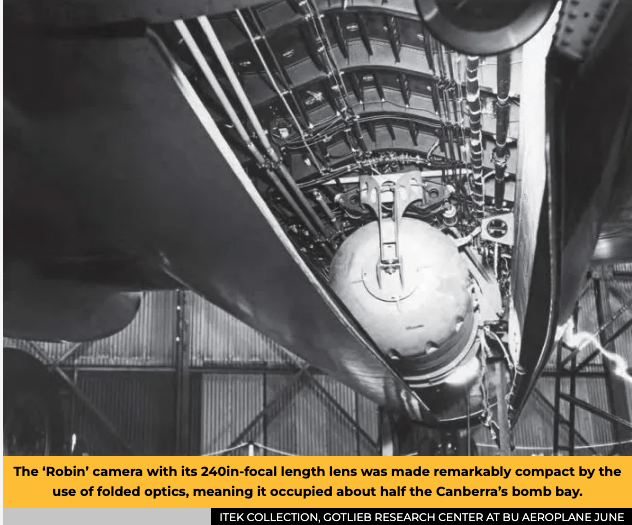
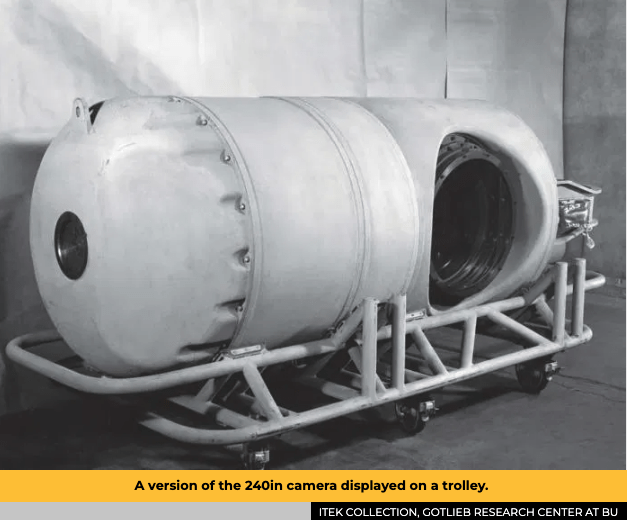
The giant lens pointed towards the ground through a porthole.
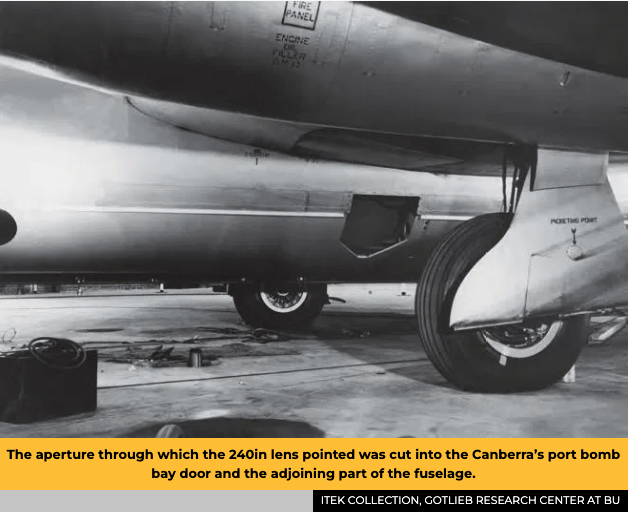
In addition to oblique imagery, overhead shots suggest that the Canberra carried a vertically mounted mapping camera, to record the aircraft’s position when taking images and resolve disputes over its actual position. This appears to be borne out by the frame numbering sequences on individual images, which are significantly different for overhead and oblique shots.
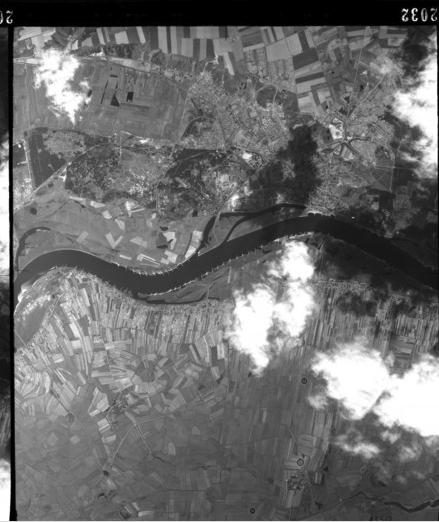
Focus issues appear to have been a significant problem during operational use of the lens. The outcome was several frames of blurred images punctuated with occasional sharp ones. Alternatively, the centre of the image was sharp, becoming increasingly blurred towards the edges. Even though the matter seems never to have been fully resolved, some of the imagery produced was said to be extremely valuable.
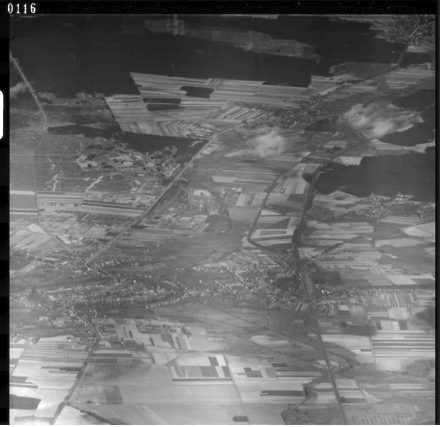
The ‘Robin’ sorties were declassified during 2004 and images released to the NCAP by the Ministry of Defense. They cover parts of Austria, East Germany, Hungary, Egypt, the former Yugoslavia, France, Israel, Lebanon, Palestine and Syria, an extraordinary and little known intelligence achievement.
My father had no involvement in the selection of missions. He was more of roving watchdog. His role was to make sure all elements required by a mission were delivered to the designated airfield and security was protected at the time. Russian agents were undoubtedly trying to track down the British source of these overflights..There were a number of deep cover Russian agents operating in the UK from the 1930’s onwards, and many more after the war, ostensibly as diplomats in the London consulates of Communist countries. Any photographic evidence they could obtain would be used in the propaganda war which was being waged by both sides. British and US propaganda efforts involved leaflet drops over Yugoslavia. The RAF deployed Avro Lancaster and Lincoln bombers. It was my father’s task to ensure that RAF roundels on wings and fuselage of the designated plane were removed before take-off, to prevent a propaganda photo opportunity if the plane crashed or was shot down. He never flew in any of these missions. But flights in several British and American medium and long range bombers featured in his log book. My father had made it his business to catch up on all the planes his time as a POW had prevented him from flying . Pictured is a 460 Squadron (RAAF) Lancaster from the Battle of Britain Memorial Flight in the skies above Lincolnshire.
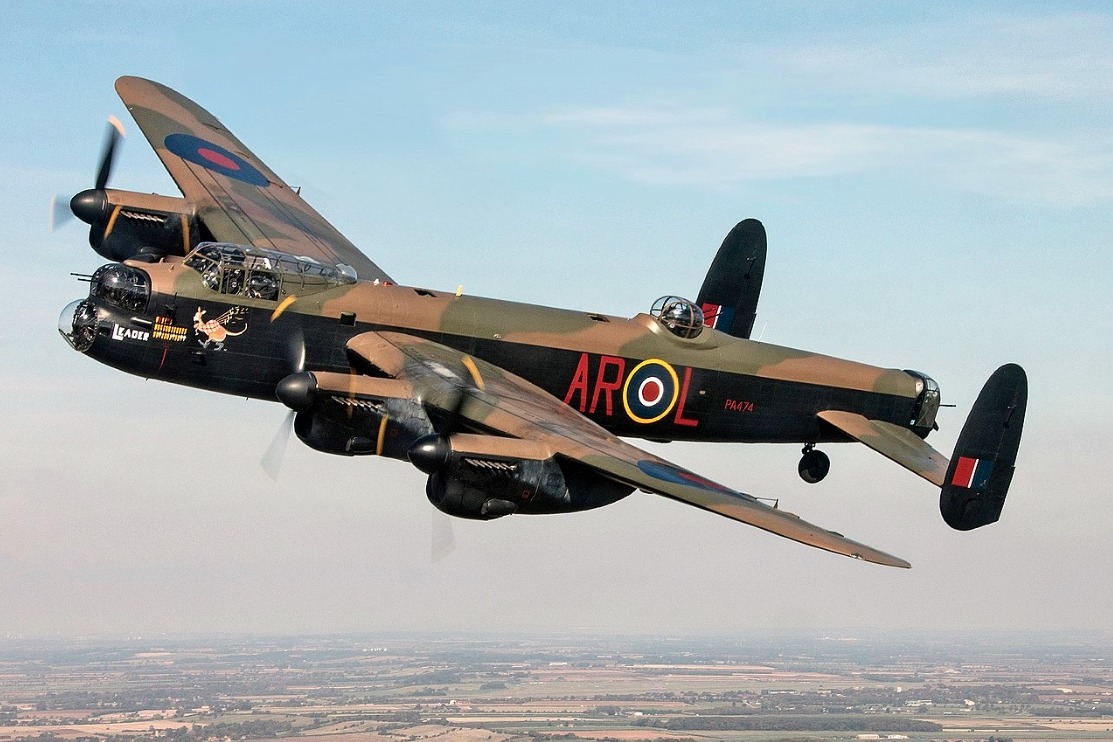
Using de-commissioned aircraft from the bomber fleet would provide plausible deniability, because after 1945, the RAF sold many war-surplus Wellington and Lancaster bombers to other countries to convert into long range transport or passenger aircraft. Although powered by Rolls Royce Merlin engines, any crashed plane without RAF insignia carried no direct RAF fingerprints. Anyone could have chartered it – would be the proffered explanation. My father was privately amused by the subterfuge. An extract from the USAF Rand Research Project memorandum on Air Border Violations gives an indication of the times such flights were detected in the first six months of 1953 alone.

My father was proud to have been part of the machinery of Project Robin. His opportunity to serve the country’s war effort, sidelined by capture early in WW2, had been restored. He never told my mother of the nature of his “Air Ministry” work. I only learned of it two months before his death in 1995, when we had lunch before I left to shoot “Sahara”. He died 4 days after I returned so perhaps he knew his time was running out.
He said ” Well, I suppose I can tell you this now…although I signed the Official Secrets Act but the Berlin Wall’s been down for a while …the Cold War is over… so I suppose it does not matter any more. ”
Sadly the Cold War proved not to be over. Russian expansionism was always ready to resurface, and Western leaders ignored the warning signs for too long.
The Greatest Generation put their lives on the line to defeat a predator authoritarian regime that intended to return Ukraine to Kremlin control and dominate Europe economically . Nazism was soon replaced by Stalinism. The Greatest Generation and its successors managed to keep Russian expansionism more or less at bay until 2012. If Putin had been checked at first aggression in Georgia, the horrors of trench warfare in Europe for the third time in a hundred years would have been avoided. Will the sacrifice of the Greatest Generation have been in vain? Will the next five years see Russia as economically dominant and politically influential over Europe due to President Trump’s reversal of established foreign policy.?
But I want to conclude my father’s story on a positive note. He represented the values that defined his generation. Duty to country, and family. Resolve in the face of adversity. Or in my mother’s words: “You just got on with it.”
In my mid teens, I asked my father if he believed in God. He said he felt that God as defined by religious authorities did not exist. But sending me to Christian schools was the way to give me the best grounding in life. I should decide for myself what I believed. Having a religion was not important, he said, but a man should have a code and stick by it.
When his duties to Project Robin were completed, my father retired from the RAF after 25 years of service, the earliest date at which he qualified for a full pension. Aviation in the jet age was instrument driven. The skies no longer held the fascination for my father that they had in the propeller driven 1930’s. He still enjoyed collecting flights in new planes, to compare their aerodynamic characteristics. His last was in a Vampire at the 1955 Farnborough Air Show. He never piloted a plane again.
He could have continued serving till age 60 if he had wished, in a variety of administrative jobs. But the RAF, in order to thin the ranks, was encouraging officers over 40 to consider the early retirement option while young enough to find an executive position in civilian life. Passed over for promotion, my father was now 45, an age often considered a crossroads in life. With a wife and an eight year old son, it was time to find a new field of endeavor.
To get started he joined a company that was a major manufacturer of tires for British cars, and therefore dependent on the supply of rubber from South Asian plantations,. When the Suez crisis in 1956 closed the canal, all shipping from Asia to the Mediterranean and Atlantic ports had to take the longer way round South Africa causing a breakdown in supply of rubber, and consequently severe financial impact on the company my father had joined six months before. The managing director, another retired officer, had a nervous breakdown and shot himself with his service pistol, my mother told me.
My father decided it was time to fly solo in civilian life. “ You can’t rely on other people or the government, “ I remember him telling me. “ you can only rely on yourself.”
Using the accountancy skills he acquired before joining the RAF, he started his own small business. It was sufficiently successful to send me to a top British public school, Wellington College, where, by coincidence, Roger Bartlett, the leader of the Great Escape, had graduated. Ultimately my father sold the business and retire to play golf in Australia where he and my mother spent the rest of their lives.
EPILOGUE
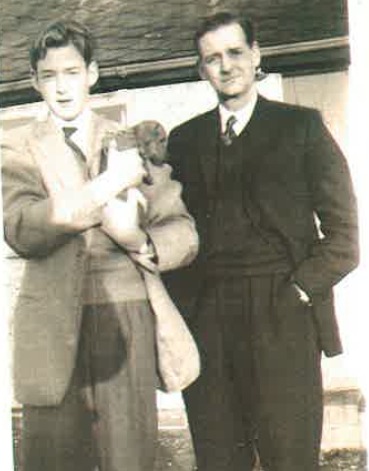
My father’s career advice to his teenage son was to do as he did: Follow your dream. I set out to be a working cog in that global cultural engine – the motion picture industry. My father lived to see his son realize his dream. He participated in Trenchard Productions’ very first film , a one hour TV documentary entitled “The Stuntmen.” Retired Wing Commander Trenchard-Smith became a passenger on the stagecoach hold up and shoot out sequence demonstrating horse stunts. When the film won Best Documentary at the 1973 Sydney Film Festival, I was overseas. My father collected the award for me.

My father’s generation had hopes and dreams before World War Two broke out. But they were prepared to risk their lives to defeat a predator authoritarian regime bent on world domination. Nazism was soon replaced by Stalinism. The greatest generation and its successors managed to keep Russian expansionism more or less at bay until 2014. Yet, Authoritarianism has become popular again, along with a creeping tide of moral relativism. Will the sacrifice of the Greatest Generation have been in vain. Will the next five years see Russia as politically dominant over Europe? It’s time for a New Generation to shoulder the responsibilities of the Greatest Generation and finally bring peace to the world. Though diplomacy rather than war.
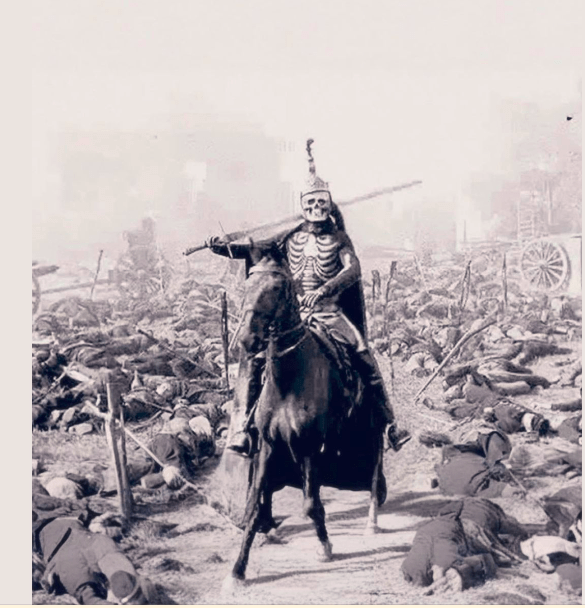
From a 1917 Danish movie PEACE ON EARTH.
